Clifford Browder's Blog, page 39
September 13, 2015
197. 14th Street: from pig ears to Macs, divorce $499, an Art Deco grotto, and Gandhi
At first (and second) glance, 14thStreet in Manhattan has no beauty, no charm, no magic, no storied past, no architectural unity, no anything except two quintessential New York traits: energy and diversity. It is a hodgepodge of building styles, a jumble of noise, justifying itself simply as a useful crosstown artery that helps you get around. Forming a boundary between Chelsea on the north and Greenwich Village on the south, it partakes of neither. Its one redeeming quality is its rough-and-tumble character, its abundance of low-cost stores and restaurants, its appeal to the budget-minded. No gentrification here (not yet, at least); the street is down-to-earth, basic, and unashamedly out for a buck. As one store’s sign put it:
KEEP 14TH STREET GREENBRING MONEY
It’s not surprising, then, that the Greenwich Village Historic District stops just south of it, leaving it without landmark status; preservationists must have thought it a hopeless case, too commercial, too ugly, unworthy of protection.
But if one looks more closely, 14thStreet reveals pockets of beauty, chunks of history, slivers of charm. Let’s take a walk along the stretch I know best, ranging from Ninth Avenue on the west to Union Square on the east, and see what we can find.
On the northwest corner of Ninth Avenue and 14th Street the Apple store looms, a three-story edifice usually topped by a display of giant computer screens. I have trekked there several times, lugging my desktop on a cart, to consult computer "geniuses" about smoothing out computer kinks and exploring computer possibilities. Smiling young faces in blue T-shirts greet you at the entrance and direct you to the appropriate floor -- in my case, the top one, where the geniuses hold forth. Shunning the ultra-modern glass staircase, I take the elevator. Up there in a spacious area flooded with light from huge windows, I’m always the only customer with a cumbersome desktop; everyone else has a small, mobile laptop, so easy to carry about, but with far too small a screen for my purposes, which often require two full pages side by side on the screen.
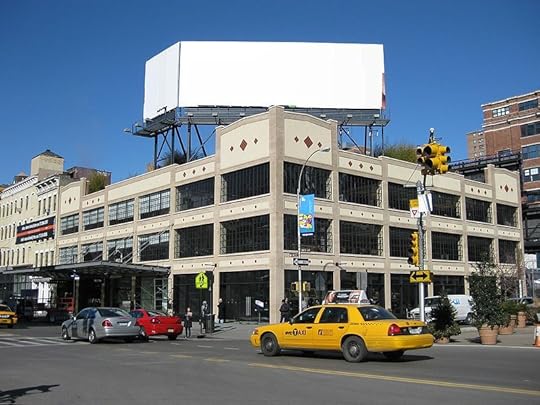 AchimH
AchimHThe Apple store, the third in the city, opened at this location in 2007, but before that this was the gateway to the Meatpacking District, which stretched from here west to the river. The building itself was an outlet for Western Beef, where a former resident remembers seeing open barrels of pig ears and snouts in brine, jugs of pork bellies, and carpet-sized rolls of tripe. So here, right at the start of our trek, is a lesson about life in New York: for all its landmarking endeavors, the city is in constant flux. From pig ears to Macs – quite a change!
Going east from Ninth Avenue toward Eighth, you find mostly residential buildings on the north or uptown side of 14thStreet, some old and some new, their windows sprouting air-conditioners, and, for a sobering touch, a funeral home – all in all, rather dull. But the south side is anything but dull. In quick succession you encounter the following:
· Super Runners Shop· Keratinbar (a hair salon and not, as I at first thought, a karate school)· Centro Mexicano de Nueva York· Gourmet Deli, its doors wide open to the street· Best Chinese Qi Gong Tui Na, offering body work to heal almost anything· Perfect Brows Threading Salon· Chelsea Village Medical Building, where my partner’s doctor holes up, when not making house calls· Istanbul Grill, featuring Mediterranean cuisine· Insomnia Cookies· Rocky’s Brick Oven Pizza and Restaurant
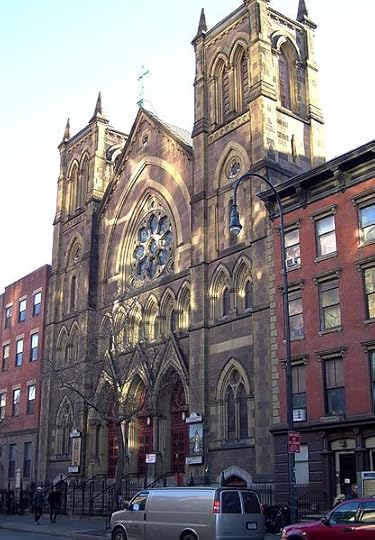 Beyond My Ken But the dominant presence on the block is St. Bernard’s Roman Catholic Church, a towering neo-Gothic dark-stone structure at 330 West 14th Street, dating from 1875. Replete with pointed windows and twin towers topped with short, spiky spires, the church now announces itself bilingually as Nuestra Señora de Guadalupe, or Our Lady of Guadalupe at St. Bernard’s, the two parishes having merged in 2003. (More of this anon.) Once patronized by the Irish in Chelsea, St. Bernard’s saw its attendance dwindle as the Irish moved out. The Archdiocese explained the merger with candor: St. Bernard’s had space but lacked bodies, while Our Lady had bodies but lacked space (and they both had debts). But access to the church is up a steep short flight of steps, since neo-Gothic had little awareness of the handicapped.
Beyond My Ken But the dominant presence on the block is St. Bernard’s Roman Catholic Church, a towering neo-Gothic dark-stone structure at 330 West 14th Street, dating from 1875. Replete with pointed windows and twin towers topped with short, spiky spires, the church now announces itself bilingually as Nuestra Señora de Guadalupe, or Our Lady of Guadalupe at St. Bernard’s, the two parishes having merged in 2003. (More of this anon.) Once patronized by the Irish in Chelsea, St. Bernard’s saw its attendance dwindle as the Irish moved out. The Archdiocese explained the merger with candor: St. Bernard’s had space but lacked bodies, while Our Lady had bodies but lacked space (and they both had debts). But access to the church is up a steep short flight of steps, since neo-Gothic had little awareness of the handicapped.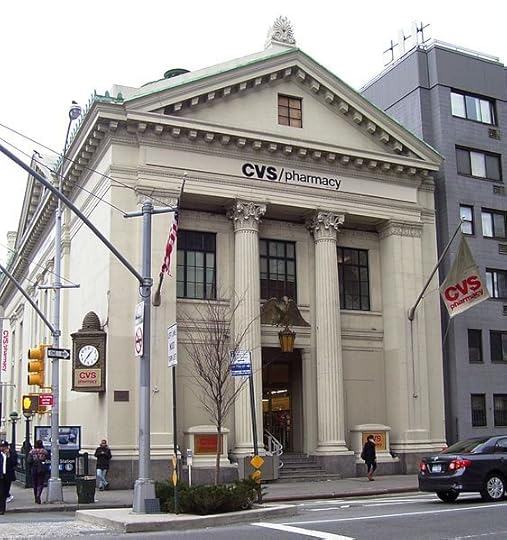 Beyond My Ken At Eighth Avenue and 14thStreet we find two monumental Greek temples whose classical features say “bank.” The copper-domed structure on the northwest corner has a white-marble façade with Corinthian columns. Built in 1897 as the New York Bank for Savings, over the years it underwent a number of changes; served me in one of my bank’s many incarnations; later housed Balducci’s, a legendary Italian grocery in the Village; and is now a CVS pharmacy. One can question whether majestic neoclassical features are appropriate for the intake and output of moneys, but to my mind a grocery or a pharmacy is definitely pushing it.
Beyond My Ken At Eighth Avenue and 14thStreet we find two monumental Greek temples whose classical features say “bank.” The copper-domed structure on the northwest corner has a white-marble façade with Corinthian columns. Built in 1897 as the New York Bank for Savings, over the years it underwent a number of changes; served me in one of my bank’s many incarnations; later housed Balducci’s, a legendary Italian grocery in the Village; and is now a CVS pharmacy. One can question whether majestic neoclassical features are appropriate for the intake and output of moneys, but to my mind a grocery or a pharmacy is definitely pushing it.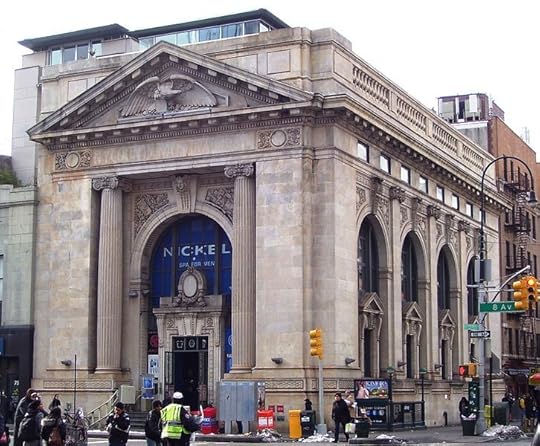 Beyond My Ken Across 14th Street on the southwest corner of the intersection is another impressive Greek temple that likewise suggests a bank. Built in 1907 for the New York County National Bank, it too has suffered a series of incarnations over the years and recently housed a spa for men. If a grocery and a pharmacy are questionable, what can one say of a spa? Flanked by two soaring Corinthian columns, the façade is topped by a pediment with a spreadwinged eagle, presaging laser hair removal on the grand scale, epic pedicures. But that is in the past; the building is now available for lease, with more flux in the offing.
Beyond My Ken Across 14th Street on the southwest corner of the intersection is another impressive Greek temple that likewise suggests a bank. Built in 1907 for the New York County National Bank, it too has suffered a series of incarnations over the years and recently housed a spa for men. If a grocery and a pharmacy are questionable, what can one say of a spa? Flanked by two soaring Corinthian columns, the façade is topped by a pediment with a spreadwinged eagle, presaging laser hair removal on the grand scale, epic pedicures. But that is in the past; the building is now available for lease, with more flux in the offing.Moving east from Eighth Avenue, at no. 229 on the north side of the street, one sees a churchlike façade and, next to it, stairs rising to a parlor-floor entrance. Passing it many times on a bus, I got the impression that this was a nunnery, a religious house sealed off from the bustle of 14th Street and immersed in appropriate devotions. And of course I was wrong. This was, until 2003, the Church of Our Lady of Guadalupe, an 1850 brownstone converted to a Catholic church in 1921 to serve the Spanish-speaking residents of the neighborhood (which had once been known as Little Spain). Its Spanish Baroque façade is rare, probably unique, in the city, and the church’s name commemorates the Virgin of Guadalupe, who appeared to a Mexican peasant in 1531 and has since been much venerated in Mexico.
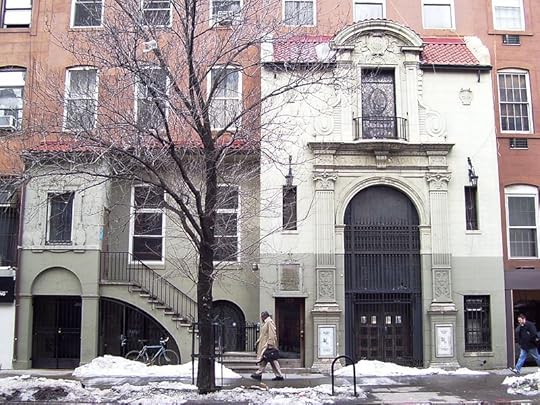 Beyond My Ken
Beyond My KenBy the early 2000s the little church could no longer accommodate the growing population of Mexican immigrants, so in 2003 the parish merged with St. Bernard’s, a short block to the west. But that short block seemed long to many. While the Caribbean Hispanics who worshiped at the little church welcomed having a seat at Mass at St. Bernard’s, many knew they would miss Our Lady’s warmth and intimacy, its unique Latino “feel.” Just as, at St. Bernard’s, some of the elderly non-Hispanic parishioners were likewise grumbling about the necessary change, as the church was refurbished and “Hispanicized” to make the newcomers feel more at home. Bright colors were added, and a painting of the Blessed Virgin of Guadalupe was installed in front of a mosaic portrait of St. Bernard above and behind the main altar. Flux again, pleasing to some and disturbing to others. The abandoned little church is locked up tight now, with a bilingual sign, WE MOVED.
At no. 225, on the north side of West 14thStreet, one finds the 14th Street Framing Gallery, a custom framing shop that shows the works of artists in its window and thus doubles as a gallery. My friend John once took me there to see the paintings of an artist friend of his, Scott Rigelman, who is often displayed there. Though Rigelman also does bucolic scenes and still lifes, what I saw in the window were urban industrial scenes often devoid of people and with a hint of Edward Hopper’s haunting loneliness. Rigelman calls these works “industrial,” but don’t look for workers or machinery in action, just looming buildings, static scenes. John describes his friend’s work as “cool” and “analytic,” as opposed to “emotional” and “romantic,” an appraisal that strikes me as accurate.
Rigelman’s work finds its audience, for in the last several years he has sold some 45 paintings on 14th Street, many of them impulse purchases by patrons who just happened by, though many of them have then become repeat customers who seek his work out at the Framing Gallery. And when the set decorator for the film Learning to Drive walked past and by chance saw Rigelman’s work, he was so taken with it that he acquired two paintings to use in the film. Two of Rigelman’s paintings are currently displayed, both industrial, studies in brown and gray with a touch of dull red, their subdued quality contrasting sharply with paintings by other artists in the window who strive for warmth and color – something for every taste. But who would have thought? Art on West 14thStreet!
Just beyond the Framing Gallery, at no. 219, we leave religion and art behind as we encounter We the People, a self-styled debt-relief agency that proclaims in bold letters
DIVORCE $499INCORPORATIONS $399BANKRUPTCY $499WILLS $199
Bargains indeed. To which their card adds in fancy lettering, “Rest in Peace.”
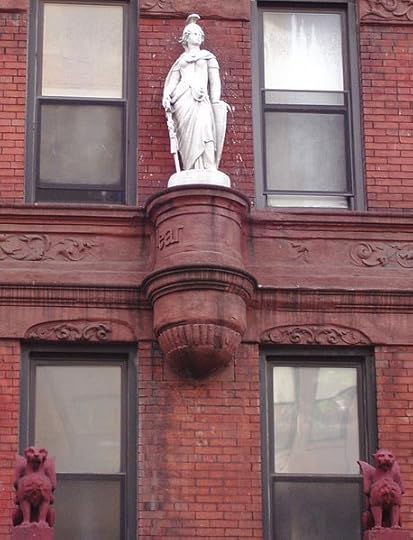 Beyond My Ken On the southwest corner of 14thand Seventh Avenue is a five-story red-brick building built in 1888-89, its front entrance flanked by caryatids and topped by a balcony guarded by griffins. I confess that I have been by it often without noticing the entrance, much less the white stone statue above it, which stands out in sharp relief against the dark red brick and the brownstone trim. The statue, I now learn, is of Joan of Arc, for the building was once known as the Jeanne d’Arc and was favored by French visitors. Another 14th Street surprise.
Beyond My Ken On the southwest corner of 14thand Seventh Avenue is a five-story red-brick building built in 1888-89, its front entrance flanked by caryatids and topped by a balcony guarded by griffins. I confess that I have been by it often without noticing the entrance, much less the white stone statue above it, which stands out in sharp relief against the dark red brick and the brownstone trim. The statue, I now learn, is of Joan of Arc, for the building was once known as the Jeanne d’Arc and was favored by French visitors. Another 14th Street surprise.On the southeast corner of 14thand Seventh Avenue, at no. 154-160, is a 12-story loft building dating from 1912. I have been past that building hundreds of times, and into the second-floor J.P. Morgan Chase branch a dozen times, without ever noticing the lavish polychrome terra-cotta decoration by architect Herman Lee Meader adorning it on many levels, though masked now by scaffolding. Meader had visited Mayan sites in Yucatan (I know those sites), and some see a trace of Mayan influence in the scrolls and wiggles and curlicues of the decoration here. Only recently have I discovered terra cotta in New York and (better late than never) fallen in love with it. Again, who would have thought? Mayan art embellishing J.P. Morgan Chase on brash and bustling West 14th Street! Yet another 14th Street surprise.
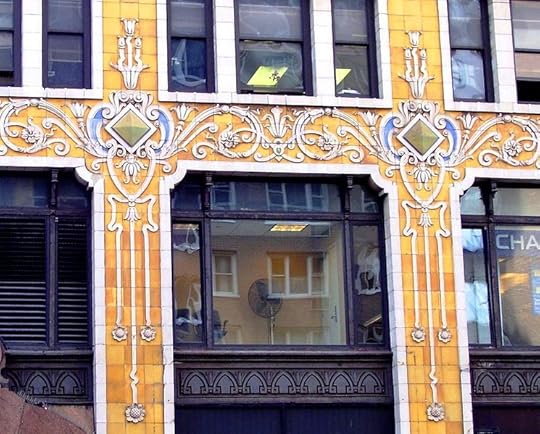 Beyond My Ken
Beyond My KenThe imposing seven-story building at 138-146 West 14th Street, now housing the Manhattan campus of Pratt Institute, is a Renaissance Revival loft building dating from 1895-96. Eight monumental arches frame the windows of the lower floors, while the seventh floor features sixteen smaller arches under a crowning stone cornice. There is rich stone and terra-cotta ornamentation throughout, including palmettes, lion’s heads, and rosettes. This structure introduces a note of grandeur into our walk and definitely redeems 14th Street from the drab commercial hodgepodge it seemed at first to be.
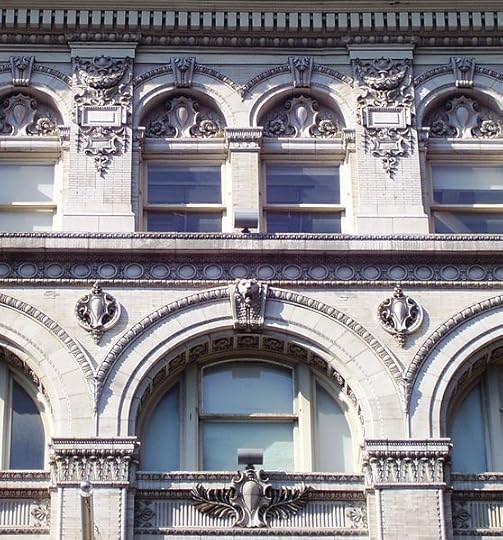 Beyond My Ken
Beyond My Ken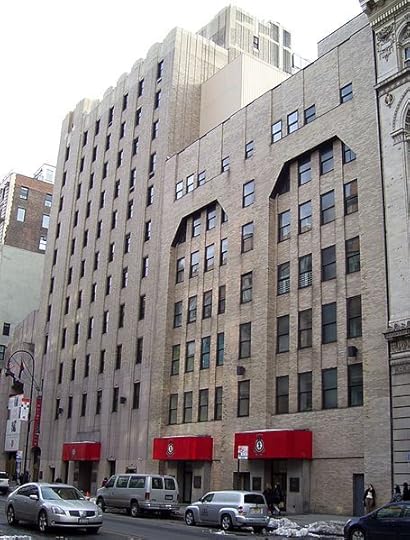 Beyond My Ken More grandeur presents itself at 120-130 West 14th Street, where the Salvation Army’s Territorial Headquarters rises massively, a masterpiece of Art Deco style completed in 1930. I confess to having walked or ridden past it countless times without giving it a wisp of attention until, recently, my growing interest in New York architecture sparked an awareness of it as perhaps the most hugely magnificent structure on 14th Street. The most arresting feature of the asymmetrical three-building complex is the deep grotto-like entrance with a stepped concrete façade with curtain-like folds.
Beyond My Ken More grandeur presents itself at 120-130 West 14th Street, where the Salvation Army’s Territorial Headquarters rises massively, a masterpiece of Art Deco style completed in 1930. I confess to having walked or ridden past it countless times without giving it a wisp of attention until, recently, my growing interest in New York architecture sparked an awareness of it as perhaps the most hugely magnificent structure on 14th Street. The most arresting feature of the asymmetrical three-building complex is the deep grotto-like entrance with a stepped concrete façade with curtain-like folds. Guarding the entrance are great gilt metal gates that seem always to be locked tight shut, sometimes with several homeless people sprawled or huddled in front of them. Peering through the gates, one gets only a glimpse of monumental stairs mounting to the left and right, leading to a spacious interior. Clearly visible on the wall in back of the grotto are the words of the Army’s English founder, William Booth:
While women weep, as they do now, I’ll fight.While men go to prison, in and out,In and out, as they do now, I’ll fight.While there is a drunkard left,While there is a poor lost girl upon the streets,While there remains one dark soul without the light of God,I’ll fight – I’ll fight to the very end.
And on the wall high above those words is the Army’s crest, a circular rising-sun motif topped with a crown and containing the Army’s motto BLOOD AND FIRE, signifying the blood of Jesus and the fire of the Holy Spirit.
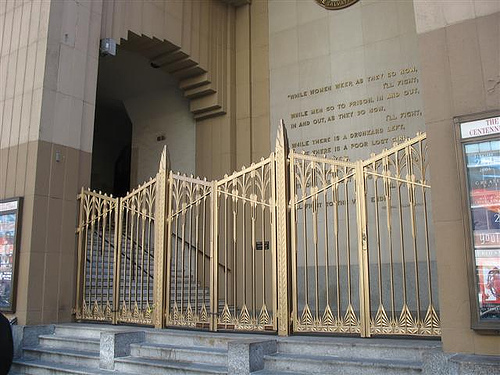
Just across West 14th Street from the Salvation Army complex, at no. 125, looms another massive building of unlovely brick and glass, housing the McBurney YMCA, which moved here from 23rd Street in 2002. Sharing the site above the Y is a residential complex known as Armory Place, its name commemorating the National Guard armory that formerly occupied the site. The McBurney Y prides itself on its famous members. The world of finance was changed forever when Merrill met Lynch in its swimming pool at another site in 1913, and author William Saroyan stayed in a guest room in 1928. Other members have included playwright Edward Albee, artist Andy Warhol, and actor Al Pacino, and the very thought of them all in the pool simultaneously – which probably never happened – thrills me to the quick. A virtual tour of today’s facility shows both sexes running or cycling in place, lying flat on mats lifting heavy weights, playing basketball, and executing slow-motion movements worthy of ballet; one feels sweaty and tired just from watching. Membership includes free towels and WiFi, and free supervised child watch. If the Salvation Army is a quaint and charming – and most necessary – throwback to another age, the McBurney is as tech-savvy and with-it as they come.
On the southeast corner of Fifth Avenue and 14th Street is a new building I love to hate: the New School University Center, a 16-story boxy monstrosity with a skin of horizontal brass bands artificially aged to acquire a “dark golden-brown hue” (they look gray to me), and an “innovative stair system” providing a “grand avenue,” glass-encased, that creeps up the sides of the building, its space meant to provide students with “informal interaction.” I don’t know which I hate more – those horizontal strips or the exposed staircases, the brass or the glass – but I’m sure that the students, without architectural stimulus, will manage plenty of informal interaction on their own. Granted, the building is innovative and eye-catching, and far from dull. But I still detest it, and it’s good to have something to detest; it keeps you from getting bland.
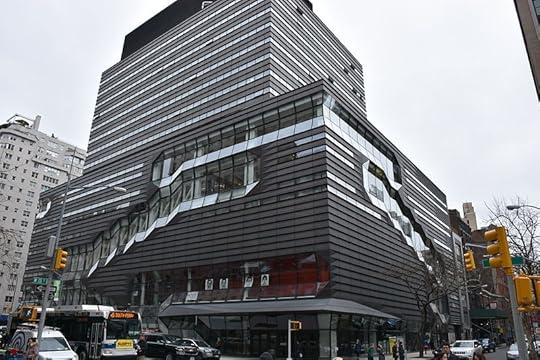 MusikAnimal
MusikAnimalFinally we come to Union Square, whose name, by the way, has nothing to do with the massive pro-Union rallies held there at the outbreak of the Civil War, or the countless labor-union rallies held there subsequently; it simply reflects the convergence there of the old Bloomingdale Road (now Broadway) and the Bowery Road (now Fourth Avenue). By the mid-nineteenth century the Square, once a potter’s field, had become an exclusive upper-middle-class residential neighborhood whose homes faced a nicely laid-out park with tree-lined walks and a fountain. By the 1870s, as was always the case in a fast-growing city, the neighborhood was being invaded by commercial enterprises – hotels and pharmacies and pianoforte showrooms – and gentility fled elsewhere.
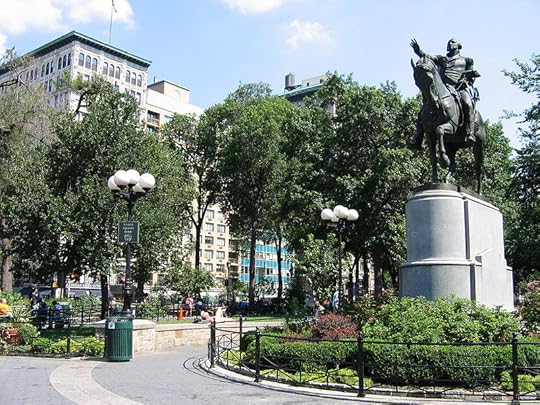 George Washington in Union Square Park.
George Washington in Union Square Park.Aude
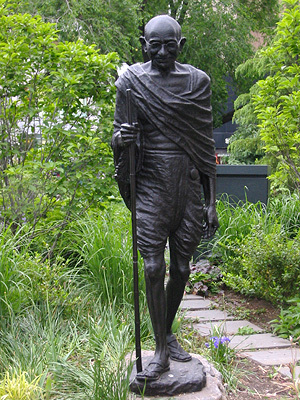 Then and now, Union Square has been the scene of labor-union rallies, and protests and demonstrations of every stripe and hue, including a May Day rally and several Occupy Wall Street demonstrations that I have chronicled in this blog. Also chronicled is the Union Square Greenmarket, the granddaddy of all greenmarkets, which I visit regularly on Wednesdays throughout the year. Frequenting the Square are artists displaying their works (some amusing, some garish); folk singers, some of them more screechy than harmonious; chess players looking for an opponent; a turbaned African-American woman displaying assorted wares on a sumptuous cloth by a fountain; and, newly arrived, a young Hare Krishna devotee with the requisite shaven head and orange robe. Witnessing all the to-do are four bronze statues dedicated to advocates of freedom: a mounted Washington, one arm outstretched, heroically surveying his surroundings since 1856; a nobly posed Abraham Lincoln, dedicated in 1870; a bigger-than-life Lafayette, installed for the 1876 Centennial; and a spectacled and skinny Mahatma Gandhi, who since 1986 has been seen walking with a staff in an enclosed little garden near the southwest corner of the park.
Then and now, Union Square has been the scene of labor-union rallies, and protests and demonstrations of every stripe and hue, including a May Day rally and several Occupy Wall Street demonstrations that I have chronicled in this blog. Also chronicled is the Union Square Greenmarket, the granddaddy of all greenmarkets, which I visit regularly on Wednesdays throughout the year. Frequenting the Square are artists displaying their works (some amusing, some garish); folk singers, some of them more screechy than harmonious; chess players looking for an opponent; a turbaned African-American woman displaying assorted wares on a sumptuous cloth by a fountain; and, newly arrived, a young Hare Krishna devotee with the requisite shaven head and orange robe. Witnessing all the to-do are four bronze statues dedicated to advocates of freedom: a mounted Washington, one arm outstretched, heroically surveying his surroundings since 1856; a nobly posed Abraham Lincoln, dedicated in 1870; a bigger-than-life Lafayette, installed for the 1876 Centennial; and a spectacled and skinny Mahatma Gandhi, who since 1986 has been seen walking with a staff in an enclosed little garden near the southwest corner of the park.Coming soon: New York Hustlers: Elmos and Minny Mice, topless cuties, CD hustlers, fake Buddhist monks, the Naked Cowboy and Cowgirls, and how a wiseguy teenager from the West Side made hundreds of dollars on weekends as an action bowler.
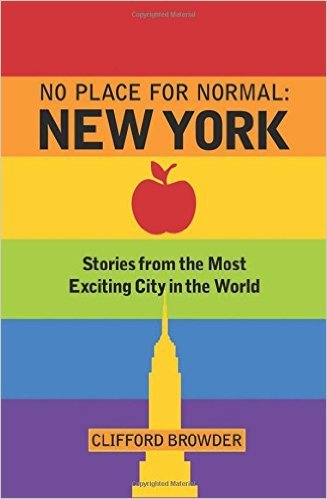
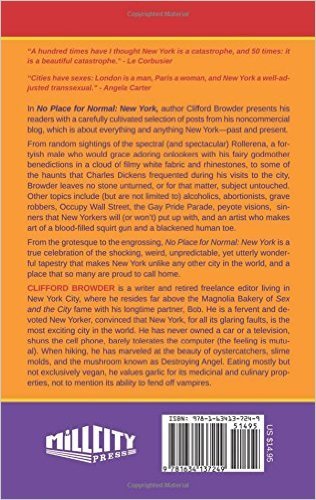


Available now: For a preview of my new book, a collection of posts from this blog, just google the title; the table of contents will give you an idea of what’s in it. Available online from the usual suspects: Amazon, Barnes & Noble, etc. The e-book, now in preparation, will also be available soon. If you go to Amazon and type in the title, you may not find the book, but typing my name will get you to it; Barnes & Noble poses no problem. If you have the preview on your screen, you'll see them both listed on the left; click on either and you'll also find the book. And if the book doesn't interest you, no problem; it will find its readers in time.
© 2015 Clifford Browder
Published on September 13, 2015 04:40
September 6, 2015
196. New York and the Gauls
Officers and crew of an arriving French warship are showered at the dock with tricolor cockades and lusty renditions of the Marseillaise. When, some weeks later, the French ship exchanges gunfire with a British frigate off Sandy Hook, boatloads of watching New Yorkers hail the French victory, and when a whole French fleet then by chance appears, it is greeted at the Battery by thousands of New Yorkers, and women collect linen to make bandages for wounded French sailors. More parades follow, with workers in liberty caps marching arm-in-arm with French officers, coffee house toasts to the French army and navy, more lusty renditions of the Marseillaise, and spirited dancing of the carmagnole, a wild dance danced by Revolutionary mobs in the streets of Paris, including around the guillotine. And all this in a supposedly neutral U.S., while the French and British fight it out abroad.
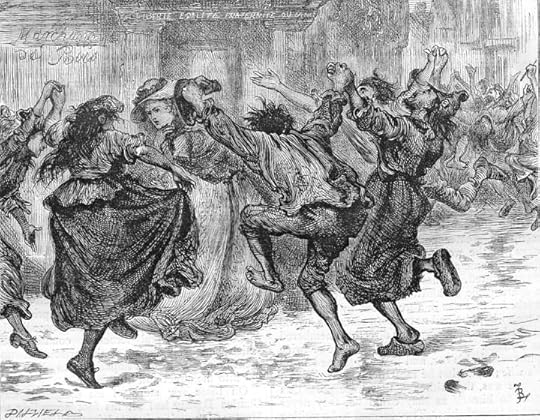 The carmagnole, as imagined by a Victorian illustrator of Dickens's A Tale of Two Cities, 1870. A respectable English lady is surrounded by wild dancers embodying what Tennyson called "the red
The carmagnole, as imagined by a Victorian illustrator of Dickens's A Tale of Two Cities, 1870. A respectable English lady is surrounded by wild dancers embodying what Tennyson called "the redfool fury of the Seine." Many Americans of the 1790s saw it differently.
Nor does fashionable society hold aloof. The most refined ladies and gentlemen bandy about French expressions and develop a taste for French food, French music, and French mattresses. (The latter bears looking into.) Boarding houses become pensions and fancy taverns restaurants (a new word imported from France), wives appear in low-cut gowns and gauzed coifs à la française, and husbands reject powdered wigs, knee britches, and shoe buckles – so old hat and deplorably ancien régime – for daringly revolutionary pantaloons. Regardless of official neutrality, in New York City liberty, equality, and fraternity are most definitely in.
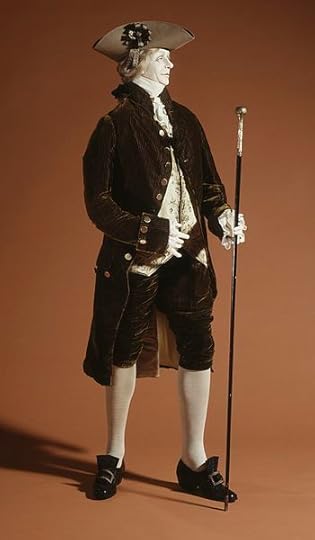 Old style.
Old style.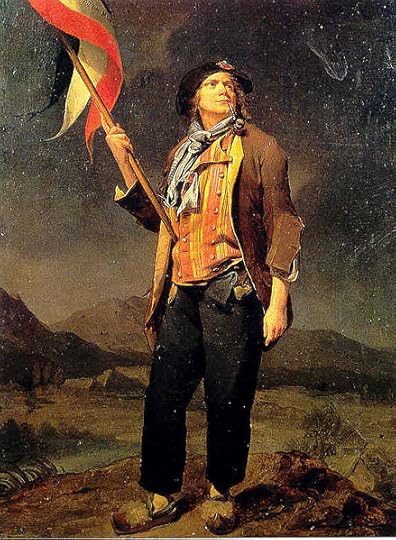 New style. Such was the Gallomania that raged in this city in 1793-95, when the newly hatched Democratic-Republican Party (now the Democratic Party) espoused the principles of the new French Republic, while the conservative Federalists – now on the defensive in New York – deplored the excesses of Robespierre & Co. and maneuvered to avoid another war with Great Britain.
New style. Such was the Gallomania that raged in this city in 1793-95, when the newly hatched Democratic-Republican Party (now the Democratic Party) espoused the principles of the new French Republic, while the conservative Federalists – now on the defensive in New York – deplored the excesses of Robespierre & Co. and maneuvered to avoid another war with Great Britain.Adding at the time to the French presence in New York were a stream of émigrés whom the turbulent events in France had driven to these more tranquil shores: Bourbon loyalists, constitutional monarchists, and republicans – a bit of a political hodgepodge, but all of them fearful of Madame la Guillotine. Among them were assorted aristocrats; Charles Maurice de Talleyrand-Périgord, not yet the skillful diplomat who would serve so many regimes; the author Chateaubriand; and Prince Louis Philippe of the junior Bourbon line and a future king of France. A colorful bunch, many of whom, to earn their living in exile, were soon reduced to teaching French or dancing or music or fencing, or becoming jewelers, furniture makers, booksellers, watchmakers, and such, an experience that in the long run instilled in most of them a deep yearning for la patrie, no matter who governed it, as long as the guillotine no longer threatened.
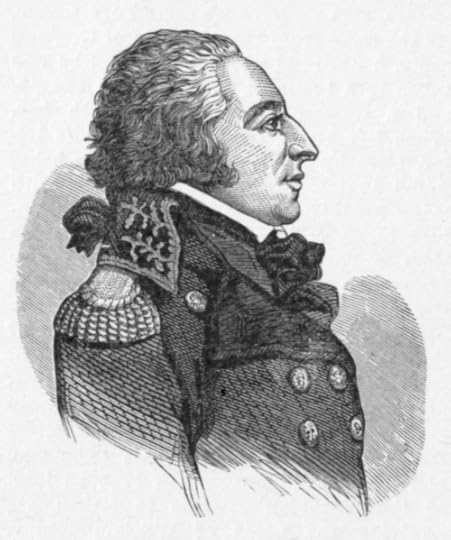 Citizen Genêt. He evidently liked
Citizen Genêt. He evidently likedbeing seen in profile. But one arriving Frenchman – just one – soon made himself less welcome: Edmond Charles Genêt, the Republic’s first ambassador to the U.S., who, having been wined and dined elsewhere, expected a hero’s welcome in the city. Unfortunately, Citizen Genêt had already flouted the nation’s policy of neutrality by commissioning American privateers to prey on British shipping and so prompted President Washington’s cabinet to ask the French government to recall him. He did garner some invitations in New York, but hardly the reception he had hoped for, and when the Jacobins took power in France, they were glad to invite Citizen Genêt back home. Fearing that complying might result in the parting of his head from the rest of him, he wisely applied for, and was granted, asylum here, where he remained for the rest of his republican life, marrying a New York governor’s daughter and becoming a gentleman farmer on an estate overlooking the Hudson River.
Such were Franco-American relations in the mid-1790s, but the French presence in New York went all the way back to the city’s beginnings. Being eager to found a settlement in North America and launch what they hoped would be a vastly profitable commercial enterprise (the New World always induced glowing visions of wealth), in 1624 the Dutch West India Company had managed to enlist for this risky undertaking a group of young French-speaking Walloons of both sexes who, being Huguenot exiles from the Spanish Netherlands (now Belgium), were uprooted and desperate enough to leave the comforts of Amsterdam for the rigors of a distant wilderness named Manhattan. So right here from the start, long before the Anglophones arrived in force, were the French. Or at least, French-speaking Walloons from just north of what was then, and now still is, la Belle France. Coming here as fugitives from religious persecution in another country, they established a pattern that would be repeated often in the city’s history.
(An aside: Should Belgium, or at least the half of it inhabited by French-speaking Walloons, be a part of la Belle France? Opinion has always been divided, nor would Belgium, I suspect, split though it is between Walloons and Flemings, care to lose its independence. But General de Gaulle, whose fondness for “les Anglo-Saxons” was well known, reportedly once remarked, “Belgium is a country invented by the British to annoy the French.”)
As New Amsterdam grew and flourished, more Huguenots came from various European countries until, by 1640, they constituted about a fifth of the population. When persecution in France intensified, climaxed by Louis XIV’s revocation of the Edict of Nantes in 1685, more French Huguenots, many of them merchants and skilled craftsmen, arrived in New York and prospered, including refugees from the former Huguenot stronghold of La Rochelle who then founded New Rochelle in what is now Westchester County. And if, by the eighteenth century, the French language was heard less and less in the city, it’s because the French Huguenots had assimilated so successfully that they ceased to exist as an ethnic group; many, in fact, became Anglicans. Score one—tentatively -- for the Brits.
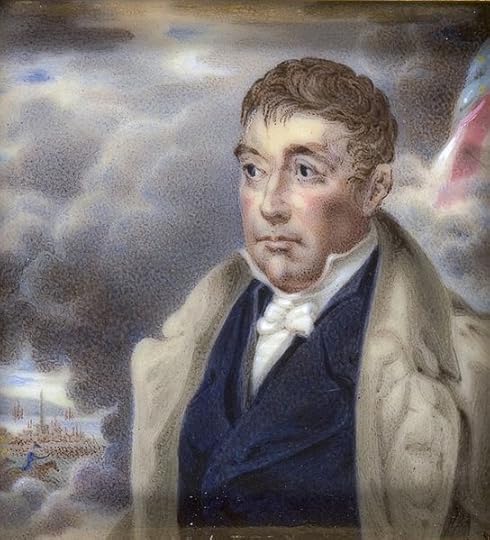 Lafayette, circa 1824. But the arrival of General Lafayette in New York in August 1824 sparked a revival of Gallomania, albeit focused on one individual, the ageing hero of the Revolution in whom many saw a last frail link to the heroic days of Washington and Valley Forge. Thousands of New Yorkers jammed the Battery to greet him as he arrived escorted by a flotilla of steamboats, and mounted buglers led the procession that took him up Broadway, amid cheers and a rain of flowers, to a reception at City Hall. Over the next few days state dinners, receptions, and a visit to the Navy Yard followed, as well as a magnificent reception at Castle Garden where six thousand guests danced until two in the morning. There were also meetings with clergy, militia officers, and delegates from the French Society and the New York Historical Society – this last especially appropriate, since the marquis (a title he had actually renounced) was a walking bit of history, albeit an elderly one and somewhat lame.
Lafayette, circa 1824. But the arrival of General Lafayette in New York in August 1824 sparked a revival of Gallomania, albeit focused on one individual, the ageing hero of the Revolution in whom many saw a last frail link to the heroic days of Washington and Valley Forge. Thousands of New Yorkers jammed the Battery to greet him as he arrived escorted by a flotilla of steamboats, and mounted buglers led the procession that took him up Broadway, amid cheers and a rain of flowers, to a reception at City Hall. Over the next few days state dinners, receptions, and a visit to the Navy Yard followed, as well as a magnificent reception at Castle Garden where six thousand guests danced until two in the morning. There were also meetings with clergy, militia officers, and delegates from the French Society and the New York Historical Society – this last especially appropriate, since the marquis (a title he had actually renounced) was a walking bit of history, albeit an elderly one and somewhat lame. 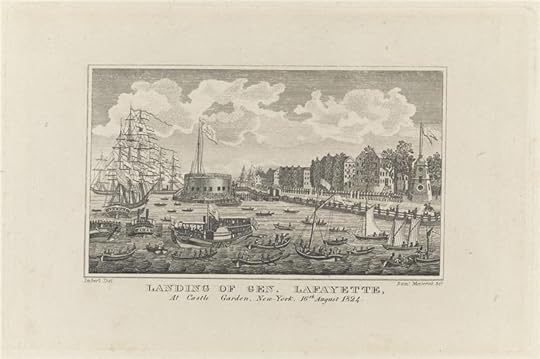
Indeed, one wonders how the frail sixty-seven-year-old survived the patriotic frenzy inspired by his visit – a celebratory frenzy such as he had never experienced in his own country, where monarchists and republicans alike viewed him, a moderate who had advocated a constitutional monarchy, with suspicion. Even more challenging was the thirteen-month tour by stagecoach, canal boat, horseback, and steamboat that took him to all twenty-four states of the Union, in each of which he was received tumultuously with a hero’s welcome. New Yorkers were as greedy as anyone for a piece of the old general, whose image appeared on sashes, badges, gloves, programs, vases, banners, and bowls. Busy with his exhaustive and exhausting tour, during which he met for the last time with white-haired veterans of the Revolution, he was back in New York in July 1825, and in a speech on Independence Day hailed the “prodigious progress of this city.” In September he wound up his tour with a last visit to the capital and left from there for France. He was surely the most popular Frenchman to ever tread these shores; not even Charles Boyer came close.
With the end of the second war with Great Britain in 1815, the port of New York resumed trading with all the major ports in the world, not the least of which was Le Havre. And what came from there? “Fancy goods,” meaning silks, ribbons, laces, gauze scarfs and tassels, pearl buckles, shawls, embroidered bead bags, embroidered silk stockings, and, rushed across the Atlantic by the speedy packet boats of the time, the latest hats and bonnets from the trend-setting modistes of Paris. Obviously, these were luxury items intended for the fashionable women of New York, who each year were the first to learn of, and adopt, the latest Parisian styles. From Britain came such plebeian but necessary items as hammers, nails, scissors, thimbles, pincers, shovels, fishhooks, dustpans, and spittoons, but from France came all the frills and adornments required by the queens of fashion. Serving them were milliners and dressmakers who subscribed to French fashion magazines and maintained correspondents in Paris who sent them dolls dressed in the latest styles; often, to mask their working-class and sometimes Irish origins, they even adopted the fanciest of French names. And so it went throughout the century.
A startling new innovation from France came in 1856, when the Empress Eugénie, the Spanish-born consort of the Emperor Napoleon III, adopted the latest marvel of contemporary technology, the hoopskirt. There were two stories – neither verifiable -- explaining her sudden infatuation with this new contraption: she wanted to hide (1) her bad legs or (2) her pregnancy. In either case she was the queen of contemporary fashion, her portrait displayed in shop windows throughout Europe and North America, and whatever style she adopted, female multitudes were quick to embrace.
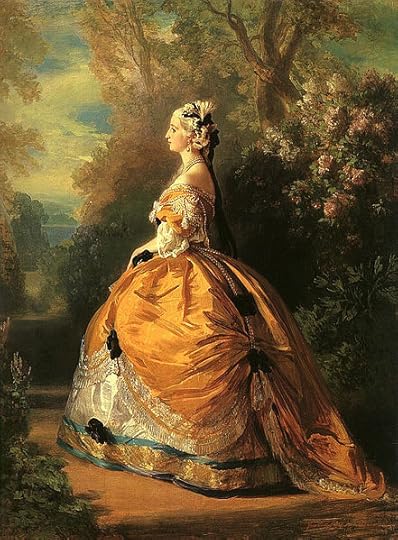 The Empress in the new style, 1854.
The Empress in the new style, 1854.Other names for this new phenomenon were “steel skirts” and “skeleton skirts,” for the hoopskirt was made of flexible steel rings suspended from cloth tapes. Many women hailed its domed magnificence as freeing them from layers of hot and heavy petticoats, for it was lightweight and comfortable, even though its typical three-yard width made negotiating doorways difficult. It was caricatured and satirized at the time, but New York factories were soon producing up to four thousand hoops a day, and even servant girls were tempted to essay the new style, which they saw sumptuously displayed in the Journal des Demoiselles and Les Modes parisiennes. The style prevailed for a good ten years or so, until the Empress decided that it had had its day, and began transitioning to the next new style, the bustle. Eugénie’s influence in fashion persisted even after the collapse of the Second Empire in 1870, which sent her and the Emperor into exile, for when the Panic of 1873 hit New York and prices plunged, New York newspapers featured ads proclaiming “French Empress cloths reduced.”
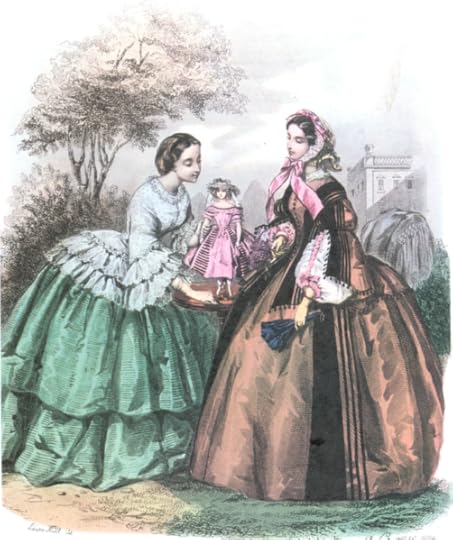 Le Journal des Demoiselles, 1857. Mother, daughter, and doll, all hooped.
Le Journal des Demoiselles, 1857. Mother, daughter, and doll, all hooped.Not all the New York dressmakers were Americans flaunting fancy French names, for the real article flourished here as well, and not without criticism, as seen in the comments of one observer in 1864, quoted in Valentine’s Manual of Old New York, volume 9:
The city is full of harpies from the Rue du Bac and the Chausee [sic] d’Antin – shrivelled, snuffy, toothless old French milliners and dressmakers ‘played out’ in their own country, who have taken ship at Havre and crossed the Atlantic to prey on the credulous and prodigal daughters of the West. You shall rarely walk ten yards along Broadway in its ‘uptown’ section or turn into one of the streets branching from it into Fifth Avenue without coming on a glass full of French bonnets – without seeing those emblems of riotous luxury, perched on stands, in the parlor windows of private houses – or without being made aware through the medium of a flaunting show board, in French, that Madame Harpagon de la Cruchecassee, or Mademoiselle Sangsue [Miss Leech], or Fredegonde, Athalie, Jezebel et Compagnie, Modistes de Paris, dwell on the first or second floor. Beware of Harpagon, she will skin you alive. Avoid Sangsue, she will suck the life blood from you. But the belles of New York will not beware of, will not avoid these snares.
I suspect a bit of bias on the part of the commentator, and seriously doubt that the French milliners and dressmakers of New York were shriveled and toothless; on the contrary, they were probably stylish, attractive, and most accommodating.
It wasn’t just in female fashions that the Second Empire impinged on New Yorkers. In the 1860s the mansard roof became all the rage, causing Greek Revival houses and brownstones to crown themselves with sloping roofs and discreetly protruding dormer windows. The affluent residents of those homes dined often, and lavishly, at the Delmonico’s on 14th Street, where the menu was completely in French, and those deficient in the language of the Franks depended on the obligingness – and the mercy – of the waiters, who glided noiselessly over thick carpets without a hint of flurry or worry.
Meanwhile in the window of Tiffany & Co. on Broadway imports of a different kind had often been displayed: diamonds from the girdle of Marie Antoinette and, at a later date, gems obtained from titled French families fleeing the revolution of 1848. And as this loot came westward to the New World, the New World in exchange exported to Paris its miscreants, as for example Boss Tweed’s cronies in the wake of revelations of colossal fraud in the construction of the new county courthouse. For whenever a New Yorker found it expedient to decamp from Gotham, nothing so lured him as the fleshpots of Paris.
A French import of a different kind was the arrival, in 1876, of the hand and torch of a projected Statue of Liberty, to be seen in Madison Square prior to its display at the centennial of American independence in Philadelphia. This fragment was the forerunner of the whole giant neoclassical statue, the work of sculptor Auguste Bartholi, which a group of French republicans wanted to erect in the United States as a symbol of the ideal republic they hoped to establish in France. And why over here, rather than in France? Because in France the diehard monarchists might vandalize it. So it was destined for Bedloe’s Island, where it would be visible to every vessel arriving in New York harbor. Fundraising proceeded in both France and America, but here, in the wake of the Panic of 1873 and the depression that followed, it proved difficult. “No true patriot,” announced the New York Times, “can countenance any such expenditures for bronze females in the present state of our finances.” (She wasn’t bronze, by the way, but had copper skin with iron supports.) Finally an appeal to the American public brought in a vast number of small donations in the 1880s, and the statue, built in France, was shipped across the Atlantic in crates, and assembled on its pedestal on Bedloe’s Island. In 1886, amid much civic brouhaha, the completed statue was dedicated by President Grover Cleveland.
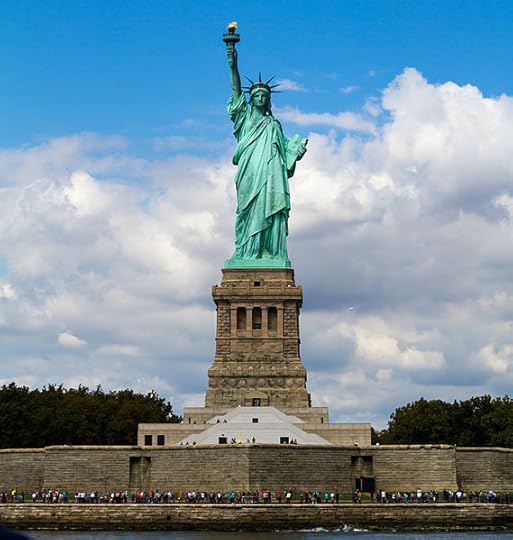 As she stands today.
As she stands today.Andrew Maiman
Now let’s zoom ahead to the twentieth century and a personal note. In 1919, soon after the end of World War I, my mother was sent to Paris by the YWCA to work in the Foyer, a YWCA center offering English classes and other services to young French women. “To be an American in Paris in 1919,” she often told me, “was to be a god.” Our entering the war in 1917, when the French and their British allies were exhausted after years of trench warfare, had brought energy and hope to the Allies, and for this and the victory that followed, the French were profoundly grateful. In her year and a half in Paris my mother, unencumbered by any solid grasp of the language, made many French friends and acquired a taste for France and things French that remained with her all her life. When, in 1940, Paris fell to the Germans and French resistance collapsed, I remember my mother’s dismay, and her concern for French friends living in Paris. When her younger son started grade school, she saw to it that he took French, thus instilling in him a similar taste for things French that in time would take him to France with a Fulbright scholarship, and cause him, an English major, to study French language and literature in graduate school and end up teaching French.
The love affair between the two republics was put to the test in the years following the end of World War II, for France no longer enjoyed the status of a world power, while the U.S. had become one of the two superpowers, confronting the Soviet Union. The result: wounded French pride vs. American arrogance – not the best formula for friendship. And American arrogance was a fact. In a youth hostel in Italy I remember a brash American telling a cultivated young French woman, “France is done, finished, kaput!” – an opinion that struck me then, and still strikes me now, as ignorant, stupid, and naïve. Of course, in the years that followed, General de Gaulle’s towering presence, with his deep distrust of “les Anglo-Saxons,” didn’t help. “I don’t like that guy,” my students often told me, to which I could only answer, “He doesn’t want you to.” But all was not lost: Marilyn Monroe was celebrated over there, just as Brigitte Bardot was hailed over here.
 House of Representatives menu.
House of Representatives menu.leverhart And today? We have survived more ups and downs in the love affair. In 2003, when the French government declined to jump through Bush Junior’s hoop and join in the war in Iraq – a refusal that I cheered at the time – the cafeterias of the House of Representatives stopped serving French fries and served “freedom fries” instead. Just
when Congress seems to have exhausted all possibilities for silliness, it manages to outdo itself again.
In the years before 9/11 I remember hearing a French resident of the U.S. say how exciting it was to live in an adolescent country like this one, as opposed to the more mature nations of Europe. He liked the sense of adventure, the openness to change, the daring – for a cultivated Frenchman, a surprising point of view. What he would say today, in the wake of our response to 9/11 and all that followed, I’d just as soon not know.
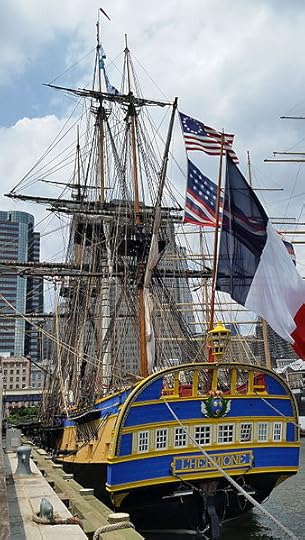 Recent events show that, in spite of all, the love affair persists. Early last July a replica of the Hermione, the three-masted, 32-gun frigate that brought the twenty-two-year-old Lafayette to these shores in 1780 (his second visit) with news of French support for our Revolution, sailed into New York harbor, fired a round of cannon blasts by way of greeting, and docked at the South Street Seaport. The mission of the vessel and its volunteer costumed crew, including officers in cocked hats and gold-braided jackets, was to reinforce the somewhat shaky Franco-American friendship by a round of visits to East Coast ports. “There are two things the French and the Americans agree on totally,” the ship’s superintendent observed: “D-Day and Lafayette.” An exhibit at the New York Historical Society featured Lafayette and the Hermione, the reincarnation of which led a parade of vessels past the Statue of Liberty on July 4. On board the arriving vessel was a barrel of Hennessy cognac to be auctioned off in New York, the proceeds going to charity. And where is the Hermione today? Back in its home port of Rochefort, with return visits to the U.S. a possibility.
Recent events show that, in spite of all, the love affair persists. Early last July a replica of the Hermione, the three-masted, 32-gun frigate that brought the twenty-two-year-old Lafayette to these shores in 1780 (his second visit) with news of French support for our Revolution, sailed into New York harbor, fired a round of cannon blasts by way of greeting, and docked at the South Street Seaport. The mission of the vessel and its volunteer costumed crew, including officers in cocked hats and gold-braided jackets, was to reinforce the somewhat shaky Franco-American friendship by a round of visits to East Coast ports. “There are two things the French and the Americans agree on totally,” the ship’s superintendent observed: “D-Day and Lafayette.” An exhibit at the New York Historical Society featured Lafayette and the Hermione, the reincarnation of which led a parade of vessels past the Statue of Liberty on July 4. On board the arriving vessel was a barrel of Hennessy cognac to be auctioned off in New York, the proceeds going to charity. And where is the Hermione today? Back in its home port of Rochefort, with return visits to the U.S. a possibility.A further strain on the relationship came with revelations that the American embassy in Paris was packed with eavesdropping equipment focused on President François Hollande and, for a very French touch, his actress girlfriend who discreetly frequents the Élysée Palace but a few doors away from the Embassy. This keyhole peeping drew an outcry from the French press, though French officials, mindful perhaps of France’s own eavesdropping prowess, were inclined to shrug it off. Said a Foreign Ministry spokesman, “If we criticize the States, it’s because we love the States…. We love Lincoln. We love Kennedy. We love Roosevelt and the New Deal. We love the Founding Fathers. We love the creativity. We don’t like the rifle association.” A New Yorker couldn’t have put it any better.
When an American journalist visited the well-preserved trenches of World War I in northern France last year, he recognized that in that war the Germans had better weapons, better soldiers, better generals, better spies, better barbed wire, and vastly better trenches – in short, better everything – and yet, having repelled French attacks for four years, the Germans managed in the end to lose. How? When he asked elderly residents in the area, people whose memories went back to 1918, their answer was always the same: “Les Américains.”
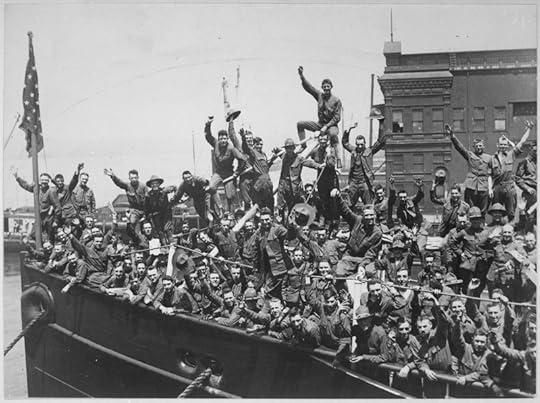 American troops embarked for France, 1917.And recently, when three Americans helped thwart a terrorist attack on a crowded Amsterdam-to-Paris train, thus saving the lives of countless passengers, they received from President Hollande himself France’s highest honor, the Legion of Honor.
American troops embarked for France, 1917.And recently, when three Americans helped thwart a terrorist attack on a crowded Amsterdam-to-Paris train, thus saving the lives of countless passengers, they received from President Hollande himself France’s highest honor, the Legion of Honor.Yes, come what may, the friendship will survive.
Coming soon: 14th Street: from pig ears to Macs, Our Lady of Guadalupe, heroic pedicures, Joan of Arc, Art Deco and terra cotta, how Merrill met Lynch, and a building I love to hate. And after that, New York hustlers.
© 2015 Clifford Browder
Published on September 06, 2015 04:49
August 30, 2015
195. Religion in New York
“We have here Papists, Mennonites and Lutherans among the Dutch and also many Puritans or Independents and many atheists and various other servants of Baal.” So wrote a Dutch citizen of New Amsterdam to officials in Holland in 1655, complaining of the diversity of religious faiths in the colony. He supported Governor Peter Stuyvesant’s attempt to impose the Dutch Reformed faith on the colonists, but the population was too diverse both ethnically and religiously to be made to conform. When the British seized the colony in 1664, they in turn tried to impose the Anglican faith, but with the same result: the city simply could not be made to conform. Right from the start New Amsterdam, and subsequently New York, attracted such a mix of peoples that a policy of mutual tolerance was practiced, with occasional attempts at conformity that never had even a ghost of a chance. Many residents were too busy making money to find time for religion, and those who did find time went their separate ways.
And since then? As of 1990 – the latest comprehensive figures I have access to – the city’s places of worship ranged in number from 471 Baptist, 457 Jewish, 403 Roman Catholic, and 391 Pentecostal at the high end, to 69 Russian Orthodox, 60 Moslem, 40 Greek Orthodox, and finally, at the low end, 3 Quaker and 1 Baha’i. But in the quarter century since, those figures have surely changed, perhaps radically, because, as we shall see, religion in this city is in flux.
Precisely because New York was a place of many faiths – faiths that might squabble among themselves but that didn’t try to wipe each other out -- the city became a place of refuge for the persecuted. New Amsterdam had been founded in 1624 by a group of Huguenot Walloons sponsored by the Dutch West India Company. More Huguenots from the Netherlands and Germany followed, including Peter Minuit, famous for buying the island of Manhattan from the native peoples. By 1650 Huguenots were about a fifth of the settlement’s population, and when, in 1685, Louis XIV revoked the Edict of Nantes, which guaranteed French Protestants certain protections, many more French Huguenots fled the Sun King’s radiating splendor to find sanctuary in New York. So welcoming was the city that the Huguenots assimilated readily; by the eighteenth century, Huguenot merchants numbered among the city’s leaders, and members of the Huguenot community gradually became affiliated with other denominations, especially the Anglican Church. Such is the price of acceptance: loss of identity.
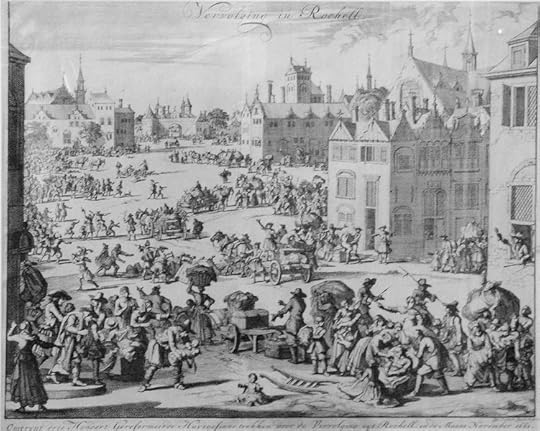 Expulsion of Huguenots from La Rochelle, 1661.
Expulsion of Huguenots from La Rochelle, 1661.World Imaging
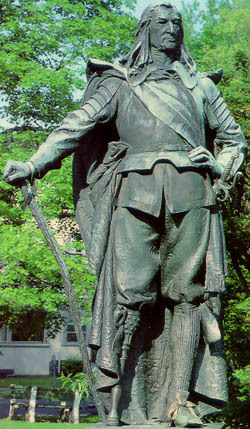 Peter Stuyvesant may have cast a sour glance at the Huguenots, but after all, they had long preceded him to New Amsterdam. But when, in 1654, a group of 23 Sephardic Jews arrived, some of them fleeing the fall of Dutch settlements in Brazil to the Portuguese, he put his gubernatorial foot down: the “deceitful race” were barred from buying land or participating in the citizens’ militia, and were invited to depart. But the Jews’ leaders, knowing their rights under the laws of the Dutch Republic, which guaranteed freedom of religion to all, appealed to authorities in Holland, and Stuyvesant’s superiors reminded him that “each person shall remain free in his religion.” He was further advised that certain influential Jews had invested heavily in the Dutch West India Company, which by itself must have settled the matter: the Governor was told to back off.
Peter Stuyvesant may have cast a sour glance at the Huguenots, but after all, they had long preceded him to New Amsterdam. But when, in 1654, a group of 23 Sephardic Jews arrived, some of them fleeing the fall of Dutch settlements in Brazil to the Portuguese, he put his gubernatorial foot down: the “deceitful race” were barred from buying land or participating in the citizens’ militia, and were invited to depart. But the Jews’ leaders, knowing their rights under the laws of the Dutch Republic, which guaranteed freedom of religion to all, appealed to authorities in Holland, and Stuyvesant’s superiors reminded him that “each person shall remain free in his religion.” He was further advised that certain influential Jews had invested heavily in the Dutch West India Company, which by itself must have settled the matter: the Governor was told to back off.But what really ticked Stuyvesant off was the arrival of English Quakers, likewise fleeing discrimination in their homeland. Their aggressive sermonizing and, when moved by the Holy Spirit, their fits of jiggling or quaking (hence their name), invited his disdain. These oddballs, he decided, were a threat to the peace and stability of the colony, and probably crazy as well. When they persisted despite his disapproval, he forbade the settlement of Vlissingen (today’s Flushing, in Queens) to allow their worship, whereupon the townsfolk, all English, signed a remonstrance to the Governor reminding him that Dutch tolerance extended even to Jews, Turks, and Egyptians, in consequence of which they must respectfully refuse to obey. This Flushing Remonstrance of 1657 is now celebrated as a forerunner of the First Amendment of the Bill of Rights, but Stuyvesant, not being conversant with said Bill, arrested four of the remonstrating townsfolk and clapped two of them in jail for a month. Only the coming of the British in 1664 ended his antics of intolerance.
So much for religious diversity in New Amsterdam; it was there from the start, though not without fitful challenges. Now let’s fast-forward to the twenty-first century and a vast metropolis that has been fed over the centuries by wave after wave of immigrants. What kind of religions are here today? Using the terms loosely, at first glance I’m tempted to divide New York religion into three categories: High Church, Low Church, and No Church, meaning the more formal and traditional, the more informal and upstarty, and the Great Unwashed.
The people I have socialized and worked with in Manhattan are white middle-class professionals – writers, directors, editors, artists, bank employees, teachers, librarians, chefs, and attorneys – who for the most part fall into the category of No Church, or the Great Unwashed. Some of these No Churchers may never have been touched by religion, but most have fallen away, gently or not so gently, from the faith of their childhood. To really know them, you need to know where they’ve come from religiously, culturally, and geographically. Being No Churchers, they’re the ones who, no doubt, create the impression that New York is a secular city devoid of religion – a place, in fact, where people go to lose their religion, if they ever had any in the first place.
My friend Ed was raised a traditional Roman Catholic in Denver, where he served as an altar boy, and then attended a Jesuit university. When he first came to New York he was an observant Catholic who attended Mass and dutifully went to confession. But then, as the years passed, he became less dutiful, began questioning his faith, and finally fell away completely, even to the point of denigrating it with, I’m sure, no small amount of bitterness. If Catholicism left its mark upon him, it was visible, I think, in his courteous, soft-spoken manner, very reserved; he was not one to give himself emotionally, to yield to impulse. Which reminds me of a French friend whom I knew at Lyons when I was studying in France ; he had attended a Catholic collège, rather than the secular secondary school, the lycée, and showed the same well-mannered, soft-spoken reserve. We can leave our childhood faith, but it won’t necessarily leave us.
My friend John, who is proud of his Finnish descent, was raised a Laestadian Lutheran in Minneapolis and was taken by his mother to a church where the service was in Finnish, of which he understood barely a word. He describes Laestadianism as a freakish, fundamentalist branch of Lutheranism that flourished in northern Minnesota. Its aversion to sin and worldliness went so far as to consider going to movies a sin, as well as alcohol consumption, dancing, and women wearing makeup. When he attended the University of Minnesota, where he majored in English and philosophy, he lost his faith, and upon coming to New York he became a full-fledged atheist and remains one to this day. Religion for him is simply a distant and unpleasant memory from his childhood, something he can do quite easily without. But unlike Ed, he feels no biting resentment, no bitterness. As for me, as a child in Evanston I was exposed to a gentle Methodism, quite liberal, that imposed no catechism or ideology, no ban on movies or dancing, but instead inculcated a few basic concepts of morality, the need for understanding and compassion, as exemplified by the story of Jesus, retold every Easter by a talk with slides, and celebrated every Christmas with a well-attended Nativity pageant, superbly dramatic, in which the whole church participated. Even yours truly was involved, musical illiterate though I was, white-garbed and holding my electric candle high, as the triumphant strains of Handel’s Hallelujah Chorus brought the whole attendance to their feet, and the high-school and adult choirs marched down the aisles singing lustily, till our resounding hallelujahs climaxed and closed the performance with a whopping big musical bang.
Because the Methodism I had known was, as I put it, gentle, even in my later – and inevitable – lapsed state, where I felt no immediate need of religion, I nursed no resentment, no bitterness, only warm memories of the Methodists I had known, their principles, their winning love, their faith. At times I ask myself if I have ever encountered anyone who impressed me as being truly spiritual, and always I recall my junior-year Sunday School teacher, Dr. Edmund D. Soper, white-haired and spectacled, soft-voiced, a teacher and scholar with a mellow wisdom. What it was about him that was spiritual I cannot define or describe; it was simply an intangible aura that you sensed. My partner Bob says the same of his mother’s Lutheran pastor in Jersey City, a truly spiritual man such as one rarely encounters today, or perhaps ever.
Only on one other occasion have I personally encountered a truly spiritual human being. While working in the library of the University of San Francisco, a Jesuit school, I heard a talk by Father Martin D’Arcy, the celebrated English Jesuit, a quirky little black-robed man, sharp-featured and ascetic, with a bright eye, a mischievous smile, and a superb sense of humor, and there again I sensed true spirituality. Not in the other priests whom I encountered there – some smooth and clever, some prickly and caustic, some diligent and businesslike – but only in him. His quirkiness was far removed from Dr. Soper’s mellowness, yet they both conveyed spirituality. A rare quality that even the No Churchers have to esteem. If it were less rare, maybe there would be fewer No Churchers. Maybe. And maybe not.
Even if I’m not myself a believer, I respect those who are. Whenever I’m in the Union Square subway station – a huge labyrinth of passageways giving access to any number of subway lines – I give a smile and a friendly wave to the women, often black or Latino, who have a table there with literature and invite people to learn what the Bible really says. They look so committed, and so ignored by the hurrying commuters, that I can’t resist this gesture, which always provokes a warm smile and a friendly wave back. Maybe someday I’ll stop and tell them that I still have the Bible I was given by my mother at age sixteen, a bit decrepit but still usable. (The Bible, not my mother.)
But things aren’t always so simple. When, some years back, I renewed contact by mail with a woman I had dated in junior high and high school, we exchanged several letters and seemed to be beginning a warm and cordial relationship. Living now in Nashville, she told me she attended a Bible-based church and some years ago had experienced a Damascus Road experience similar to that of the apostle Paul. Interested, I asked her to relate it, and finally she did, telling how she had fallen into the blackest of depressions and, desperate, finally surrendered herself to God, following which her depression lifted and she felt a joy like she had never known before.
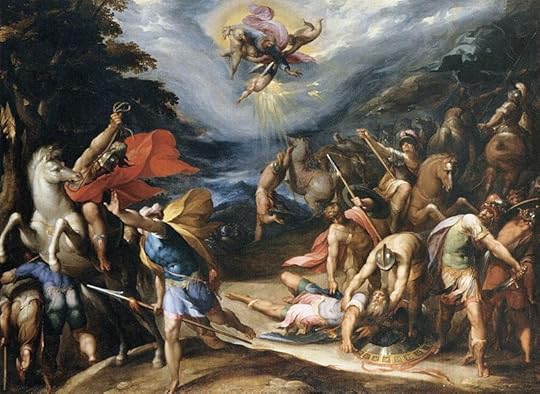 Conversion of Paul on the road to Damascus, a painting by Hans Speckaert, 1570s. Never was
Conversion of Paul on the road to Damascus, a painting by Hans Speckaert, 1570s. Never was a conversion more dramatic or more crowded; no room for quiet contemplation here.
This account fascinated me then and still does now; not for anything would I dismiss lightly or demean in any way what is obviously the most important event in her life. So far, so good. But after that she urged me to give up being gay – as if it were something you could turn on and off at will – and finally she put the question, “What do you do about Jesus?” I replied honestly, “I leave him alone and he leaves me alone. This way we get along fine.” Which ended the relationship; no more letters, nothing, kaput. I truly regret it, but I’m leery of a faith that cuts you off from others; I know several Catholics who share their faith but don’t try to convert me, and we all have a rewarding relationship.
So much for the No Churchers. So what about the High and Low Churchers? In supposedly godless New York they’re all over the place. For instance:
In a former vaudeville theater in the Corona neighborhood of Queens, some six hundred worshipers leap to their feet to join a Latino band in song, shaking their tambourines. Then a preacher gives a fiery sermon and speaks in tongues, and parishioners with tear-streaked faces raise their arms heavenward, eyes shut, in collective rapture. Nothing quiet or meditative here. It is noisy, it is public, it is passionate. And it is definitely Low Church.
 A Pentecostal service.
A Pentecostal service.Peter van der Sluijs
But what is it? It’s the Sunday morning service of the Pentecostal megachurch Aliento de Vida (Breath of Life), founded twelve years ago by the pastor, Victor Tiburcio, and his wife, immigrants from the Dominican Republic. Who are the worshipers? Immigrants from Ecuador and Argentina and El Salvador and Trinidad and Tobago and just about any country in Latin America, some of them legal and some not: ordinary people from the bottom of the social heap who want passion in their services, as well as help in learning English and navigating the complexities, legal and otherwise, of realizing the American dream. So great is the demand for Aliento de Vida’s services, simulcasts are offered by the church’s own TV network.
But this is nothing, compared to the Pentecostal festival in Central Park on July 11 featuring Luis Palau, the “Hispanic Billy Graham,” one of the world’s leading evangelical Christian figures, a gathering that drew 60,000 worshipers – the limit allowed on the Great Lawn -- for the largest evangelical Christian gathering in the city since Billy Graham’s crusade in Queens in 2005. Of the 1700 churches participating, 900 were Hispanic, reflecting the surging growth of immigrant-led churches in the boroughs outside Manhattan. Yet participants weren’t just Hispanic, but Korean-American and African-American as well. The mayor himself was present to offer a few welcoming words and get prayed for, and the crowd danced and cheered and leaped and prayed, and listened to white-haired Luis Palau preaching in shirtsleeves in both English and Spanish, as everyone present expressed the collective joy of being Christian and proud of it. And this in the heart of godless New York! Most definitely and exuberantly Low Church.
 Luis Palau preaching.
Luis Palau preaching.Asociación Luis Palau
If Pentecostalism is sweeping New York and the nation and much of the Third World, gathering new converts by the thousands and tens of thousands, who is losing out? That most High Church of all High Churches, Roman Catholicism. Some years ago the Archdiocese of New York, faced with declining attendance, aging priests, and mounting maintenance costs, initiated a broad reorganization that led to the closing of dozens of churches in the metropolitan region. Thus Our Lady Queen of Angels parish in East Harlem closed in 2007, and its church on East 113th Street was boarded up. But that’s not the end of the story, for a handful of parishioners refused to accept this change, which some denounced as “betrayal” by the Church, and ever since have met on park benches in East Harlem housing projects to sing hymns and join hands in prayer. They do this every Sunday, despite raucous sounds of children playing and dogs yipping nearby, braving the scorching heat of summer and the icy rigors of winter. Yet the closing of this and other parishes in East Harlem is understandable, since the Puerto Ricans who once filled the pews have left for other parts of the city, replaced by Dominicans and Mexicans who are drawn to the storefront Pentecostal churches that have popped up in the area.
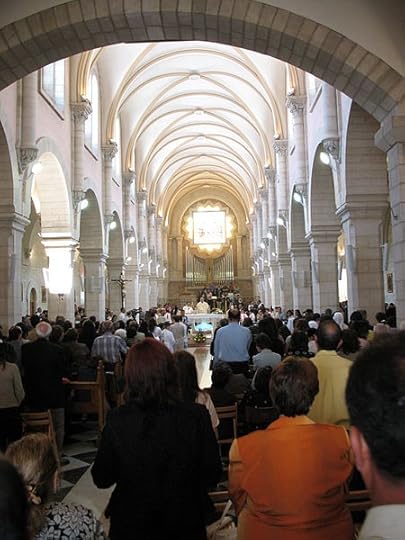 A Roman Catholic Mass. Very High Church, quiet, traditional, dignified.
A Roman Catholic Mass. Very High Church, quiet, traditional, dignified.James Emery And the closings go on. Just recently almost forty Catholic churches were closed in another wave of closings climaxing the biggest overhaul of the diocese in its entire history. At Our Lady of Peace on the Upper East Side, tearful parishioners gathered for a last Mass on Friday, July 31. “This is the beginning of our crucifixion,” said a lifelong member of the congregation, “our Good Friday, the nails driven into the coffin of Our Lady of Peace.” Parishioners of many of the closed parishes have appealed to the Vatican, which will decide their cases after September 1, but in the meantime the archdiocese has denied them any extension that would keep the churches open until the cases are resolved. The mood of gloom and doom contrasts vividly with the exuberant and joyful services of the Pentecostals.
Somewhere between Low Church and No Church are the pagans. Yes, there are pagans in New York City. I used to think of them as weirdos who emerge periodically to celebrate the vernal equinox or some such occasion, half naked or dressed in outlandish outfits, and who then disappear until the next celebration. But they are more organized than that. The Wiccan Family Temple Academy of Pagan Studies at 419 Lafayette Street (between East 4thStreet and Astor Place) offers an introduction to the modern pagan witchcraft religion known as Wicca, with classes in magic, the Greater and Lesser Sabbats, the history of witchcraft, god and goddess archetypes, Shamanism, divination, talismans and amulets, voodoo, the use of spells, and countless other topics. And yes, with the proper training, you can become a witch. But they don’t worship Satan, they simply want to be in tune with nature and its forces.
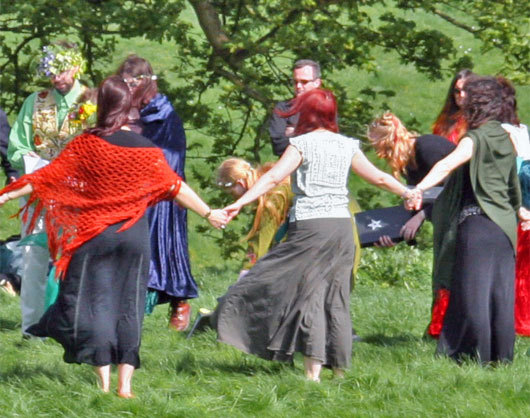 A pagan handfasting ceremony, celebrating a wedding or betrothal.
A pagan handfasting ceremony, celebrating a wedding or betrothal.ShahNai Network And yes, there are self-proclaimed Satanists too, though often they don’t really believe in Satan or worship him. The Satanic Temple, whose founders hail from Boston but through the Internet have proselytized throughout the country, has been called a sharp thorn in the brow of conservative Christianity. They mean to be a counterforce to President George W. Bush’s White House Office of Faith-Based and Community Initiatives, and they do this by launching a religion of Satanism that meets all the Bush administration’s criteria for receiving funds. Their Satanism is really science-based and atheistic, a way of celebrating outsider status, of looking where other people don’t want to look, to find the obscure, the bizarre, the anomalies. But it is often political. If a state allows voluntary prayer in public schools, they propose that Satanic children should be allowed to pray in school… to Satan. And it plans to use the Religious Freedom Restoration Act to oppose abortion waiting periods, arguing that it violates Satanic doctors’ belief in the sanctity of good science. A thorn in the brow of conservative Christianity indeed, but to avoid threats to their families the founders use pseudonyms. With great anticipation I await their intervention here in New York. But I leave it to others to decide whether they should be categorized as Low Church or No Church.
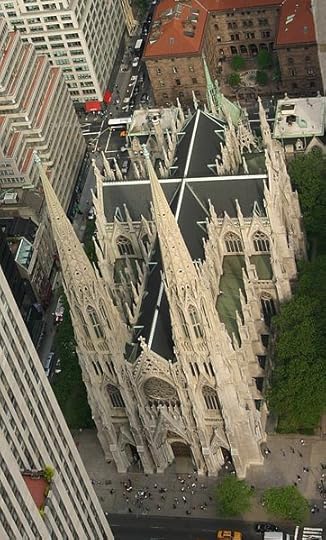 Saint Patrick's, as seen from Rockefeller Center.
Saint Patrick's, as seen from Rockefeller Center.J.M. Luijt
To do justice to my announced theme of religion in New York, I’d have to do a series of posts, a whole book. I haven’t even mentioned Saint Pat’s, the looming Fifth Avenue edifice whose slow beginning in the nineteenth century, with walls rising only as finances permitted, signaled the growing influence of Roman Catholicism in what had hitherto been a WASP city. A prime tourist attraction, it has a souvenir stand inside its sacred walls, which shocks me, a WASP who in his European travels absorbed the notion of the sacredness of Catholic churches, where God is literally present, and souvenir stands are not to be found (not inside, that is, for souvenirs are always to be had). A crypt under the main altar harbors the remains of numerous cardinals and other prominent Catholics, including Archbishop Francis (“Franny” to some) Spellman, whose presence there may or may not be a scandal. (See the much-visited post #136, July 20, 2014).
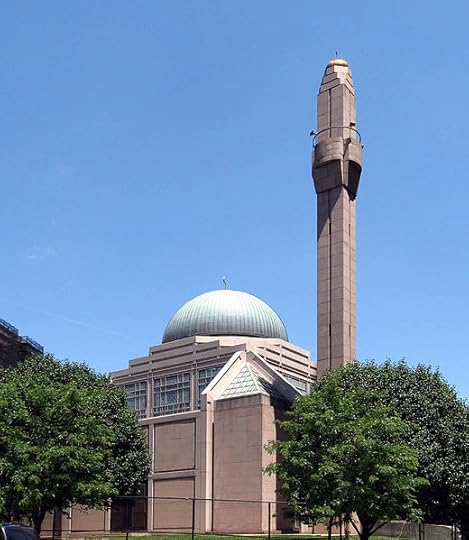

And if you google “places of worship in New York,” you’ll come up with pictures of the Episcopal Cathedral of Saint John the Divine on Amsterdam Avenue near Columbia University; the Islamic Cultural Center of New York at Third Avenue and East 96th Street, its domed mosque overtopped by a towering minaret; various synagogues; and with a little more poking about, the famous Abyssinian Baptist Church in Harlem; the Mahayana Buddhist Temple on Canal Street in Chinatown, with an outsized gold statue of a smiling Buddha, his right hand raised in blessing; and the Saint Nicholas Russian Orthodox Cathedral on East 97th Street, its multiple cupolas topped by crosses. And these are only the biggies; there are smaller sites as well, each with a story to tell.
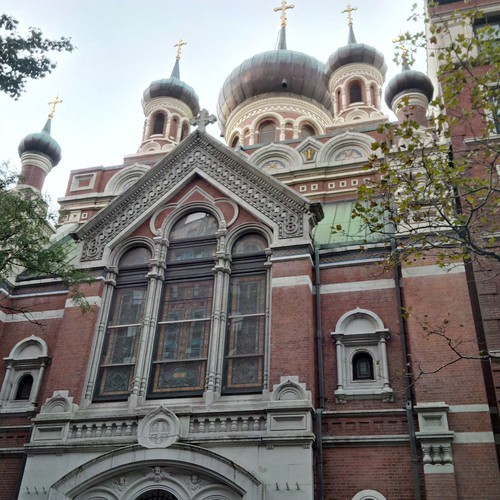
Dazzled by thoughts of minarets, Buddhas, and cross-topped cupolas, I now ask myself what I would most want to see, if visiting an unfamiliar place of worship. The answer comes immediately: I would most want to see something truly holy, something awe-inspiring, something to take me out of myself, something with a touch -- or a punch -- of mystery. And this from a No Churcher!
Coming soon: How New Yorkers spurned powdered wigs and knee britches and took to pantaloons, and the French language preceded English in Manhattan. How fifty thousand New Yorkers -- a third of the city -- turned out to greet a visiting Frenchman (and it wasn't General de Gaulle). Why did the Empress Eugénie adopt the hoopskirt -- what was she trying to hide? And what did Congress have against french fries? All this, and more, under the aegis of the tricolore.
© 2015 Clifford Browder
Published on August 30, 2015 04:24
August 23, 2015
194. Wild New York
A marshy expanse of wetlands where plovers, sandpipers, dowitchers, and yellowlegs scurried across the damp sands at low tide, feeding, while bitterns stood like frozen sentinels, awaiting their prey, and mallard ducks and wild swans glided in the shallows, and eagles and osprey soared overhead, and the skies were darkened in season by migrating flocks of wigeons, oldsquaws, and mergansers. Estuaries teeming with mussels and clams and periwinkles, and oysters in great numbers, some large, some small and sweet, all of them inducing visions of tasty meals. And beyond the shoreline, low hills and towering forests of oak and chestnut and maple with strawberries in the spring, blackberries and raspberries in summer, and in the autumn apples and walnuts and wild grapes. Moving furtively in the brush were deer and wild turkeys, as well as raccoons and otter and quail and, lurking in dark wooded fastnesses, mountain lions and black bears and wolves. The air was clean, the land was lush and green.
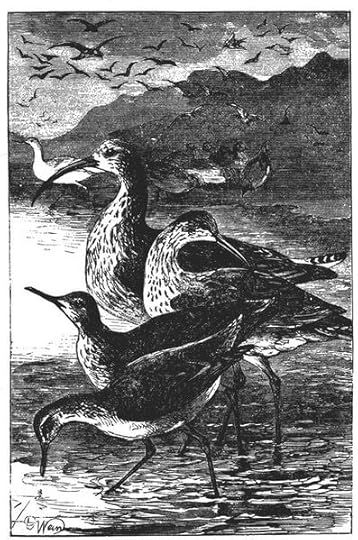
 Arturo de Frias Marques
Arturo de Frias MarquesA glossy ad luring visitors to some distant, unspoiled Eden, a travel agent’s spiel replete with cooked-up, frothy vistas no place on earth could match? No, simply a realistic description of Manhattan in the early 1600s, when the first European settlers arrived.
And today? I’ll spare you the obvious litany of cluttered urban woes, the cliché depiction of a cacophonous wilderness of asphalt, concrete, steel, and cement. But if you look about and look close, you’ll find that, miraculously persisting, there is still a wild New York. And I don’t mean teen-age gangs, madcap cyclists, screeching ambulances, or the naked cowboy or bare-breasted cuties exposing themselves to tourists in hopes of tips in Times Square. I don’t mean homo sapiens sapiens in any form, but real, wild, living creatures.
 jeremy Seto Let’s start with a celebrity predator known to thousands. I mean, of course, Pale Male, a red-tailed hawk whose neck is unusually light in color, giving him his name. He first appeared in the Park in 1991, and since then has nested each spring with his mate of the moment in ornamental stonework high atop a residential building at Fifth Avenue at 74thStreet, just across from Central Park. Pale Male’s marital adventures have always been observed from far below by a throng of eager fans watching anxiously with binoculars and telescopes to see if the young will hatch and survive, as many have done, leaving the nest to reside in Central Park. Pale Male’s consorts have a way of disappearing, often as a result of eating a poisoned pigeon or rat, but Pale Male survives, always taking a new mate that his fans immediately christen: First Love was followed by Chocolate, who was followed by Blue, then Lola, then Lima, then Paula, then Zena, then Octavia, and so it goes.
jeremy Seto Let’s start with a celebrity predator known to thousands. I mean, of course, Pale Male, a red-tailed hawk whose neck is unusually light in color, giving him his name. He first appeared in the Park in 1991, and since then has nested each spring with his mate of the moment in ornamental stonework high atop a residential building at Fifth Avenue at 74thStreet, just across from Central Park. Pale Male’s marital adventures have always been observed from far below by a throng of eager fans watching anxiously with binoculars and telescopes to see if the young will hatch and survive, as many have done, leaving the nest to reside in Central Park. Pale Male’s consorts have a way of disappearing, often as a result of eating a poisoned pigeon or rat, but Pale Male survives, always taking a new mate that his fans immediately christen: First Love was followed by Chocolate, who was followed by Blue, then Lola, then Lima, then Paula, then Zena, then Octavia, and so it goes.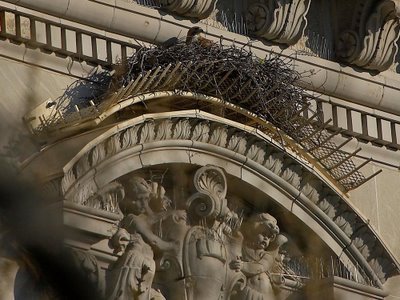 Courtesy of PaleMale.com
Courtesy of PaleMale.comIf I say Pale Male is known to thousands, I’m not exaggerating, for he has been the subject of a one-hour documentary film and a book. An aging stud, he is the first hawk known to have nested in the city, and his fans are fiercely loyal. In December 2004, when the board of the co-op where he nested removed the hawks’ nest and the anti-pigeon spikes anchoring it, their action provoked an international outcry. The Audubon Society and the Central Park birdwatching community protested; TV celebrity Mary Tyler Moore, a resident of the building, joined the protest; the media reported the outrage; and passing automobiles, taxis, and even police cars sounded their horns in solidarity. A compromise was reached, a new cradle for the nest was installed, and the hawks began bringing twigs to the nesting site.
The red-tailed hawk, the common resident broad-winged hawk of this area, is a thick-set bird with a wide, rounded tail; it is often seen soaring in circles high above the city. Seen from below, the tail is dark gray, but if seen from above, it is red, giving the hawk its name. I have seen Pale Male only in film, perched with his mate on his nest, where the scrawny young squirmed and bustled, but I have spotted other red-tails perched in trees in Pelham Bay Park. Red-tails have been known to nest on other tall buildings in the city, though none can match Pale Male for persistence and longevity. That the species nests at all in New York is an amazing feat of adaptation, given the numerous threats to it posed by the urban environment: poisoned prey, aggressively hostile crows, and when the hawks swoop low, risk of collision with passing vehicles.
 A red-tailed hawk.
A red-tailed hawk.Don DeBold Pale Male is the only creature in this area I know of that has attained celebrity status; other denizens of New York habitats creep, skulk, or soar in anonymity. All the big parks harbor a surprising number of species, and Central Park is second to none. Prowling there by day in the spring, I have seen migrating birds by the score and even occasionally by the hundred in a single day, as well as hordes of termites hatching from decaying logs – a sight welcome to birdwatchers, since it brings hungry warblers down to eye level, as they feast on their teeming prey.
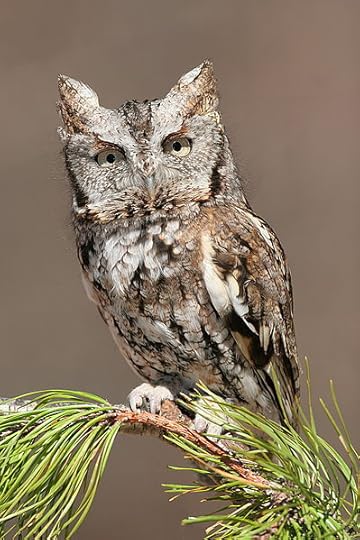 Eastern screech owl. The screech is
Eastern screech owl. The screech is more of a mournful whinny or wail.
Wolfgang Wander But Central Park by night is another story. Years ago, crossing it at night at 72nd Street to attend a poetry workshop on the Upper East Side, I treaded with trepidation, for the city then was rife with crime, streetlamps along my way were few, and my footsteps clicked on the pavement, announcing my presence to any nearby malefactors; the one bit of reassurance was a squad car parked halfway cross the park, Today, however, crime has declined, and venturing into the park at night has become the preferred pastime of a number of hardy and inquisitive souls. A Russian lady in an electric cart comes there nightly to feed peanuts to a bunch of rambunctious raccoons (against park regulations, I’m sure). Owl watchers have a only a precious half hour to spot screech owls, somnolent by day but on the hunt by night, before the gathering darkness renders them invisible. And “mothers” (rhyming “authors”) gather at the Shakespeare Garden to attract moths with a special battery-powered light, so they can marvel at the weird and spectral beauty of these rarely seen nocturnal creatures. (Once, on a tree trunk at High Rock Park on Staten Island, I was privileged to see a sleeping luna moth by day and marveled at its lime-green wings with eyespots and, yes, its weird and spectral beauty.) For all these visitors Central Park by night has a magic all its own, and they revel in its sounds: hoots and rasps of owls, yips of raccoons, and in dead leaves the rustle of white-footed mice.
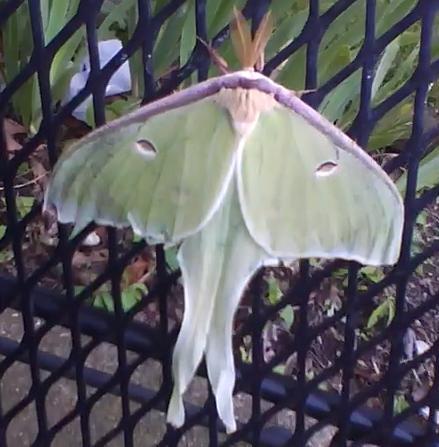 A luna moth.
A luna moth.When not being fed by the Russian lady, Central Park raccoons – there are some 50 of them -- invade the trash cans by night to feed voraciously. Black-masked with striped, bushy tails, they are tough customers that other animals prefer not to mess with. I have seen them sleeping tranquilly by day in trees, but raccoons from Central Park have invaded West Harlem, prowling there by day, crawling over fences from one backyard to another, and even invading homes to the point where terrorized residents have pleaded with the city for help.
 A raccoon, having a meal.
A raccoon, having a meal.Hans HillewaertThese guys also raided a henhouse in Brooklyn and killed all the hens, and even tried to do in the rooster as well. And in September 2014 a raccoon broke into a Bronx beauty shop and ran rings around the cops trying to capture it, leading them a merry chase that onlookers outside watched with amusement, until the officers finally managed to lock the intruder in a cage. These furry creatures thrive now in suburban and urban sites because they are amazingly adaptable and, like people, will eat almost anything. They are not to be messed with casually since, if cornered, they fight viciously, have sharp teeth that bite, and can carry rabies. Exterminators in the area, usually busy eliminating roaches, mice, and bedbugs, now advertise raccoon removal services as well. Yes, right here in New York – aggressive raccoons!
 They do get around.
They do get around.Carsten Volkwein
Less pushy and obstreperous is another Central Park resident, the Virginia opossum, a cat-sized marsupial with a pointy white face that emerges at night to feed on slugs, grasshoppers, caterpillars, snakes, mice, bird eggs, acorns, berries, grass, and dead animals – just about anything smaller and slower than itself. When threatened, this sly character “plays possum” by rolling over in a deathlike trance, eyes closed, tongue protruding, until the threat is gone, at which point the opossum revives miraculously and resumes its slow nocturnal hunt for food.
 Virginia opossum.
Virginia opossum.Drcyrus
Also seen in Central Park at night are at least five species of bats, one of which, the little brown bat, I once saw zoom low over the Loch, a winding watercourse in the North End of the Park. I might have thought it a bird, but there was something weird about its lightning-fast flight over water, and another birdwatcher identified it for me. Had I seen it clinging to a tree, I would have found it eerie, for this long-eared little creature has long, spiky fingers that support the wings, giving it a demonic appearance. Few would call it – or any bat – beautiful, but we should be thankful for their presence, since one bat can eat 500 mosquitoes in an hour.
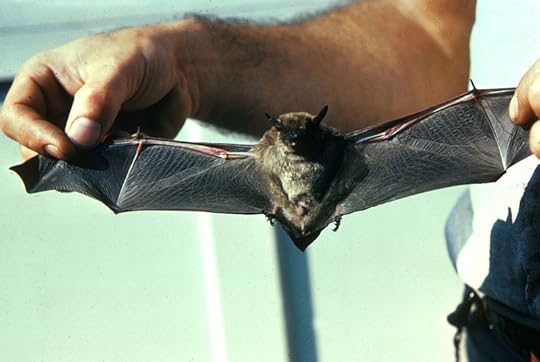 Little indeed, but eerie.
Little indeed, but eerie.Other residents of the Park include the Eastern chipmunk, the gray squirrel, wasps, hornets, slugs, snails, frogs, clams, and – appropriately in the Turtle Pond – three species of turtles. But that is hardly the whole story. An intensive 24-hour “BioBlitz” by scientists and volunteers in the summer of 2008 recorded 836 species in the Park, including 393 species of plants, 102 invertebrates, 78 moths, 46 birds, 10 spiders, 9 dragonflies, 7 mammals, 3 turtles, 2 frogs. Regarding the birds, 46 species is minimal; during spring and fall migrations they would have found hundreds more. But some species found in the Park until recently have disappeared: the woodchuck and the Eastern cottontail, both of which I have seen elsewhere.
Not reported in Central Park but seen in Van Cortlandt Park in the Bronx, and in Alley Pond Park in Queens, is the red fox. I have heard of sightings in Van Cortlandt over the years, but on my many hikes there I have never seen one, and for good reason: they are nocturnal and, unlike the raccoon, very shy. They too eat just about anything – mice, shrews, moles, squirrels, rabbits, opossums, even those obstreperous raccoons, as well as turtles, lizards, snakes, and insects, and for a vegetarian option, acorns, cherries, berries, grapes, and nuts. When, rarely, they are sighted, it’s usually a quick flash of red and they are gone.
 A red fox, photographed in the photographer's back yard.
A red fox, photographed in the photographer's back yard.Also not seen as yet in Central Park but appearing elsewhere is another newcomer, the coyote. Yes, we tend to associate the coyote with cowboys, Big Sky, and the shootout at the O.K. Corral, but the Eastern coyote, as its name implies, resides here in the East and has been extending its range southward to include the New York metropolitan area. Sneaking in from Westchester County just north of the city, it has now made its home for several years in parks in the Bronx and Queens, where residents rarely see it, but hear its howls at night and find their trash cans raided. And if they do see it, they often mistake it for a dog.
 Looks like a wolf, but it isn't. Looks like a dog, but it isn't.
Looks like a wolf, but it isn't. Looks like a dog, but it isn't.ForestWander
When coyotes first arrived in New York State is hotly debated. Some think they were here before European settlers arrived, and scattered to wilderness areas as woodlands were cleared for farms, then returned when farms reverted to forest. But others think they are new to the state, moving in from central North America only after settlers eliminated the wolf. They were first observed in northern New York in the 1930s, and by the 1980s had spread throughout the state. In 1994 one appeared in Woodlawn Cemetery in the Bronx – its modern New York City debut – and another was spotted a year later in Van Cortlandt Park.
That coyotes should appear in the northern outer boroughs was not altogether surprising, since those areas had large parks, and freestanding houses with yards and alleys with trash cans that could easily be raided. But Manhattan, with its congestion, its busy streets, its noise, and its close-packed buildings, seemed an unlikely habitat for these skulking nocturnal scavengers. Until, that is, one crossed into the borough in 1999, probably following a train line, and another was spotted in 2010 at the Manhattan entrance to the Lincoln Tunnel – events that provoked a great media brouhaha, with helicopters tracking the intruders and videos of their capture circulating on the Internet. And the invasion continues. Last January a coyote was captured by the police on a basketball court after midnight in Riverside Park on the Upper West Side, and two weeks later another was captured in the residential complex known as Stuyvesant Town on the East Side of Manhattan.
Recognizing that coyotes are here in the city to stay, the Parks Department has posted tips for coexisting with the creatures:
· Don’t feed them· Store food and garbage in animal-proof containers.· Keep pets on a leash, since coyotes have been known to kill them .· If a coyote approaches you, “act big and make loud noises.”
Wild coyotes are wary of humans, making sightings rare. But 2015 has proven to be a breakout year for the species, with numerous sightings in the suburbs, and killings of cats and small dogs. There are reports too of citizens fighting off coyotes with snow shovels, of pet dogs being snatched off front porches in broad daylight, and even – rarely – of a coyote biting a suburbanite who may then have to have a series of rabies shots. These events are more common in wooded suburban areas than in the city, but there have been plenty of sightings in the city too, including a coyote that got onto the roof of a bar in Queens. But never fear, the cavalry are coming. Well, maybe not cavalry, but the Police department’s Emergency Services Unit who, armed with tranquilizer guns and guided by a helicopter, chased a coyote through Riverside Park last April, only to have it escape, and who, days later, pursued a coyote through Battery Park City, cornered it in the outdoor seating area of a café, and stunned it with a dart. A photo of the caged victim was then triumphantly posted on Twitter, and its fate announced: release “into an appropriate wilderness area.” But first, one official announced, it would be interrogated … by a police dog, of course. So it goes in urban New York. Which suggests a new version of a time-honored rhyme:
Ashes to ashes,Dust to dust,If raccoons don’t get you,Coyotes must.
Coyotes are relative newcomers to the city; by way of contrast, the city has always been besieged by rats. While waiting for a subway train, if you glance down at the rubbish-strewn tracks, sooner or later you are bound to see their fat brown bodies skulking about, eating what New Yorkers – some of us – cast so cavalierly down on the tracks. There are an estimated 2 million of them in the city (some would say more), averaging some 16 inches long and weighing 1 pound, though they have been known to measure up to 20 inches and weigh 2 pounds. Fat as they are, they can squeeze through tiny holes, leap 4 feet sideways, fall 5 stories without injury, and tread water for 3 days. Other accomplishments include the ability to chew through pipe, have a new litter every 2 months, carry pathogens that cause various illnesses, invade restaurants after hours, and crawl up sewer pipes to enter apartments through toilets. They have bitten infants and the homeless and have eaten corpses in the city morgue. Obviously, not the most desirable of neighbors. Is it any wonder that all 109 of the city’s mayors, almost without exception, have announced plans to eradicate this scourge, or that the scourge persists?
 Just where you'd expect him: in the subway.
Just where you'd expect him: in the subway.m01229 At this point, this post has probably discouraged numerous potential visitors from setting foot in New York. And yet, having lived here for decades, I myself have seen rats only on subway tracks. Restaurants I have patronized have on occasion been closed temporarily because of infestations, and the parks I frequent often have signs posted, warning that rat poison has been spread there recently – a danger more to pets than to me. My building’s garbage cans are usually tightly sealed, though on occasion the trash they contain overflows; but so far, no rats. So I survive: in my personal experience, no raccoons, no coyotes, no rats. (Just ten thousand roaches.)
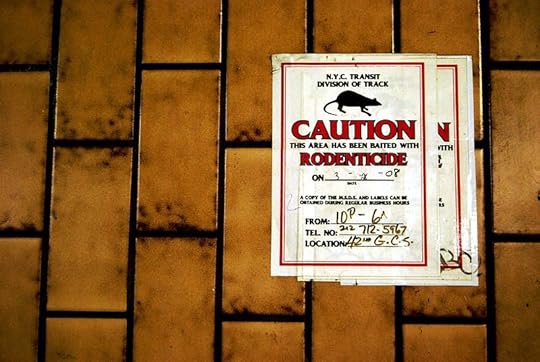 Paul Lowry
Paul LowryBut the war continues. Our mayor, Bill de Blasio, has just included $2.9 million in the budget for rat control, rats being, in Hizzoner’s words, “one New York City institution that we’re happy to get rid of.” Inspectors are stalking neighborhoods on the lookout for signs of rat behavior, teams are being assigned locations, solar compactors and other rat-proof bins are being supplied to the Sanitation Department, and relevant city bureaucracies are being told to “think like a rat.” But the enemy is known to be diabolically clever, opportunistic, and not fussy when it comes to meals. Good luck, Mr. de Blasio. You’re up against yet another wild critter that has adjusted marvelously to urban ways and finds a feast in any trash pile, any garbage can whose lid is not securely fastened. They prosper because, alas, we feed them.
Finally, having just scrutinized the ground and the sewers, let’s have a look at the skies, where two more large raptors can be seen soaring overhead. I have watched a pair of ospreys nesting in spring on a wooden platform built to accommodate them in Jamaica Bay Wildlife Refuge, sometimes both of them at the nest, with the scrawny young, beaks agape, just barely visible above the edge of the nest. And at times I have seen an osprey soaring, white below, its great outstretched wings marked with dark wrist patches, its black cheek patch sometimes visible. And once, hiking along the New Jersey side of the Hudson in November, I saw an osprey with a large fish in its beak, until, out of nowhere, a bald eagle appeared who grabbed the fish right out of the osprey’s break and made off with it – all this in a matter of seconds. Ospreys are big, but eagles are even bigger, and in nature the big guys always win.
 An osprey, extending its talons as it prepares to dive on its prey far below.
An osprey, extending its talons as it prepares to dive on its prey far below.The other large soaring raptor common to New York is the peregrine falcon, a crow-sized predator that, liking high cliffs, has adapted to the city, where it perches on ledges of skyscrapers and on bridges, and from there plummets at a speed of over 200 miles an hour – the fastest of any animal on earth – to seize a pigeon or mourning dove that it has spotted far below. Observed when perched, it shows color ranging from blue-black to slate gray above, and from white to rusty below with dark markings, its white neck marked with black cheek patches, or “sideburns.” And they do perch in the city, and not always at dizzying heights; my partner Bob’s doctor has shown us photographs he took of a peregrine sitting on top of a lamppost at Union Square.

Male and female peregrine falcons.
Long before seeing peregrines here in the city, I used to see them every autumn on Monhegan Island off midcoast Maine, where birders would come from great distances to watch them soaring or diving off the cliffs, perhaps feeding on the huge raft of eider ducks that always appeared there in the fall. One windy day when there were few birds to see, I went to Blackhead, a headland towering some 150 feet above the sea, where I lay down to get out of the wind, and saw, soaring far above me, three, then four, then five, six, seven peregrines, riding the air currents high in the sky. But there’s no need to go to Maine to see them, since there are more peregrines here in the city than in any other place in the world, though I can’t promise seven all at once. To see them diving at lightning speed, even though it means the death of some smaller bird, is to witness one of the wonders of nature, sudden, dire, and thrilling.
This post deals with wild animals in the city, but plenty of wildflowers grow here too, as I have mentioned in other posts. If, at this time of year, I go out on errands or for a walk, within two or three blocks I can usually spot at least five wildflowers, often more. They grow in vacant lots, in small bits of greenery, out of sidewalk cracks, even off the sides of old piers, some of them too tiny to be visible from a standing position; to find them, I squat. Usually dismissed as weeds, they always excite me (no, not that way), for they are growth, exuberant life, Big Mama. Along with the insects, they will inherit the earth if we humans ever die out. On this happy note I’ll end.
WNYC, Goldman Sachs, and Monsanto: Viewers of this blog know the love I bear Goldman Sachs (expressed fondly in post #158, December 21, 2014) and Monsanto. They may also recall that, as a loyal contributor to WNYC, I queried the station to find out if these two stellar entities were among their contributors. Months of silence followed, but finally last April I received a courteous response from the Manager of Listener Services, informing me of the following:
· Monsanto was once an underwriter of the program “Marketplace,” but WNYC is confident that Monsanto’s sponsorship of the show played no part in the news coverage.· Goldman Sachs is currently an underwriter of the program “Freakonomics,” but again, WNYC is confident that its coverage is not influenced by Goldman Sachs’s sponsorship.
I will let the viewers decide whether or not the station can be blithely indifferent to where its money comes from. Monsanto and Goldman Sachs know how to play the game; they put their money where it counts. WNYC’s intentions are no doubt fine, but it might come down to which stories are not covered, or covered only lightly, rather than deliberate distortions of the news. The soundest policy would be to eschew (I love this word; it sounds like a sneeze) all donations from corporations whose activities are controversial.
Coming soon: Religion in New York. How doughty old Peter Stuyvesant couldn’t stand Quakers because they quaked. Today, High Church, Low Church, and No Church. Who’s winning converts, who’s losing? Worshipers speaking in tongues and raising their arms in rapture, and the parishioners who won’t let their church close their parish. And yes, organized paganism and some atheist Satanists who want children to be allowed to pray in school … to Satan. So who said New York is godless? We’ve got gods and believers all over the place.
© 2015 Clifford Browder
Published on August 23, 2015 04:39
August 16, 2015
193. Networking among the Sagehens
The invitation, by e-mail:
PLEASE JOIN USNEW YORK CITY NETWORKING EVENTThursday, July 30, 2015 – 6:30-8:30 pmThe Princeton ClubNassau Room – 4th Floor15 West 43rd StreetNew York, NY 10036
So it read, the announcement beckoning all Sagehens in the New York area to an evening of networking, hosted by a ’77 alumnus, Managing Director of Group Risk Management for a well-known bank. “Register now!” it directed.
Sagehens? Yes, I confess I’m not a lion or tiger or wildcat or cougar or eagle, but a Sagehen, this being the time-honored designation for all those who attend, or have attended, Pomona College in Claremont in distant sunny southern California. But hardly a loyal and devoted Sagehen, since I have never attended an alumni gathering or class reunion in all these many years, and am now in touch with not a single other Sagehen, barring a distant friend in Florida. About to hit my keyboard’s DELETE, I held off, beset by doubts and temptations. Should I go or not? After getting more info – bring your business cards, dress “business casual” -- I amassed thirteen arguments against and thirteen for.
AGAINST:
1. I’ve never consciously networked, hardly know what networking is.2. I’m long since retired, don’t need professional contacts, if that’s what it’s all about.3. I have no business card.4. I’m of the class of ’50, will be the oldest one there, the ancient of days.5. What can I say to a horde of eager young graduates stuffed to the gills with energy, hopes, and ambitions?6. The Princeton Club sounds posh and exclusive.7. The host, a managing director of Group Risk Management (whatever that is), sounds intimidating, must reek of prestige and success.8. They probably want money from me.9. I can’t wear shorts, since “business casual” excludes them.10. Getting there involves braving the rush hour.11. Rain is predicted.12. I harbor memories of two horrendous events – one in my freshman year and one in my junior year – that at the time left me in shock.13. I’m eighty-six; be prudent.
FOR:
1. Out of sheer curiosity, I should learn what networking is.2. I’m a writer, can’t retire. I can tell them – ever so discreetly – about my blog, my novel, and the forthcoming book.3. I can show them – ever so discreetly – the postcard with my novel’s title and sexy cover illustration.4. As the ancient of days I can fake an aura of wisdom.5. All is grist to my mill. I’ll do a post for my blog about them. 6. The Princeton Club sounds posh and exclusive.7. Maybe I’ll find out what Group Risk Management is.8. Free eats, free drinks.9. I’ll wear a blue polo shirt, get compliments because blue is one of Pomona’s colors.10. I’m a veteran New Yorker, can handle anything.11. I have an umbrella.12. Time heals; focus on today.13. I’m eighty-six; dare!
 This is what I got, when I googled
This is what I got, when I googled"Networking." Not much help.
Bapon.7g
 And this was no help either.
And this was no help either.GNOME
As the time to depart approached, I was inclined to go, but vowed not to join in any rah-rah stuff, as for instance:
Push on, Pomona, to a victory,Push, Pomona, push!
(Admittedly, I don’t have the words quite right.) Or, worse still:
Sagehens, sagehens,Quack! Quack! Quack!
All right, that last is probably my invention. Ducks quack; I don’t know what sagehens do, if anything. In fact, I don’t know what they look like, except for Cecil Sagehen, an outsized replica that was a symbol and mascot of the college, until nefariously spirited away by those wicked Occidentals, our perennial football rivals. (I assume that Cecil was finally recovered.)
 Cecil Sagehen, as marketed on campus today. A half hour before my scheduled departure, it was pouring rain; I was definitely not going. Then the sun came out … briefly. So I grabbed my umbrella and went.
Cecil Sagehen, as marketed on campus today. A half hour before my scheduled departure, it was pouring rain; I was definitely not going. Then the sun came out … briefly. So I grabbed my umbrella and went.Getting there was not half the fun. At 6 p.m. I exited the subway at Seventh Avenue and 42nd Street and was assailed by the glaring lights of Times Square, mobs of commuting New Yorkers, and hordes of tourists taking photos right and left. Wherever I headed, the crowd was against me, and here and there I spotted a depraved-looking individual – always male, always solitary – who looked pathetically or menacingly out of it. (Ah, the diversity of New York!) I finally made it up to less crowded 43rd Street and marched confidently ahead – in the wrong direction. Seeking Sixth Avenue, I arrived instead at Eighth, had to turn around and go the other way. (Veteran New Yorker, indeed!) Finally arriving at 15 West 43rdStreet, I found it fenced off for renovation, went in by an improvised entrance, threaded my way through a labyrinth of narrow corridors, found an elevator, and got to the fourth floor.
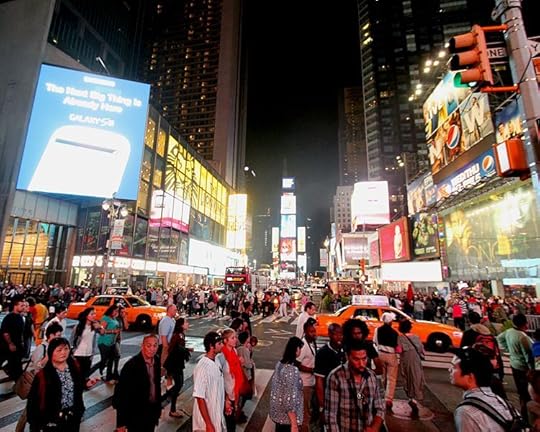 Tourists plus commuting New yorkers: it couldn't get worse.
Tourists plus commuting New yorkers: it couldn't get worse.Prayitno
Greeted by welcomers, I was given an I.D. tag with my name and the telltale “’50,” went in. The Nassau Room was a long room adjoining a terrace, with a big table heaped with appetizing dishes, waiters moving efficiently about, and a bar lined with bottles. No sooner in, I was greeted by the host, he of Group Risk Management expertise, who proved to be cordial and suave – a delightful gentleman who even laughed at my jokes. He and the viands assured me that the horrendous trip there was worth it.
More alumni entered -- young and old, but most of them buoyantly, vibrantly young – and the networking began. The murmur of conversation grew to a babble, and the babble to a roar. To warm myself up for the adventure, I helped myself to some rolls or dumplings or whatever – the food was on the Chinese side and tasty – and a glass of cool white wine that was sure to relax me into the hubbub of networking. And my contacts began.
A young woman of the class of ’09 approached me and introduced herself as a Brooklyn-based editor and writer, obviously eager to connect with another writer. We found lots of things to share:
· Writers can’t make a living writing, have to have a regular job and write in their spare time.· She’s on her first novel, is doing just that – writing in her spare time.· She’s nervous because she’s not sure how the novel will end; my advice: not to worry since the characters, if fully realized, will take over and dictate the ending.· The importance of the cover illustration, once a book is published; I showed her a postcard with the title and sexy cover illustration of my gay-themed novel, told how it hooked readers at a book fair.· Writers are lousy at self-promotion, don’t network enough, would rather be home at their desk or computer, doing their thing.· Was she nervous here? “Of course! I’m a writer!” No further explanation needed.· My out-of-print biography of Madame Restell, the abortionist, would probably find readers today, but I lack the time and patience needed to type it into my computer; she gave me the name of an outfit where I could hire someone for the job.
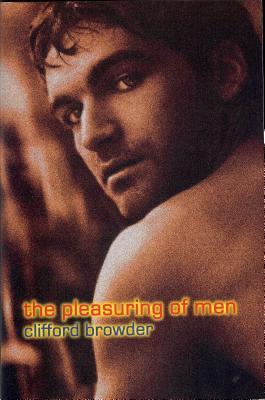 That sexy cover.
That sexy cover.Networking? You bet! So there we were, two writers most at home writing at their desk or computer, sharing the hopes and miseries of the trade, and giving each other useful tips. And the age difference? Irrelevant!
A hush fell over the babbling throng as the host, the Group Risk Manager, formally welcomed us and announced the presence of that rarest of rarities, an alumnus of the class of ’50, namely me. Applause, all eyes on the vanishing species. I flashed what I hoped was a benign patriarchal smile, seasoned with wit and wisdom. He then introduced the Assistant Director of Alumni Learning and Career Programs, with whom I had already corresponded by e-mail, thus learning that collared polo shirts were “in,” shorts “out.” She directed us to the relevant tables – Arts & Humanities, Social Sciences, and Natural Sciences -- so we could connect with alumni of similar interests, but urged that the networking be cross-generational: don’t just talk to your classmates, make new acquaintances both older and younger. That said, she turned us loose.
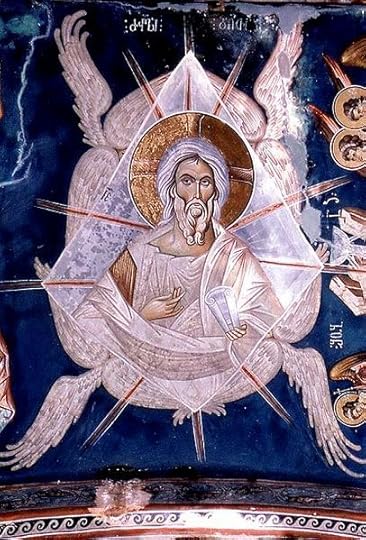 The Ancient of Days, per a 14th-century fresco.
The Ancient of Days, per a 14th-century fresco.I'm afraid I can't measure up.
I at once made a beeline for Arts & Humanities, presided over by a gracious lady of the class of ’72 with whom I promptly shook hands and exchanged few words. A bunch of us of all ages clustered around the table, and lively conversations ensued. A young Pakistani woman (’08) and I shared a host of comments and insights:
· Did she like New York? -- Adored it! Wouldn’t live anywhere else. Had traveled, knew other cities, but on coming here knew at once that this was where she had to live.· Did New York’s size put her off? -- Hardly. She came from a city of twenty million.· Her work? – Coordinator for Educational Research and Marketing at the New York Historical Society Museum & Library, where I had once done tons of research for a historical novel.· A Pomona reminiscence of hers: too much student drinking, really out of hand. – My recollection from long ago: yes, some drinking, but usually within limits and generally not out of hand.· A unique Pomona reminiscence of mine: stuck in Claremont without a car one spring vacation while everyone else headed for the beach, I learned all the exotic trees in town, especially loved the Mexican pepper tree, whose crushed leaves gave off an aroma of pepper, and even more, the leaves of the eucalyptus, emitting a heady fragrance that I found intoxicating, even voluptuous. – Her response: I grew up among eucalyptus trees, which amazed me, since I thought the eucalyptus came from Australia. (True enough, but it has been transplanted throughout the world.)· A view shared by all in the group: New York is not for everyone. No ill will toward those who, having visited, are glad to go back home to a more tranquil setting.
 Eucalyptus leaves, giving off the most voluptuous
Eucalyptus leaves, giving off the most voluptuous aroma I have ever known.
John Tann Right next to the Pakistani alumna, wedged in between her and me at the table, was another alumna who introduced herself as Leslie Britt, class of ’98, the executive director of Voices UnBroken, a small Bronx-based nonprofit dedicated to providing young people from minority communities with the means for creative self-expression. To further explain, she distributed to several of us a glossy mag with pictures of staff and young people in workshops in group homes, juvenile detention centers, and prisons, with samples of their poetry. Her mention of “nonprofit” immediately triggered memories of my volunteer work years before with another small nonprofit, the Whole Foods Project (see vignette #8, May 20, 2012). More shared insights followed:
· The dreary and unending task of having to raise money for a nonprofit, when what you really want to do is fulfill your mission.· The sad, grim truth: no money, no nonprofit.· How she was carefully eased into her position, but even so has had to learn by doing.· Did she ever go to Riker’s Island? – “Of course! Lots of times.”· Riker’s Island: the very mention of it evoked in me images of the city’s biggest prison complex on an island in the East River, an overcrowded facility notorious for strip searches, beatings, rape, suicides, and mentally ill inmates found dead in their cells after days of neglect. – “All true,” she said. “And there are fifteen-year-olds at Riker’s,” she added: a fact that chilled me to the bone.· What does she do at Riker’s? – Writing workshops, to get these kids to express themselves, to write poetry, to improve their reading, to work with others, to think about long-term goals.· My take on it: “You’re creating hope.” She agreed.
I talked briefly to others as well and had great success with my two well-practiced witticisms:
· “I’m class of ’50. 1950, not 1850.”· A “sales handle” (marketing tool) for my forthcoming book: British novelist Angela Carter’s observation: “London is a man, Paris a woman, and New York a well-adjusted transsexual.”
And I even talked to a waiter, an older man serving as bartender.
“Is this job boring or doable?”
“It’s a great job,” he answered. “I love it. It puts me in touch with nice people.”
I then confessed that I’d never been to a networking event before and was the oldest one there.
“You’re good for another twenty years,” he said with a grin.
I left him with a look of complicity between us; a delightful momentary bond.
When I left at about 8:20, things were still going at a roar. Had I been able to stay longer, I’m sure I’d have had more lively conversations, but I wanted to get home to my partner Bob, whose home-care aide left at 8. On the way home I found myself walking west along West 14th Street past the Salvation Army’s regional headquarters, a masterpiece of Art Deco architecture that most people stride right past without giving it even a glance. I lingered there for a few minutes, peering through a grilled gate into the grotto-like entrance, savoring another pleasant surprise on this evening of surprises.
So what are my final impressions of this networking event, unique in my experience? It was delightful and well worth attending, a festival of success. The attendees were young professionals on their way up, and older alumni who had some sort of achievement under their belt and could relate easily to the young. Ah, but who wasn’t there? The elderly and sick, the defeated and desperate, the addicts and alcoholics, the failures, the lost. Given the nature of Pomona alumni – well-scrubbed middle-class achievers – the numbers of the lost are probably minimal, but I know too much about human nature to assume they are nonexistent. More power to the achievers; I wish them well. But I am sad for those who, for whatever reason, couldn’t or wouldn’t join us. There are dark stories out there that will never be known.
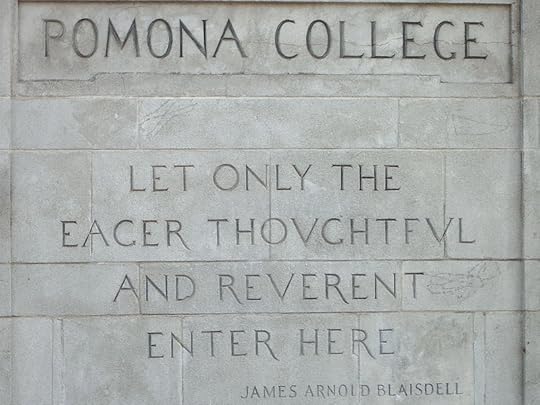 The gateway to the college, with the inspired thoughts of the college's third president,
The gateway to the college, with the inspired thoughts of the college's third president, a minister and theologian. But some of us snuck in anyway.
Waifer X
One disappointment, just one: nobody noticed my blue polo shirt.
I once told an alumna of my suburban high school that, being the pen pal of a gay inmate serving a twenty-year sentence for sex with a minor, I hoped to be the class bad boy. Her answer: “You haven’t a chance. We’ve got murderers and international drug dealers!” With that kind of competition – never explained in detail -- I knew I was outclassed. Hopefully, Pomona has never harbored any of those persuasions, though you can never be sure. I’m not in touch with my classmates, but for the most part I’m certain that the dwindling number of survivors are reasonably well off and not steeped in turpitude and crime. One, I know, inherited great wealth and owned a castle in Ireland, and another amassed a fortune as an expert in arranging corporate mergers. I’m not in their league financially, but then, neither are a lot of my classmates. But I’m glad that I now know of an alumna who is committed to helping young people trapped in the criminal justice system here in New York. Since that event I’ve read samples of poetry by the kids in her programs:
Incarceration is a journeyBeing stuck hereI didn’t know it would hurt meOptimistic words, spoken by an attorneySilence to my ear… (J.R., age 13)
Paint me like I amPaint me proudlyWith bright colorsAnd a fresh paintbrush… (N.C., age 15)
It’s not fun being bulliedOr harassed by the way you look,Smell or act, or your age groupI think people shouldn’t judge meI am my own personIt’s not about being popularOr the best at everything… (S.F., age 12)
I wish I could live foreverrunning in a field of pink rosessurrounded by nothing buta red rose treeWhy have things turned terrible?When it just started getting betterI don’t understandI forget… (A.J., age 17)
We all have to follow our dream, whatever it may be, but Leslie Britt and Voices UnBroken are on the front line, doing something truly significant. Castles in Ireland and corporate mergers are all very fine, but this is what really counts. Without networking, I’d never have known.
My forthcoming book: No Place for Normal: New York / Stories from the Most Exciting City in the World, a collection of posts from this blog, will probably be available both in a print version and as an e-book in September. The final proofs have been sent to the printer, and the copyright application has been sent off.
Coming soon: Wild New York. Central Park at night: skulkers, prowlers, ravagers, doing things you wouldn't believe. Only for the hardy of heart. Also, West Harlem terrorized, and an aging stud, his fans and many mates.
© 2015 Clifford Browder
Published on August 16, 2015 04:21
August 9, 2015
192. Westbeth: Artists and Transistors
Westbeth, like the former Village Nursing Home, is one of several old buildings that loom up in the West Village, massive and squat, buildings that don’t soar but have a history to tell. A nonprofit housing complex offering affordable living and working space to artists and arts organizations, Westbeth occupies a whole city block bounded by West, Bethune, Washington, and Bank Streets near the Hudson River, and derives its name from the first two. I have often visited there, for a sculptor friend of mine named Marion had a spacious apartment and studio on the second floor.
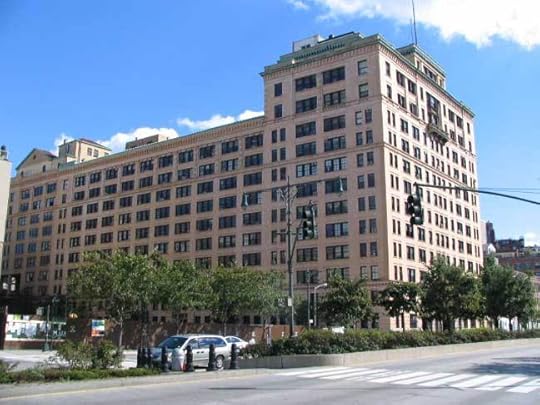 Westbeth, as seen from West Street.
Westbeth, as seen from West Street.Like so many residents, Marion, the daughter of a kosher butcher in Rockaway, was a dedicated artist who couldn’t make a living from her work, and was grateful to be living in Westbeth when Village rents kept going up, and to have finally obtained Medicaid, and maybe a reduced rent from the city, without which she couldn’t have survived financially. I loved visiting her apartment/studio and seeing her sculpture on display, much of it semiabstract with motifs suggesting vegetation; two of her pieces, small columns about a foot high showing stylized buds opening, stand on the mantel in my bedroom/desk area. A friend of mine once glanced at them and dismissed them as vaguely vaginal and distasteful. Vaguely vaginal, perhaps, but not distasteful; all her work suggests organic life and growth, the irrepressible Big Mama that I have celebrated elsewhere and hope to celebrate again. (See post #59: “Earth Goddesses: Big Mama.”)
Life in Westbeth, despite the reasonable rents, was not idyllic. Marion complained of having to fight for access to a kiln in the basement; about scaffolding for construction work that the city erected outside her window and left there for months on end, blocking her light; and about her trouble getting a social worker to visit her as she aged. She was full of stories about friendly and unfriendly neighbors, about residents who had somehow snuck in and continued to reside there, even though they were clearly not artists and therefore not entitled to a Westbeth apartment. But there were amenities too: free movies once a week, and an exhibition in another part of Westbeth where she displayed her work and actually made some sales. The cash from those sales, a rare boost to her meager income, she then stashed away in her apartment, fearful of losing Medicaid money and a reduced rent if she put it in a bank. Alas, she then forgot where she had stashed it and fretted endlessly until, as I recall, it finally turned up.
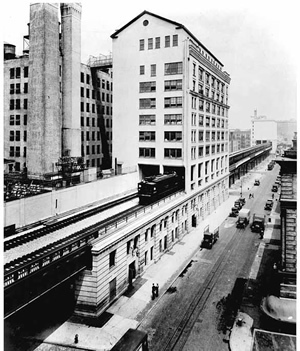 Bell Labs in 1936, with the West Side Line running right through it,
Bell Labs in 1936, with the West Side Line running right through it,above Washington Street.
Such was the Westbeth that I came to know, but Westbeth hadn’t always been Westbeth. It had originally been built in the years following 1880 as a complex of thirteen buildings ranging from 3 to 13 stories that served from 1898 to 1966 as the headquarters of what in 1925 became Bell Telephone Laboratories, an affiliate of AT&T and the largest industrial research center in the United States, a self-styled “idea factory” where some 4,000 scientists and engineers collaborated to explore areas of science likely to shape the future of the communications industry. It was AT&T’s monopoly on the telephone industry, giving it immense power and wealth, that made possible this commitment to long-term research and development. Freed from concerns about funding, teams of researchers – physicists interacting with mathematicians and chemists and engineers – worked on projects that took years to complete; what counted was the final result, and failure was not penalized. From this hotbed of creativity came such wonders as these:
· The vacuum tube, a basic component in early twentieth-century electronics· The first experimental talking movies· The condenser microphone· The first digital scrambled speech transmission system, used by the Allies in World War II· Radar, employed by the Allies in World War II to detect enemy ships and planes at great distances· An early version of television· The transistor, a device essential to modern electronics systems· The first electrical and digital computer
If some of these creations baffle you, as they do me, don’t worry about it, just rest assured that, technologically, they make our life today possible. And if a layman had peeked into the complex back then, what was there to see? Engineers bent over tiny devices or contemplating massive machines. Blackboards with formulas in chalk. Men in shirtsleeves clustered around mysterious devices. Everywhere, tubes, cables, dials, tangles of wires. It would all have been complex, weird, baffling. But these workers were inventing the future. All in all, a tough act to follow.
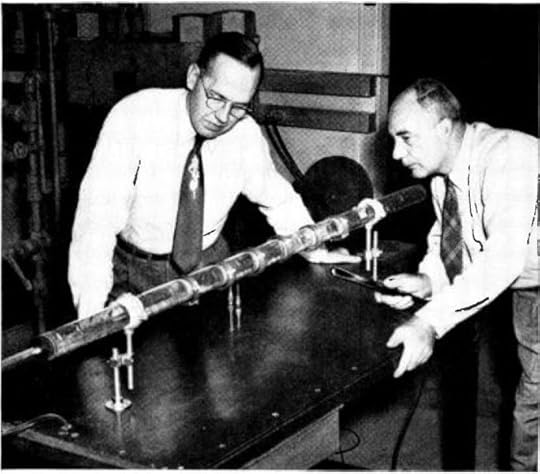 Bell Labs technicians with the first zone refining equipment, 1954.
Bell Labs technicians with the first zone refining equipment, 1954.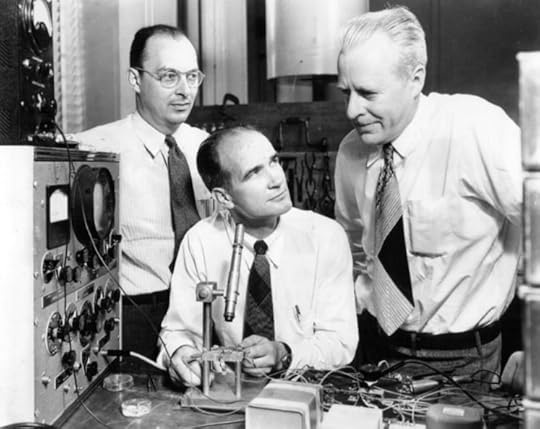 Inventors of the transistor, 1948.
Inventors of the transistor, 1948. Replica of the first transistor, invented in December 1947.
Replica of the first transistor, invented in December 1947.So now we all know what a transistor is and what it does.
Revol Web
Running right through the complex’s east (Washington Street) side was the New York Central Railroad’s West Side Line, an elevated rail line that moved freight, including that of Bell Laboratories, to and from factories and warehouses without disturbing the West Side’s ground-level traffic. With the growth of interstate trucking in the 1950s, rail traffic declined throughout the nation, rendering the West Side Line obsolete. The southern section, including the part running through Bell Labs, was demolished by 1960, though the abandoned tracks remained. I know, because they were visible right outside Marion’s second-floor windows. In another marvelous transformation, in recent years those weedy tracks have been turned into the much-visited High Line park.
When Bell Labs, needing more space and more modern facilities, relocated to New Jersey in 1966, the complex remained empty for two years until the philanthropic J.W. Kaplan Fund and the National Endowment for the Arts conceived a novel idea: not to demolish this huge pile of brick and granite and then build something strikingly new, as most developers would have done, but to convert the existing structures into a low- to moderate-income rental housing project, the biggest of its kind in the world, to provide living and work space to people involved in the arts.
Since the project was without precedent, it had to be explained to numerous agencies in order to enlist their support. Complicated negotiations followed with AT&T, the owner, which had no intention of selling the complex for a song; with the city to get a tax abatement and create a special zoning district for living and work space in an industrial zone; and with the FHA (Federal Housing Administration) in Washington to obtain a subsidized mortgage. Slowly over a two-year period, under the supervision of Richard Meier, then relatively unknown but in time an acclaimed award-winning architect, the novel idea became reality. It was hoped that the project would serve as a model for the conversion of other urban industrial buildings into housing for artists.
Westbeth opened in 1970. To be admitted, applicants had to undergo rigorous review by a selection committee determined to eliminate students and weekend dabblers, and to accept only professionals of proven full-time commitment. At the same time, the greatest possible diversity was desired: artists, dancers, composers, musicians, choreographers, actors, writers, photographers, and filmmakers. What awaited the lucky chosen ones were 383 loftlike units that were unpartitioned, so the occupants could decide how to divide their unit between living space and studio. Because of the undesirable neighborhood, commercial tenants were harder to find, but right from the start the Merce Cunningham Dance Company rented a top-floor space for its studio and has been there ever since.
The Far West Village at that time was desolate and deserted, and some found it even scary, with plenty of drugs and promiscuous gay sex on the abandoned old piers of the nearby riverfront at night. Many of those moving in found the building itself, with its long, labyrinthine corridors, also a bit scary, and depressing and seedy as well, with the appearance of a penitentiary, but since when had struggling artists known anything better?
The novel idea of rehabilitating old industrial buildings, instead of tearing them down and putting up new ones, was generally greeted with approval. Ada Louise Huxtable, the New York Times architecture critic, was especially positive, hailing Westbeth’s open apartment plans as “a first step out of the steel trap of FHA rules.” And the pioneering example of Westbeth facilitated the subsequent mass conversion of lofts and cast-iron buildings in Soho and elsewhere into artists’ studios and galleries.
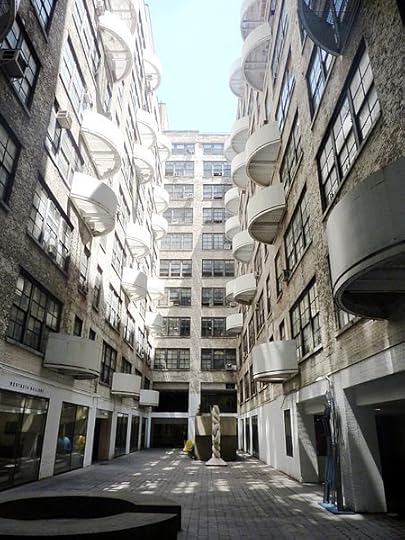 A Westbeth inner courtyard, 2012. A part of
A Westbeth inner courtyard, 2012. A part ofWestbeth I have never seen.
Muncharelli Westbeth is owned and operated by the Westbeth Corporation Housing Development Fund, Inc., a not-for-profit corporation governed by an unpaid board of twelve directors, three of whom are tenants. New applicants for admission are now accepted only after review by a committee of residential tenants in their field, and must meet certain income requirements as well. (Though some others slip in, as Marion’s stories attest.) It was originally thought that creative people would reside there at the beginning of their career; then, as they became better known and prospered, they would move out. But as the Village underwent gentrification and rents continued to rise, few residents wanted to leave. Over the years the population aged, waiting lists grew longer, and finally, in 2007, the lists were closed; those already on them face a 10- to 15-year wait. Westbeth is now a retirement community where residents exit only feet first. It was added to the National Register of Historic Places in 2009, and in 2011 was designated a landmark by the New York City Landmarks Preservation Commission.
Landmark or not, Westbeth has experienced vicissitudes, some of them distinctly unpleasant. In 1971 a woman was raped there, and another woman who was not a resident walked in, went up to the roof, and jumped off, landing with a smash in the courtyard, her mangled remains lying there under a sheet for hours, until the authorities finally removed them. Then a Westbeth resident likewise went up to the roof and jumped. “Deathbeth” and “Westdeath” some of the residents began to call it, and several with children who had just moved in moved right back out. Finally, on the heels of these events, photographer Diane Arbus was found by a friend in her bathtub, wrists slit, her body already decomposing. Definitely not a good year for a bastion of creativity. But did the old residents move out? Are you kidding? In New York City a reasonable rent trumps all.
The Westbeth community, like any community, has known gossip, factions, and feuds. Still, it is a very special community, unique. A man scavenging the garbage cans in the courtyard may look like a homeless intruder, but he’s just an artist collecting items for his art. A neighbor mumbling to herself isn’t crazy, simply a writer engrossed in her writing and working out a problematic paragraph. And where but in Westbeth should Barton Benes live and work, filling his place with voodoo totems, a blackened human toe, and a squirt gun with HIV-infected blood, making art out of death? (See post #33, November 11, 2012.)
Even so, the place harbors more than its share of the unhinged. An opinionated journalist got unsigned letters slipped under her door reacting to her published articles, as for example: “Precancerous lump and mental illness, you poor dear” – a complete misinterpretation of an article about getting a mammogram. And after complaining about a barking dog that kept her awake at night: “Dog hater!” But the biggest insult anyone can utter is simply, “You aren’t really an artist.” Yet for all that, tolerance reigns; the rare tenant evicted for antisocial behavior was a drunk who urinated out his window and brought bedbugs and prostitutes on crack into his apartment.
With the construction of the Hudson River Park in the 1990s, displacing the crumbling piers and the seedy wildness they invited, gentrification began creeping into the neighborhood, and now luxury housing surrounds Westbeth, and the Meatpacking District abounds in pricey coffee shops and trendy bars and restaurants. Some tenants hope that the influx of new money will mean sales of their work at the complex’s monthly exhibits, while others evince skepticism, certain that their new moneyed neighbors, if they have any interest at all in art, will prefer costly items by big-name artists. But all agree that Westbeth is the only place in today’s Village where artists can survive.
When I last saw my friend Marion a few years ago, she was depressed; now in her early 80s, she had fallen once in her apartment and feared she would fall again. But when I and a mutual friend began looking at her sculpture, she pulled herself out of her funk and explained in detail how each piece had come into being; her accounts were fascinating, and she glowed.
Some time after that I learned that she had left Westbeth, but not feet first. Having fallen again, she realized she couldn’t live there alone any more, and her godson got her into an assisted living facility upstate. When I phoned her there once, she was depressed again, hating the food, feeling exiled and out of it (whatever “it” might be). But when I phoned a second time, she was cheerful, for her godson had come to visit her. Did she need anything? No, not really, except an occasional phone call or a card. And her art – that assemblage of sculpture that had so fascinated me in her studio at Westbeth? Her godson has assured her that it’s in safe keeping, though what this implies she didn’t seem to know or want to know. Gone, I suspect, though I don’t know where or how. But some earlier pieces signed by her can be found on the Internet, selling for $6,000 an item. One thing is certain: Marion herself won’t see any of the proceeds, if proceeds there should be.
As the longtime Westbeth residents age, there will be more stories like Marion’s, few of them with happy endings. Yet my partner Bob’s doctor, who sees a number of patients in Westbeth, most of them in their nineties, assures me that they are a very special breed, more intellectual than most people their age, and probably were so back when they moved in.
On Monday, October 29, 2012, Hurricane Sandy sent a four-foot tidal wave rolling up Bethune Street from the river, flooding the basement of Westbeth with nine feet of water and knocking out all electrical equipment, boilers, and pumps, leaving the entire complex without electricity, heat, or water. At the same time the telephone lines went down, and even cell phones for a while didn’t work. No one had expected anything like this; advised by management, residents had filled their bathtubs with water, but it wasn’t enough for a crisis that lasted for days. Plunged into darkness and with all the elevators out, tenants had to climb up and down many flights of stairs to fetch food and water. The whole building soon smelled of unflushed toilets, rotting food and, rising from the basement, a stench of flood water, paints, solvents, and detergents. In their flooded basement studios some artists lost a lifetime of work, and musicians, precious equipment and instruments; Martha Graham’s dance company suffered a $4 million loss of sets and costumes.
As the outage continued, some tenants left to find shelter with friends or relatives; others, unable to manage the stairs, could only wait in a cold, darkened room, hoping someone would come to their aid. Crowning the disaster was the arrival of tourists who out of curiosity barged in and wandered about, gawking, but never offering to assist in any way. But Westbeth is a caring community, and residents did check in with their elderly or disabled neighbors. Those who waited in a darkened room did at last get help, when a someone with a flashlight arrived with food, water, and warm clothing.
Only after four days did management let tenants back into the basement, where everything was contaminated by filthy water, and it was a week before half the complex had its power restored, and another week for the rest, and even then the elevators didn’t work. But through the worst of it a wonderful camaraderie prevailed, and people who barely knew each other exchanged warm greetings and shared tales of woe.
Is Westbeth also threatened financially? According to an article by Catherine Revland last May in the West View News, a free monthly newspaper covering the West Village, it could well be. “Will Westbeth be the Next St. Vincent’s?” reads the caption, referring to the much lamented demise of the Village’s only full-service hospital, now demolished to make way for more luxury housing. Ms. Revland’s article starts by quoting the website of Ramscale Productions, which announces, “Quintessential New York location! Spectacular sunset views!” The website further entices prospective clients with photos of a penthouse and adjoining terrace with elegant guests being served drinks and goodies by waiters in immaculate white far above the riverfront and the river – a site, Ramscale insists, that is ideal for wedding parties, product launches, fashion shows, and film and TV productions in the hottest neighborhood in town.
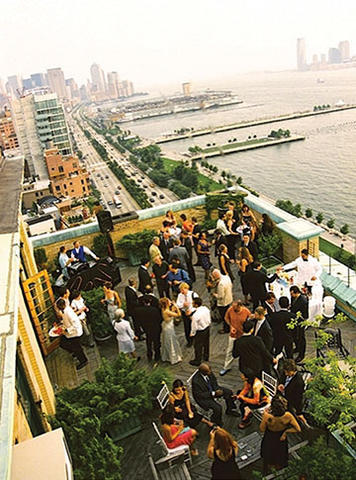 Ramscale revels, high above West Street and the river.
Ramscale revels, high above West Street and the river.Ramscale
Is this Westbeth, the home of artists of limited means? Yes, for Ramscale has a long-term lease on the Westbeth penthouse and terrace and sublets the space to clients. Meanwhile Westbeth’s artist residents face staggering rent increases to pay more than $10 million in hurricane damage repairs and a major façade restoration, while Ramscale rents out its penthouse and terrace for as much as $10,000 a day, without having to pay a penny toward repairs. What gives?
Residents applying for admission to Westbeth must prove they have a low-to-modest income, but no such restrictions apply to commercial tenants. Yes, there are commercial tenants too, Ramscale prominent among them, and the revenue from such tenants has always been much less than that from the artist residents. The Westbeth board of directors once justified this by citing the undesirability of the neighborhood, but today, thanks to gentrification, the neighborhood is eminently desirable. The Far West Village, now rid of the abandoned riverfront piers and the sleazy S-and-M bars of the Meatpacking District, and wonderfully enhanced by the High Line park, is, from a real-estate point of view, “hot.” Indeed, it’s torrid.
In spite of this, the Westbeth board refuses to reveal any information about the income from commercial rents, insists that such information is confidential, and has taken steps to block any legal action by residents to obtain it. As for the complex’s finances, in response to Ms. Revland’s article Executive Director Steven A. Neil points out that Westbeth’s complete tax returns are available from the IRS and from Westbeth itself, as required by law.
The tenants are sure that that Ramscale’s lease of the penthouse is remarkably undervalued – in effect, a “sweetheart” deal. So Ms. Revland asks if Westbeth, like St. Vincent’s before it, will face a sudden financial collapse, after being assured for years by its board that everything is in order. Past boards took Westbeth to the brink of bankruptcy twice; the current residents are determined to not let it happen again. Again in response, Mr. Neil states that in 2008 Westbeth took legal action to evict Ramscale, and that, under the settlement finally reached in 2014, Ramscale has commercial leases for two units on the 13th floor at “reasonable” rents, and that it is not entitled to renew those leases when they expire.
Let’s hope that Mr. Neil’s explanations are valid. If Westbeth should go the way, not just of St. Vincent’s, but also the Archive Building and the Village Nursing Home – not to mention the Palazzo Chupi (see post #187) – and end up offering still more luxury housing in the West Village, it would be an unspeakable atrocity. There’s no sign of that as yet, but the situation bears scrutiny. Westbeth is, and must remain, unique.
A note on AT&T: In 1974 the Department of Justice initiated an antitrust suit against AT&T. When the suit was settled in 1982, AT&T’s local operations were divided among seven regional companies christened “Baby Bells.” The end of AT&T’s monopoly of the telephone business also meant the end of the golden age of Bell Labs, for AT&T, given its reduced revenues, felt it could no longer finance the long-term research and development that had characterized its laboratories. Still, that was not the end of Bell Labs. Recently, when I happened to glance at the print on the glue traps I use to fight the bugs invading my apartment, what did I find? “Bell Laboratories, Inc. Madison, WI.” Not a product on the scale of radar or the transistor, but useful nonetheless.
Coming soon: Networking: to find out what it is, I invade the exclusive Princeton Club, play the ancient of days, commune with fellow Sagehens, meet a woman whose work takes her to Riker’s Island regularly, and another who isn’t put off by New York’s size, since she comes from a city of twenty million. “But what is a Sagehen?” you ask. All shall be revealed.
© Clifford Browder 2015
Published on August 09, 2015 04:53
August 2, 2015
191. Patent Medicines, and Who Is a Quack?
Long ago, when I was squinting at old New York newspapers on microfilm, researching the financial antics of Wall Street speculator Daniel Drew, and the scandalous career of Madame Restell, the abortionist, I came on full pages of ads that baffled, then intrigued me. The products advertised, both then and throughout the century, included such items as these:
Swaim’s PanaceaViner’s VermifugeLydia E. Pinkham’s Herb MedicineAyer’s Cathartic PillsCocaine Toothache DropsHostetter’s BittersWister’s BalsamPastor Koenig’s Nerve TonicDr. Williams’ Pink Pills for Pale People
Such were the patent medicines of the time, which, by the way, were anything but patented. In seventeenth-century England, elixirs that found favor with royalty received letters patent, allowing them to use the royal endorsement in marketing; the name “patent medicine” resulted, and stuck.
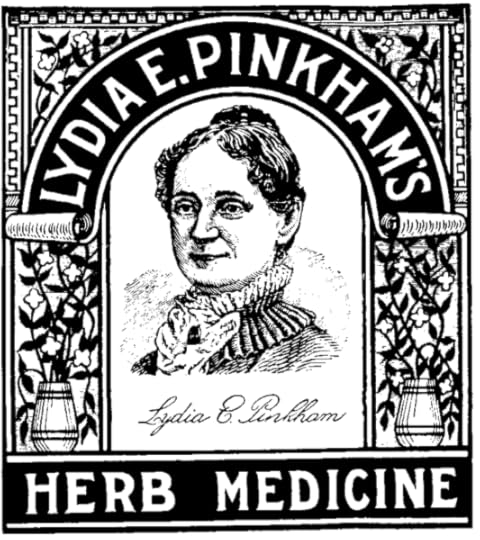
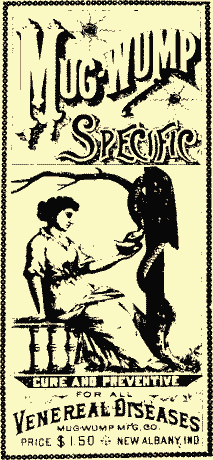 Here they actually say the
Here they actually say thedread words: venereal disease.
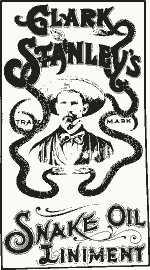 Yes, there really was such a thing
Yes, there really was such a thingas snake oil.
And what did these medicines cure? Indeed, what didn’t they purport to cure? Swaim’s Panacea, the product of Swaim’s Laboratory in Philadelphia, was created in 1820 by a Professor William Swaim and claimed to heal scrofula, coxalgia (hip-joint disease), mercurial rheumatism, chronic ulcers, scrofulous ophthalmia, eczema, and poisoning of the blood. Still marketed in the 1890s, it was sometimes pictured as a stalwart Hercules clubbing the multimouthed dragon of disease.
Ayer’s Cathartic Pills, the creation of Dr. J.C. Ayer of Lowell, Massachusetts, was a “safe, pleasant and reliable family medicine,” sugar-coated and designed to cure flatulency, dizziness, foul stomach, rheumatism, liver disorder, kidney complaints, constipation, and diarrhea. When he retired in 1878, Dr. Ayer – who was in fact a real doctor – was thought to be the wealthiest manufacturer of patent medicines in the country.
Cocaine Toothache Drops, manufactured in Albany, promised an instantaneous cure for toothache and were marketed especially for children, while also guaranteeing to put the user in a “better” mood. Hailed as miracle cures, cocaine, morphine, and even heroin were sold quite legally.
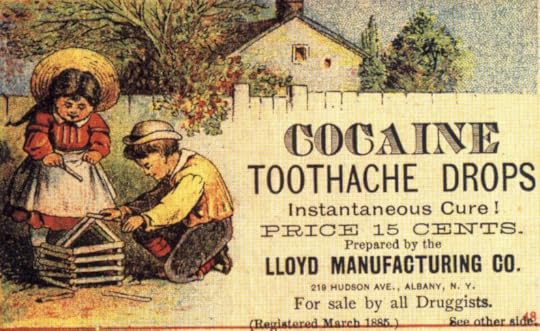 Cocaine for kids, 1885.
Cocaine for kids, 1885.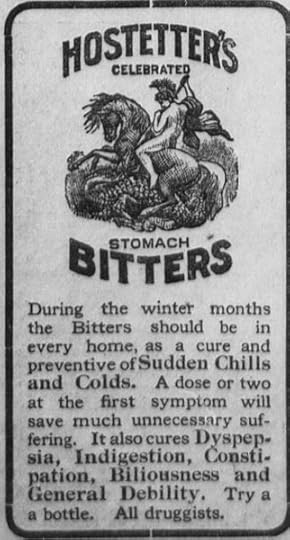 Slaying the dragon of disease.
Slaying the dragon of disease.A 1905 ad. Hostetter’s Bitters, the creation of Dr. Jacob Hostetter, a prominent Pennsylvania physician, was promoted by his son and first appeared on the market in 1853. Pictured as a mounted hero spearing a writhing dragon of disease, it claimed to cure colds, dyspepsia, indigestion, constipation, biliousness, and general debility. When the Civil War broke out, it was promoted as “a positive protective against the fatal maladies of the Southern swamps,” and the War Department shipped trainloads of it to the troops, who surely appreciated it. In peacetime thousands bought it, convinced that a daily dose would keep them healthy and in good spirits. Good spirits certainly resulted, and we shall soon see why.
Dr. Williams’ Pink Pills for Pale People, a Canadian product manufactured in this country in Schenectady, was sold throughout the U.S. and the British Empire. What it offered, besides alliteration, was a cure for St. Vitus’ Dance, locomotor ataxia, partial paralyxia, seistica (whatever that might be), neuralgia rheumatism, nervous headache, the after effects of grippe, palpitation of the heart, pale and sallow complexions, and “all forms of weakness in male and female.” Whether a Dr. Williams actually existed, I haven’t been able to determine.
The key to the success of these mass-produced products was advertising, then in its infancy or at least its adolescence, and as imaginative as it was energetic, ruthless, and robust. In a previous post, “Advertising: Hucksters of Yore and Today” (#151, November 1, 2014), I described how patent medicines were promoted in New York and beyond:
Patent medicine almanacs were dispensed free on the counters of drugstores and general stores between Christmas and New Year’s, or were distributed to the public by young boys paid a quarter a day. And the names of the products appeared in posters on walls and fences and the decks and cabins of steamboats; on the sides of horsecars; on signs on wagons roaming the busy streets; on brick piles; on asbestos curtains in theaters; and on mirrors in public waiting rooms. No flat surface was safe, and the sidewalks of busy Broadway were enlivened by sandwich men flaunting the names of remedies fore and aft:
Pocahontas BittersRadical Cure TrussesPhilipot’s Infallible Extract
Nor was rural America spared: the names of nostrums appeared on rocks, trees, fences, barns, and sheds; adorned the soaring basalt cliffs of the Palisades, visible to passengers on Hudson River steamboats; and with the completion of the first transcontinental railroad in 1869, graced telegraph poles and even the Rocky Mountains, and the Sierra Nevada range in distant California. And as a traveler approached San Francisco by train, he was informed that “VINEGAR BITTERS IS ALL THE GO FOR LOVE!” “Ob-scenery!” protested the New York Tribune, but to no avail. The ultimate in advertising was achieved when a nostrum maker bought a steamboat, adorned it with ads for his liniment, cast it adrift on Lake Erie, and let it float to destruction over Niagara Falls.
In a nutshell: patented medicines were mass-produced products, allegedly medicinal, that were marketed aggressively with false statements and extravagant claims.

The patent medicine hucksters linked their products sometimes to science or pseudoscience, and sometimes to the Native American peoples, thought to be in tune with nature and wise in natural lore. And as if that wasn’t enough, an ad might show a corpse sitting upright in a coffin, with the words “Killed by Catarrh!” Or a skeleton of death escorting a victim toward an open grave past tombstones with skull and crossbones, until the medicine, pictured as a knight with sword unsheathed or a hovering angel, effected a last-minute rescue. And often there was a final enticement: “Recommended by ministers.”
Many patent medicines were vastly successful, permitting their creators to join the ranks of the newly moneyed, along with profiteers fattened by government contracts during the Civil War, inventors of patented shirtfronts and trusses, Wall Street speculators, railroad magnates, and other rajahs of finance.
What explains the success of these nostrums, their ingredients undisclosed or misrepresented, and their grandiose pretensions dubious at best? Throughout much of the nineteenth century orthodox medicine had little to offer: ether as an anesthetic, quinine for malaria, a vaccine for smallpox, and not much else except tender loving care. The limits of TLC, however conscientiously applied, became evident when pitted against the ravages of consumption, arthritis, and “delicate” (venereal) diseases. Into this pharmaceutical vacuum the nostrum manufacturers strode boldly, promising panaceas for every imaginable complaint, and the public, out of faith and desperation, bought. And if the nostrums’ undisclosed ingredients included a significant amount of alcohol, cocaine, or heroin, it could only enhance sales, especially in communities where temperance was enforced by law. (Not, of course, in New York City, where a liquor grocery graced every street corner in the slums, and dazzling mirror-backed bars abounded in more respectable neighborhoods, including the fanciest hotels.)
Inevitably, in this golden age of pharmaceutical permissiveness, this Wild West of medicinal outlawry, there were calls for government regulation. A national food and drug act was first proposed in Congress in 1880, but it failed to pass. Many publications relied heavily on patent medicine ads for income, nor were most Americans ready for reform, believing as they did in certain inalienable rights: the right not only to worship freely, resist taxation, and damn the government, but also to self-medicate. On every middle-class household’s library shelf, along with Tennyson, Longfellow, Little Women, and the Holy Bible, was a compendium of time-honored home remedies, many of them sanctioned by tradition and little else:
· For toothache: 3 drops essential oil of cloves on cotton, placed in the hollow of the tooth.· To prevent or cure baldness: 2 oz. eau de cologne, 2 drams tincture of cantharides, 20 drops each of oil of rosemary, oil of nutmeg, and oil of nutmeg, to be rubbed on the bald spot every night. · For burns and scalds: 4 oz. powdered alum put into a pint of cold water, then applied to the affected area.· For freckles: ½ dram muriate of ammonia, 2 drams lavender water, ½ pint distilled water, applied with a sponge 2 or 3 times a day. · For offensive breath: 6 to 10 drops concentrated solution of chloride of soda.· For deafness: 3 drops sheep’s gall, warmed, put into ear at bedtime and syringed with warm soap and water in the morning, applied for 3 successive nights.
Armed with such remedies, why would one need patent medicines, too? Because even the best home remedies didn’t always work, and how could one resist the glowing promises, the fervent testimonials, the round, square, drum-shaped, pig- or fish-shaped colored bottles, or even bottles in the likeness of a lighthouse, an Indian maiden, or a bust of Washington? Also, many of the nostrums made you feel so good.
But at the start of the twentieth century things began to change. Muckraker journalists began investigating the ingredients of patent medicines and exposed their use of narcotics and – worse in the eyes of some – alcohol. Hostetter’s Bitters, for example, was 4% herbal oils and extracts, 64% water, and a whopping 32% alcohol; no wonder it made you feel so good! And the public began to question whether cocaine belong in toothache drops meant for children, and why users of certain nostrums developed alarming signs of addiction. Then, in 1905, Samuel Hopkins Adams wrote a series of eleven articles for Collier’s Weekly entitled “The Great American Fraud,” exposing the patent medicine industry’s false claims and the harm they did to the public’s health. Turning one of that industry’s stratagems against it, Collier’s put on its cover an illustration of a skull with a row of medicine bottles serving as teeth, and on the skull the words
THEPATENT MEDICINE TRUSTPALATABLE POISONFOR THE POOR
and below the skull, “DEATH’S LABORATORY.” It’s no coincidence that one year later, in 1906, Congress passed the Pure Food and Drug Act, the first of a series of federal consumer protection laws that, slowly but surely, brought an end to the patent medicine industry. Morris Fishbein, the longtime editor of the Journal of the American Medical Association, devoted much of his career to exposing quacks and driving them out of business. But among his targets were osteopathy, homeopathy, chiropractic, dietary fads, and physical therapy, which should give one pause for thought.
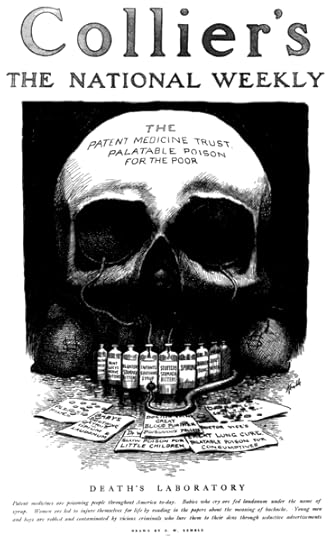 Add caption
Add captionNot that the quacks – or, if you prefer, patent medicine makers – went out of business completely. Instead, they shifted their talents from selling nostrums to promoting deodorants and toothpastes, using the same techniques they had employed so effectively in selling nostrums. Never underestimate the skill and resourcefulness of the American huckster; they’re with us to this day.
And so are many products once promoted with extravagant or dubious medicinal claims in the patent medicine era, and now still on the market, albeit with a change in image and ingredients. Soft drinks are prominent among them.
· 7 Up, marketed as Bib-Label Lithiated Lemon-Lime Soda when launched in 1929, contained the mood-stabilizing drug lithium citrate and was advertised as a remedy for hangovers. The drug was removed from it in 1948. Now 7 Up is advertised as a soft drink only.· Dr. Pepper, created in Texas in 1880 and marketed nationally in 1904, was advertised as a brain tonic and “liquid sunshine,” capable of building up cells broken down by fatigue.· Pepsi-Cola, created in 1893 in North Carolina and named Pepsi-Cola in 1898, was marketed as a drink that would let you “zoom over your troubles” and scintillate, and nip an incipient headache in the bud. Whether such claims can be labeled “medicinal” can be debated, but they certainly came close.· Hires Root Beer was created by a Philadelphia Pharmacist named Charles Elmer Hires in the 1870s and was marketed as purifying the blood and making rosy cheeks.
Coca-Cola deserves a mention of its own. It was invented by Confederate Colonel John Pemberton who, wounded in the Civil War, became addicted to morphine and sought to find a less dangerous opiate to relieve his pain. Launched in Atlanta in 1886, Coca-Cola claimed to cure morphine addiction, dyspepsia, neurasthenia, headache, and impotence. The exact formula for Coca-Cola’s natural flavorings has always been a closely held trade secret, but its two key ingredients originally were cocaine (hence “Coca”) and caffeine (from Kola nuts). Cocaine was eliminated in 1903, and in the 1911 lawsuit United States v. Forty Barrels and Twenty Kegs of Coca-Cola the government tried to make the company eliminate caffeine as well. The 40 barrels and 20 kegs won in court but in 1916 lost on appeal, causing the company to settle the case by agreeing to reduce the amount of caffeine. Today the soft drink contains 43 mg of caffeine per 12 fluid ounces.

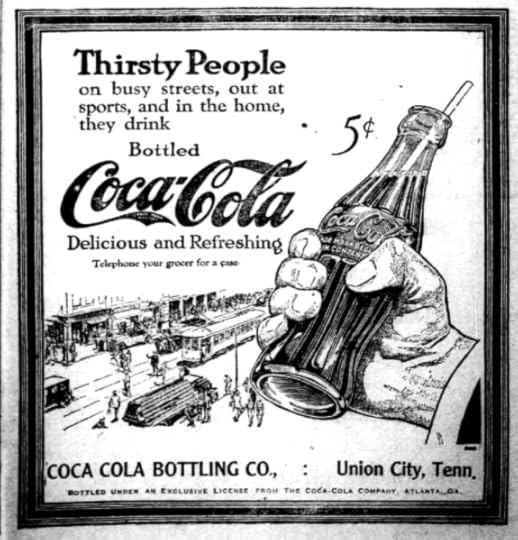
Patent medicine makers came to be considered quacks, but what exactly is a quack? According to my Webster’s Collegiate Dictionary, which is based on Webster’s Third International, a quack is simply “a pretender to medical skill.” The word derives from the archaic Dutch word kwakzalver, or “hawker of salve.” In olden times kwak meant “shouting”; quacksalvers touted their wares in a loud voice in the market.
Today “health fraud” and “pseudo-science” are practically synonyms for “quackery,” which is defined as the practices or pretensions of a quack, but the matter is by no means simple. Orthodox medicine has always been suspicious of alternative treatments, and only with great reluctance came to acknowledge a certain validity in acupuncture and chiropractic, and this last only after a prolonged legal battle. Because the American Medical Association had labeled chiropractic “an unscientific cult” and urged physicians not to associate with its practitioners, five chiropractors sued the AMA for violations of the Sherman Antitrust Act. The federal lawsuit Wilt v. American Medical Association ended in 1987 with a judge’s ruling that the AMA had indeed violated a section of the Sherman Antitrust Act and engaged in “a long history of illegal behavior”; while declining to decide whether or not chiropractic had any validity, the judge issued a permanent injunction against the AMA to prevent such behavior in the future.
But that was not the end of it. Today quackbusters, often self-appointed, are rampant. Prominent among them is the organization Quackwatch, founded in Pennsylvania in 1969 by Stephen Barrett, a now retired physician, to combat “health-related frauds, myths, fads, fallacies, and misconduct.” Its targets have included acupuncture, Ayurvedic medicine, alternative medicine, herbal medicine, homeopathy, chiropractic, dietary supplements, and organic food – so wide a range of products and services, including traditional practices going back thousands of years, as to provoke serious doubts. Anything alien to modern mainstream medicine seems to merit attack. Despite numerous awards, Quackwatch and its founder are highly controversial and, in my opinion, deserve just as much scrutiny as the practices they attack.
My personal take: following my surgery for colon cancer in 1994, I was told that my cancer had a 40% chance of recurring, but that chemotherapy could reduce this to 20%. But the idea of lying there passively at intervals over a period of weeks, while they dripped an alien substance into me, did not appeal, least of all the added possibility of unpleasant side effects. As an alternative, I embraced a nutritional approach and began following an anticancer vegan diet that included cruciferous vegetables, garlic, soy foods, and lots of fruits and vegetables generally, preferably organic. This approach involved no nasty side effects and I am still on it today; the cancer has not returned. So when it comes to a debate regarding the pros and cons of alternative medicine, I have to come down emphatically on the side of pro. Friends of mine with cancer have gone the orthodox way, enduring chemotherapy and radiation and their hideous side effects; not one of them survived.
I don’t deny that there are cancer quacks out there, and other quacks as well. But to pin that label to all forms of alternative medicine is unwarranted; some of that stuff works. There are times for mainstream practices, and times for alternatives; both offer benefits, and both have limitations. The consumer/patient has to make informed decisions. But watch out where you get your information; make sure the source is trustworthy, and not simply the self-interested agent of the medical/ industrial complex (yes, it really does exist) or its opponents. As always, caveat emptor applies.
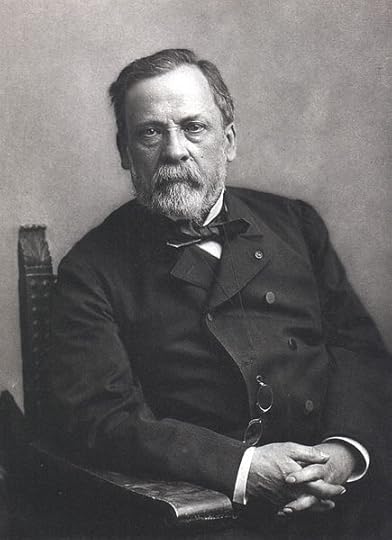 Louis Pasteur -- a quack? Meanwhile, let’s be glad that the patent medicines of yore have been buried in the dust of time; there’s little doubt that their promoters – yes, even the original sponsors of that beloved American icon, Coca-Cola – were quacks. On the other hand, it’s worth remembering that Louis Pasteur, the pioneering French microbiologist, and Linus Pauling, twice a Nobel Prize winner, who advocated massive doses of Vitamin C for treating various diseases, including cancer and the common cold, were both denounced as quacks in their lifetime. As was John Harvey Kellogg, a promoter of vegetarianism and, with his brother, the creator of Kellogg’s Corn Flakes, a staple of my childhood as essential to the American scene and psyche as Coke (and I don’t mean cocaine).
Louis Pasteur -- a quack? Meanwhile, let’s be glad that the patent medicines of yore have been buried in the dust of time; there’s little doubt that their promoters – yes, even the original sponsors of that beloved American icon, Coca-Cola – were quacks. On the other hand, it’s worth remembering that Louis Pasteur, the pioneering French microbiologist, and Linus Pauling, twice a Nobel Prize winner, who advocated massive doses of Vitamin C for treating various diseases, including cancer and the common cold, were both denounced as quacks in their lifetime. As was John Harvey Kellogg, a promoter of vegetarianism and, with his brother, the creator of Kellogg’s Corn Flakes, a staple of my childhood as essential to the American scene and psyche as Coke (and I don’t mean cocaine).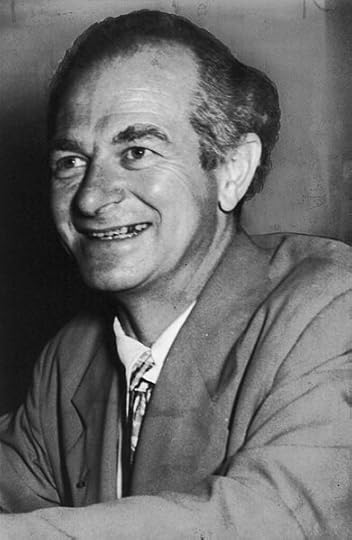 Linus Pauling, twice a Nobel Prize
Linus Pauling, twice a Nobel Prizewinner -- and a quack?
Coming soon: Where radar, transistors, sound movies, television, and so much else were pioneered right here in the West Village, while scandalous things happened nearby.
© Clifford Browder 2015
Published on August 02, 2015 05:22
July 26, 2015
190. The Village Nursing Home: Auntie Mame and Guinness Stout
On my way to my dentist in the 1960s and 1970s, I walked past the big six-floor red-brick building at 320 West 12thStreet that housed the Village Nursing Home, and on sunny days I usually saw some of the residents sitting in wheelchairs out on the sidewalk in front, getting a bit of fresh air (if “fresh” is appropriate for New York City air). When my dentist, whose office was just across West 12th, told me of making visits there to tend the residents, I asked him how it was. He gave a mixed review, saying that some of the staff were truly committed, while for others it was just a job, which is probably the case with most nursing homes. At least, no horror stories emerged from there, so far as I recall.
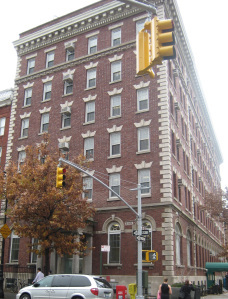 The Nursing Home building today.
The Nursing Home building today.Two of its residents were legendary in the Village. Marion Tanner, a graduate of Smith College and onetime actress often described as the inspiration for Auntie Mame, was made famous when her nephew, under the pen name Patrick Dennis, allegedly wrote about her in a best-selling 1955 novel that became a Broadway play starring Rosalind Russell (I saw it in 1957, loved it), then a movie that became a Broadway musical that in turn became a movie. Ms. Tanner at first embraced the notion that she was the model for the eccentric, fun-loving Mame and coasted on it for quite a while, then distanced herself, insisting that she was a nicer person than Mame. But as late as 1977 she was photographed in the nursing home, white-haired and smiling benignly, under a photo of Rosalind Russell in the film.
Whether or not she was the model for Mame – accounts differ -- she was certainly a colorful Village eccentric, opening her home at 72 Bank Street to struggling artists, writers, freethinkers, and radicals (“Bohemian types,” she called them), whom she encouraged in their careers. But in time she loosened her standards and also let in derelict drunks, ex-inmates, addicts, and shopping-bag ladies. The house finally became a shambles, strewn with garbage and reeking of urine. There was no lock on the front door, so while she would be off in a corner doing yoga and meditating, all kinds of people would be in and out of the house getting a free meal in the kitchen; the silverware soon disappeared. Her nephew shared the dismay and disgust of the neighbors, and discontinued the monthly stipends he had been sending her. She herself by now was sleeping on the top floor in a black sleeping bag full of roaches.
Playing Lady Bountiful to these nonpaying guests took its toll financially as well. In 1964, unable to keep up the mortgage payments, Ms. Tanner lost the house and, along with all the residents, was evicted. By now, dowdy and straggly-haired, she herself looked more like a bag lady than Rosalind Russell’s elegant Mame, and she was on crutches as well, having broken her leg. But on the day of the eviction she made sure the press was on hand, for she relished publicity. The new owners hired a crew of four men to work twelve-hour days for a week cleaning and fumigating the house, and when they moved in, there was a crunch of dead roaches under their feet.
Following the eviction Ms. Tanner moved into Bierer House, a halfway house for the emotionally troubled in Chelsea, where she was supposed to look after things while the owner was away during the day at work. She stayed there for thirteen years and seems to have made a hit with the tenants. In 1977, suffering from increased physical deterioration and senility, she found refuge in the nursing home, where her regal manner soon made her one of the stars; among her many visitors was none other than First Lady Rosalynn Carter, on an official visit. But when, against Ms. Tanner’s fanatical will, the home’s assistant administrator had to wheel her out of her room so workman could proceed with much-needed renovations, she spat in the woman’s face. In 1985, two months after a severe stroke, she died in the home at age 94.
Marion Tanner was seen by some as a wonderful person, and by others as haughty, arrogant, and difficult. Said the young deputy sheriff who evicted her, “She’s an amazing woman. There’s no place left in our society for a person like her. It’s too bad. In an earlier time she might have been a saint.” When a relative was informed of her passing, his only comment was, “Good.” But at a memorial service for her at the Cathedral of Saint John the Divine, Al Carmine of the Judson Memorial Church gave the eulogy. “In her presence,” he said, “things glittered.”
When I checked out her Bank Street address recently, I was surprised to find it was only a five-minute walk from my building on West 11th and Bleecker. It’s a plain three-story red-brick building, and no plaque identifies it as the onetime residence of the alleged prototype of Auntie Mame. Maybe, even after all this time, the neighborhood would just as soon forget about the antics of Ms. Tanner and her waifs and strays.
The other legendary resident of the Village Nursing Home was Genevieve Camlian, who in 1977 attributed her living to the age of 93 to her daily ration of Guinness Stout, the famous Irish dark beer that is marketed worldwide. In earlier days she had run about doing fortune telling based on the I Ching, the ancient Chinese divination manual; one young man who encountered her called her an “Irish witch.” Despite failing eyesight, after lunch at the nursing home she would trek down West 12thStreet to the No Name Bar for her Guinness, which she, a native of Belfast, described as a “nutritional Irish drink.” The bar’s owner, who let her run up a tab, had been captivated by the way she read poetry – she especially loved Yeats -- with her Irish lilt, and some twelve years earlier had arranged for her to enter the nursing home. Little is known of her life before that.
Long before I heard of Marion Tanner’s residing there, I had heard of Ms. Camlian’s residence at the home and her daily imbibing of Guinness. In researching this post I wondered if the two had ever become acquainted, and imagined that a convergence of all that free-living eccentricity would have been dynamic, even explosive. Then I learned that they had indeed known each other before, shared an interest in the occult, and “palled around” together, but by the time they were in the nursing home they detested each other and were no longer speaking; two prima donnas in one nursing home was probably one too many. But the media loved them, and they were often mentioned in articles and TV news spots about the nursing home’s lack of funds and imminent demise; as a result, contributions poured in and helped save the home.
New to the Village in the 1960s, I assumed that the nursing home had always been there, and that it always would be, which shows my ignorance and naiveté. Like all old New York buildings, it had a long history, and that history was – and is -- still unfolding.
The building that later housed the Village Nursing Home was built in 1906 by the wealthy New York City merchant William Martin as a residence for the young unmarried women who in those days worked in shops and department stores or in apparel and millinery factories, earning barely enough to buy food, much less pay rent. Named the Trowmart Inn, the building on the outside was the same one I see today, a six-story red-brick building with granite facing and terra-cotta trim. It could accommodate 400 women, each of its 10-by-12-foot rooms having a bed, a dressing table, a washstand, a table, and a couple of chairs: hardly luxury housing, but for working girls of the time, modest but comfortable accommodations.
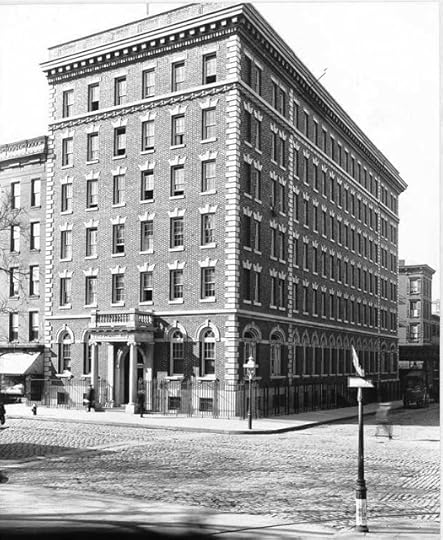 The Trowmart Inn.
The Trowmart Inn.Museum of the City of New York
The building also had a spacious dining room, bathrooms, laundry facilities, a library, a full-time nurse, and six ground-floor parlors where the residents could entertain gentlemen callers, since Mr. Martin thought that the best solution for the working girl was a respectable marriage. Rent was $3 a week for a shared room, and $4 for a single, and included breakfast and supper. Staying out late was discouraged; the elevators stopped running at 11 p.m. And under no circumstances were gentlemen to be entertained above the ground floor. To be eligible, a woman had to earn less than $12 a week and be under age 35. Within a year the hotel was full.
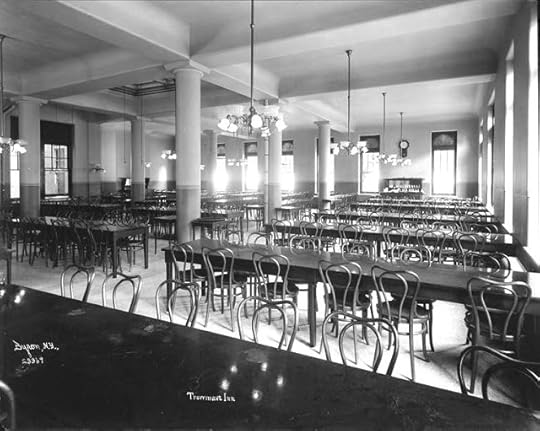 The dining room.
The dining room.Museum of the City of New York
Life at the Trowmart Inn was hardly dull. Dances were held in the main parlor three times a week, and silk hats and frock coats abounded, indicating that the gentlemen callers were of a certain status; to find favor with the girls, a gentleman needed to don his cleanest shirt and highest collar and, for a final touch, an artificial gardenia pinned to his buttonhole. Many a ragtime romp ensued, and Mr. Martin’s goal was no doubt attained when, discreetly in the ground-floor reception rooms, marriage proposals were forthcoming.
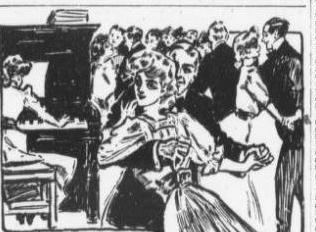 A dance at the Trowmart, 1908.
A dance at the Trowmart, 1908.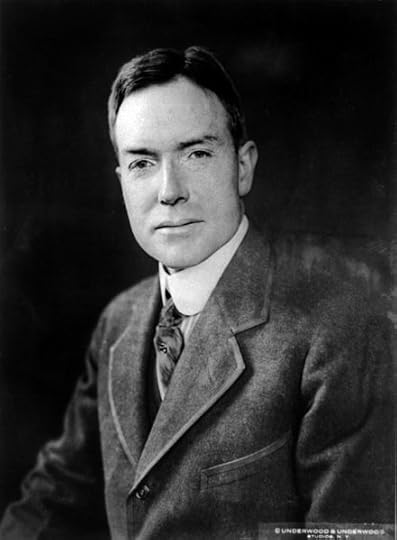 John D. Jr., in 1920. But World War I brought change, for the U.S. government took over the hotel and used it to house the nurses and male attendants of a nearby army hospital. With the war’s end, these residents moved out and the Trowmart Inn sat empty. Then in 1920 John D. Rockefeller, Jr., donated $300,000 to the YWCA to buy the inn, renovate it, and reopen it for working girls. Renamed Laura Spelman Hall in memory of the benefactor’s late mother, an abolitionist and philanthropist, the renovated building had 258 larger rooms for what were now termed “business girls.”
John D. Jr., in 1920. But World War I brought change, for the U.S. government took over the hotel and used it to house the nurses and male attendants of a nearby army hospital. With the war’s end, these residents moved out and the Trowmart Inn sat empty. Then in 1920 John D. Rockefeller, Jr., donated $300,000 to the YWCA to buy the inn, renovate it, and reopen it for working girls. Renamed Laura Spelman Hall in memory of the benefactor’s late mother, an abolitionist and philanthropist, the renovated building had 258 larger rooms for what were now termed “business girls.” As the years passed, times changed again; the need for women-only hotels declined, and the purpose of the Laura Spelman Hall became obsolete. In 1958 the building became the Village Nursing Home, the only such home in the Village, with a private, for-profit operator. But financial woes beset it from the outset, and it had trouble meeting government standards. (Wikipedia states that in the early 1970s the owner absconded with the home’s funds, but I’ve found no confirmation of this.) Threatened with closing in 1977, it was saved by a community effort that got help even from First Lady Roslyn Carter. “Save our nursing home” was the cry, inspiring neighbors to hold cookie sales and restaurants to donate $275,000 to buy the building, and a coalition of church groups and social agencies to form a nonprofit organization, Village Care of New York, to run it.
Village Care grew impressively with time, but in 2004 it announced that it would close the facility and open a network of community residential health-care sites called SeniorLife Choices. The building had become cramped and outdated, with water damage and cracked walls; in keeping with the latest trends in health care, the new facilities would have more of a family feeling and less of an institutional one. Clearly, this was a concerted effort to change the public image of nursing homes, which were often viewed with suspicion and contempt.
In 2007 the building was sold for $33 million to FLAnk, a condominium developer, which waited several years until Village Care, facing construction delays at its new Houston Street facility, could leave, then gutted the building and created ten spacious units, including two duplex penthouses. Thanks to the delay, the timing was right, for the luxury housing market, crippled by the Great Recession of 2007-2009, was now reviving with a roar. Brought to market in June 2013, the units – “townhouses in the sky,” as the developer described them -- were soon sold for prices ranging from $8.75 million to $31 million, prices that, for the West Village, were without precedent. Now christened the Abingdon, the building offers a 24-hour doorman, a gym, a sauna, and private basement storage rooms for each unit, not to mention fine views of Abingdon Square Park across the street and, for the penthouses, the Hudson River.
And Village Care? In 2010 the Village Care Rehabilitation and Nursing Center, to use its full name, opened its new facility at 214 West Houston Street, between Sixth Avenue and Varick, where it serves not as an end-point facility, but rather as a place where patients get rehabilitation and recovery care that prepares them to return home. The 6-story, 105-bed facility is the first newly built skilled nursing facility for seniors in Manhattan in more than half a century. On each floor there is a “commons” area where patients can socialize with other patients, dine, relax, and visit with friends and family. A healing bamboo garden, offering a place for quiet social interaction and contemplation, reflects Village Care’s determination to offer “with it” twenty-first-century healing, as opposed to the traditional institutional atmosphere that characterized the old Village Nursing Home. And Village Care has other facilities as well, treating a total of 14,384 patients in 2014.
So ends, for now, the saga of the Village Nursing Home, aka the Trowmart Inn, Laura Spelman Hall, and now the Abingdon. When the scaffolding was removed in 2013, the old 607 Hudson Street entrance was revealed, its rounded arch flanked by columns and, carved in stone above, the words LAURA SPELMAN HALL. I see it every day when I pass what was once a reasonably priced residence for young working girls and is now a luxury condo.
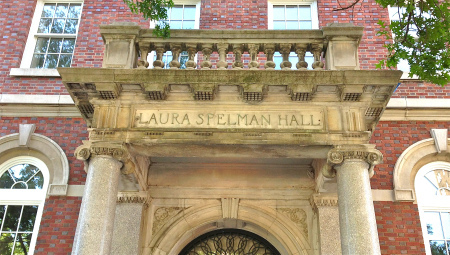
For the new residents of the Abingdon who don’t enjoy a view of the Hudson River and sunsets over New Jersey, there is a view just across Hudson Street of Abingdon Square Park. A small triangular park bounded by West 12thStreet, Eighth Avenue, and Hudson Street, it has its history, too. Originally it was part of a 300-acre estate bought by Sir Peter Warren, a British naval officer, in 1744. When his daughter Charlotte married the 4thEarl of Abingdon in 1766, she received land in the area as part of her dowry, and the site became known as Abingdon Square. After independence, in 1794 the City Council voted to replace all British place names, but the name of the square was spared, since the Earl and his wife had sympathized with the rebellious Americans, and he had argued in Parliament against British policy in the thirteen colonies.
In 1831 the Common Council decided to make a public park of the site and subsequently bought the land and enclosed it with a cast-iron fence that still stands today. Then in 1886 the renowned architect Calvert Vaux was hired to create a new design for the park, which became a center of community life and the site of well-attended public concerts. But in 1931, years before the creation of the Greenwich Village Historic District, a row of charming old red-brick homes on the north side of West 12thStreet was demolished to make way for the massive 16-story brick apartment building at 299 West 12thStreet that towers oppressively over the park today, its awninged entrance presided over by a uniformed doorman.
But all was not lost, for in 2003-2004 the park was renovated so as to restore its nineteenth-century atmosphere, with 1850s-style benches, bluestone walkways, and three cast-iron light poles replicating the gas streetlamps of another day. Founded in 2000, the Abingdon Square Conservancy, a nonprofit community organization, now works in cooperation with the city to maintain the park, and I can attest that it does so magnificently, with frequent plantings of fresh flowers in season. And, just outside the fence, on Saturday mornings throughout the year a greenmarket appears that I visit regularly to get bread and, in season, cherries and blueberries and apples from the farmers. Presiding over the Park is the Abingdon Square Doughboy, a statue by Philip Martiny honoring the dead of World War I, whose dedication in 1921 was attended by 20,000 people. Today, alas, its worn inscription is almost unreadable, and the statue itself is barely noticed by passing strollers, cell-phone addicts, and dog walkers.
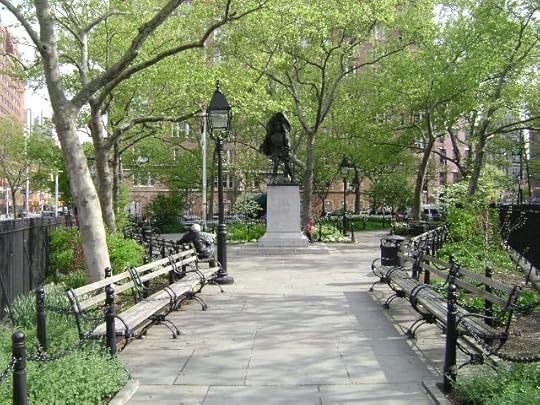
So if the residents of 299 West 12thStreet and the outrageously wealthy new occupants of the Abingdon enjoy fine views of the park from their lofty domiciles, so do I when I stroll through there almost daily, and I don’t pay an exorbitant rent for the privilege.
Coming soon: Patent Medicines: Cocaine Toothache Drops (meant specifically for children), Hostetter's Bitters (why did it make you feel so good?), Dr. Williams' Pink Pills for Pale People, and oh yes, Coca-Cola and 7 Up.
© 2015 Clifford Browder
Published on July 26, 2015 04:33
July 18, 2015
189. The Need to Kill
I’ve become a killer. This will surprise, even shock, my friends, who think of me as a reasonably calm, peace-loving character, but it’s true. And I kill morning, noon, and night, though especially at night, when my victims are most plentiful. I kill, and without a qualm, without even a hint of a flicker of conscience. Not exactly with joy, but at least with a grim satisfaction. And without mercy.
What do I kill? Bugs. “What kind of bugs?” you ask. I don’t know, just bugs. Smaller than American cockroaches, some bigger than ants, some smaller, even minuscule. Different kinds, though I can’t differentiate them, just call them bugs. But maybe they are German cockroaches (Blatella germanica), smaller than other species of roaches, though I haven’t heard them speaking German.
 German cockroaches. But they're really much smaller than this.
German cockroaches. But they're really much smaller than this.Saphan
 This is the way I like to see them.
This is the way I like to see them.But I don't use K300.
Gadi Vishne Why do I kill them? Because they’re everywhere, defy gravity by crawling up walls and on the ceiling of my apartment, won’t let me alone, and don’t pay rent. In the bathroom in the morning they’re crawling over my toothbrush or hiding under the soap. In the medicine cabinet I find their egg cases in the pill boxes and bandage wrappings, and their unholy droppings on everything. As I breakfast in the kitchen, they try to feast on crumbs from my bread or a stray bit of banana, till I chase them away and they disappear under the table’s surface, where I can’t pursue them. And as I continue to breakfast, they come back again, try to sneak another tiny bite. Finally, as the day wears on, they disappear into their hidden sanctuaries: any crack or crevice in the walls of my ancient apartment, any bit of clutter, any remote corner of a shelf, any cluster of bottles, any pile of newspapers, any heap of plastic bags, and above all the dark infernal recesses of my ancient stove’s ancient oven.
“Doesn’t an exterminator come once a month?” you may ask. Of course. His spraying here and there may result in a few small corpses in a day or two, but so what? They are legion, and they proliferate. The exterminator leaves a stack of glue traps that I dispose of at strategic points in the kitchen, and within days the traps reap harvests of stuck wigglies waving their antennae frantically. Their death throes seem to entice more to join them, till the traps are so full there’s hardly any room for more. On one 5-by-8-inch trap by the kitchen garbage can I’ve counted some 400 bugs in all, most of them tiny, some 50 of them bigger. But so what? They persist, they abound. Through sheer numbers, I’m told, the insects will inherit the earth. If they haven’t already.
And so, in self-defense, I’ve become a cunning and ruthless slaughterer, determined that these marauders shall, in great numbers, die. When at night, heeding the bladder imperative, I traipse to the bathroom and suddenly turn the light on, I have my trusty slammer handy – an empty pill bottle with a flat-topped cap – and bam bam bam I massacre as many as I can, as they flee in all directions. They have the best chance of escaping if I catch them on a wall, for my slammer is less effective against a vertical surface. On the wash basin I usually bam bam bam get several as the others scurry to safety, but if I find some in the bathtub, they are doomed, for their dark little bodies stand out sharp against the white enamel, they have a long distance to go before reaching safety, and I am determined that they shall die the death. And they do. And if I then go into the kitchen, their favorite feeding ground at night, and turn the light on, I convulse their midnight revels in the sink, as bam bam bam bam bam I wield my kitchen slammer, my Excalibur, and perpetrate a massacre of dozens, scores. Some escape, many don’t.
 My Excalibur. Minus the vitamin B's, of course.
My Excalibur. Minus the vitamin B's, of course.Ragesoss Do I enjoy these massacres? Yes and no. My actions are strictly in self-defense, so I don’t consider myself a born warrior or sadist; when I mash them, their death is instantaneous, no writhing, no pain. I don’t feel joy, but I do feel the aforementioned grim satisfaction, and if they annoy me enough, at least a momentary flash of anger. And a sense of power, since I loom large over them like Yahweh smiting the Midianites. And even, if they get on me (as they occasionally do), a touch of loathing and hate. But if, as they flee when I turn the light on, some of them run onto a glue trap cunningly positioned by me and get stuck there, or if, in the morning, I find a cluster of them – anywhere from five to twenty -- in an empty yogurt container in the garbage, and I spray them and kill every last one of the wee beasties, then, I confess, my grim satisfaction extends to the outskirts of joy.
Mostly, it’s a game, and I’ve gotten fairly good at it, know where to place the glue traps and where to put my slammers – one in the bathroom and one in the kitchen – so they’re immediately available when the light goes on. I always clear the kitchen table, so as to have a wide and unobstructed killing field, and if I find the creepy-crawlies in the toilet bowl – and I often do – I feel a kind of glee when I flush them away to oblivion. And glee again when I find an empty egg case and some forty tiny creatures stuck fast in a trap. And if I leave a coffee mug half full of water in the kitchen, in the morning I’m bound to find one, two, three, up to five winged corpses floating in the water. (Yes, some have wings, though they never fly.) Do I pity my victims, drowned or mashed? Hardly. For me, they aren’t capable of true feelings. So what are they? Bundles of instincts, tiny machines. As for Blake’s wonderful line, “For everything that lives is holy,” I dismiss it as a beautiful lie. Poets are notorious liars.
There was indeed a killer in my family, but it wasn’t me; it was my father. But to be fair, I should say a hunter and fisherman, for he loved the outdoors and loved to hunt and fish. Fishing usually meant long hours on a quiet lake in northern Illinois or Wisconsin, sitting quietly in the sun, waiting, waiting, waiting. Forced to accompany him, I was totally, utterly bored. Did I ever catch anything? Once, as I recall, some small, flat finned thing that didn’t look like much, but I suppose we had to cook it and eat it. But when my father, on his annual fall vacation, went to a lake in northern Wisconsin for two weeks, he caught plenty and shipped them back in ice.
As for hunting, when I was sixteen he taught me to shoot a shotgun. I didn’t like it, for the recoil made my shoulder ache, but I did learn a thing or two about guns. He took good care of his guns and used them carefully, always carrying them with the barrel toward the ground, except when about to shoot. From fall through spring he took me and my older brother to his gun club, where sportsmen assembled to sip coffee, swap hunting stories, and shoot trap, aiming at clay pigeons flung from either of two trap houses. When they hit a pigeon dead on, it vanished in a puff of dust, and discreet congratulations were extended. It was a man’s world, with one exception: the wife of a sportsman who was just as into shooting as her husband; my father, always quick with nicknames, called her “Pistol-Packin’ Momma” and, like all the men, accepted her completely. My mother, if she went along for the ride, never set foot in the clubhouse, preferring to remain in the car with a good book.
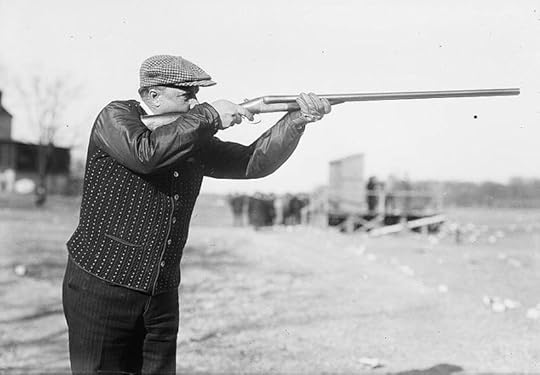 Not my father, but the exact same look.
Not my father, but the exact same look.For hunting my father took me into bare autumn fields, hoping for a shot at a flock of blackbirds or a lone scurrying rabbit. No blackbirds came our way, and if a rabbit did finally show up, I never got a shot. Nor did I want to, having no desire to kill anything. When one of my schoolteachers lamented the killing of deer – “those beautiful creatures” -- for sport, I queried my father about it. Far from dismissing her as a silly old maid who knew nothing about hunting or life, he explained quietly that hunting is an instinct, stronger in some people than in others. True enough: strong in my father, but weak to nonexistent in me. And so, bugs notwithstanding, I insist that I am not a killer. Left to my own devices, I wouldn’t hurt a flea. (Unless, of course, it was on me.)
 A luna moth. Too eerily beautiful to kill. On my many hikes in parks and woodlands, I never killed an insect, with the exception of a stray mosquito, and then in self-defense. I loved watching butterflies, and once stared in awe at the haunting beauty of a luna moth sleeping on a tree trunk, but I never tried to catch, much less kill, any of them. And if I saw a nectar-seeking honey bee struggling to free itself from the sticky pollen of the milkweed, I would take a twig and gently free it so it could fly away. But there was one exception: if, in the late spring, I saw the white (often dirty white) tent of the tent caterpillar in the branches of a tree, I would knock it to the ground with a stick and then trample the teeming, writhing mass of tiny caterpillars inside it, so they couldn’t defoliate the nearby trees. Something about that writhing mass of living things alienated, even disgusted, me – a feeling that I have rarely felt in nature. Perhaps I should have let nature take its way, but I love trees and hate to see their leaves consumed by that horde of tiny mouths.
A luna moth. Too eerily beautiful to kill. On my many hikes in parks and woodlands, I never killed an insect, with the exception of a stray mosquito, and then in self-defense. I loved watching butterflies, and once stared in awe at the haunting beauty of a luna moth sleeping on a tree trunk, but I never tried to catch, much less kill, any of them. And if I saw a nectar-seeking honey bee struggling to free itself from the sticky pollen of the milkweed, I would take a twig and gently free it so it could fly away. But there was one exception: if, in the late spring, I saw the white (often dirty white) tent of the tent caterpillar in the branches of a tree, I would knock it to the ground with a stick and then trample the teeming, writhing mass of tiny caterpillars inside it, so they couldn’t defoliate the nearby trees. Something about that writhing mass of living things alienated, even disgusted, me – a feeling that I have rarely felt in nature. Perhaps I should have let nature take its way, but I love trees and hate to see their leaves consumed by that horde of tiny mouths.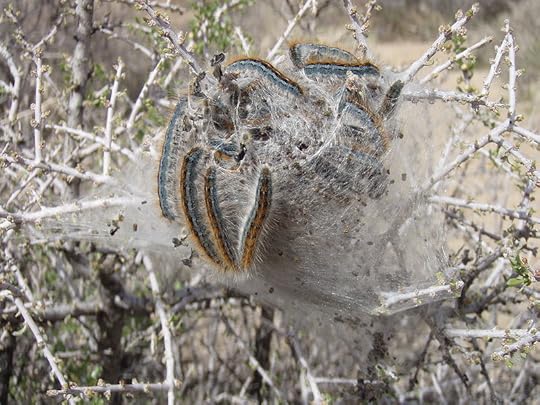 They make me want to kill.
They make me want to kill.Brocken Inaglory
 Sparrow hawks. Let nature take its way: there is mystery in that process, and death. Once, toward dusk on Monhegan Island in Maine, I was watching a flock of migrating sparrows feeding on birdseed that Bob and I had scattered on the lawn outside our cabin window, when out of nowhere a sparrow hawk swooped down to seize one of them as the others fled. In the dim, fading light I could barely see the hawk – really a small falcon, the kestrel – spread its tail to steady itself on the ground, as it consumed its prey. It was unsettling, mysterious, awe-inspiring.
Sparrow hawks. Let nature take its way: there is mystery in that process, and death. Once, toward dusk on Monhegan Island in Maine, I was watching a flock of migrating sparrows feeding on birdseed that Bob and I had scattered on the lawn outside our cabin window, when out of nowhere a sparrow hawk swooped down to seize one of them as the others fled. In the dim, fading light I could barely see the hawk – really a small falcon, the kestrel – spread its tail to steady itself on the ground, as it consumed its prey. It was unsettling, mysterious, awe-inspiring.And when I read about how a rattlesnake sinks its venomous fangs into a startled squirrel, waits patiently as the squirrel scurries off, each bound pumping the venom deeper till the squirrel droops, drops, and the snake follows at leisure and slowly consumes its prey head first, I get that same feeling of horror mixed with mystery and awe. Killing is a part of nature’s way, common and necessary in the processes of life. But is it necessary among humans as well? Here I will bring us back to New York, to the draft riots of July 1863, during our Civil War, when, even as a great battle raged at Gettysburg, Irish workers in the city rose up against the newly initiated draft, destroyed the building where the draft was being processed, looted and burned every other building they associated with the draft, held off the outnumbered police, and lynched every black man they could get hold of, blaming blacks for the draft and the war. Some of their victims were hanged over a fire, around which the Irish women, by all accounts more savage than the men, danced in a frenzy. The rioters were not drifters and the homeless, but men with steady jobs who deserted their workplace and for three days, joined by their women, raged in the streets. What drove them to this?
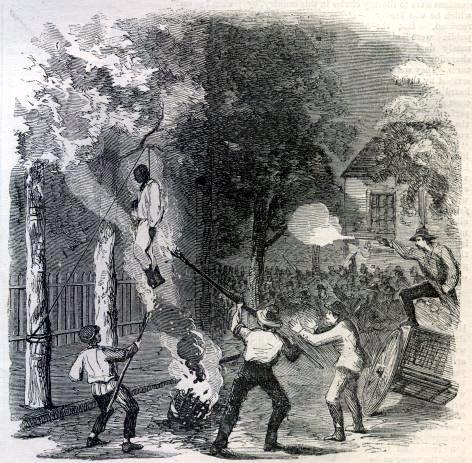 No women here, but they were usually present. A Harper's Weekly print.
No women here, but they were usually present. A Harper's Weekly print.That they resented the draft is understandable. They had come over here to escape famine in Ireland, and to get free of centuries of English rule. Deep in their psyche was a hatred of authority, of government, of being forced to do the will of others, and this hatred transferred to the American government when, desperate to crush the rebellious South, it initiated the draft. And the cry “A rich man’s war, a poor man’s fight” had resonance, since the affluent, by paying $300 for a substitute, could quite legally avoid the draft, whereas the rioters didn’t have $300. One also has to suppose a deep-seated racism that suddenly, under these exceptional circumstances, flared forth. There were a few white victims too: policemen, soldiers, anyone who interfered with the rioters, anyone who looked like a “three-hundred-dollar man.” Yet when, after three days of riots, the military arrived to restore order, the rioters went back to their jobs and resumed their role of quiet, steady workers.
Is there a killer buried deep in all of us, or do only a few of us nurse this hidden urge? My pen pal Joe, while doing time in North Carolina, wrote a series of vignettes about prison life, including an unforgettable one entitled “Killer Friends.” In the vignette he explains that, when doing time, you never ask another inmate what he’s in for; to do so is to court danger. But sometimes an inmate chooses to tell another inmate, and so it was that Joe heard the stories of several convicted murderers. One of the stories especially impressed me. A young inmate told Joe how, at age fifteen, he had asked his parents for a motorcycle for Christmas, and they said they would see what they could do. But when Christmas came, his parents explained that, regretfully, they hadn’t been able to afford it. Instantly consumed with rage, the young man went to his room, got out his shotgun, loaded it, came back to the living room, and killed both his parents as they were sitting on the couch. Then, panicking, he grabbed all the money in the house and rushed to the garage to get into the family car and flee. And there, in the garage, he found a shiny new motorcycle; his parents had wanted to surprise him. He is serving two life terms.
What made this young guy tick? I don’t know if he had a history of violence, but quite possibly he did not. I can understand his disappointment, maybe even his rage, but I can’t understand a rage that precipitates murder. Between me and him a vast chasm opens up.
Another of Joe’s stories is about a man who killed his wife in a drunken rage, when she announced she was getting a divorce. He then put her body in his car, drove to some nearby woods, and buried her there. But two weeks later the state police came knocking on his door to report that a bear had dug up her body and devoured some of it; could he explain how she came to be buried there? He then confessed and got a life sentence.
In these accounts of murder two common denominators emerge: the murderers had trouble controlling anger and, closely related, they yielded to impulse. In both of them there was an appalling lack of judgment, an inability to think of consequences.
Have I ever experienced violent rage? Just once, years ago, when a waiter in a crowded West Village gay bar harassed me, telling me not to stand here or there, not to move around the bar – harassment so intense that I finally just handed him my half-finished beer and walked out. Why he chose to bother me I have never fathomed; there was no history of antagonism between us, and I was behaving no differently from any other patron of the bar. But I felt intense anger and stalked the streets for some time nursing it, hoping to meet a friend to whom I could pour out my story and, in so doing, temper my rage. Alas, no friend showed up, so in the end I just went home.
This is a trivial story, but it demonstrates that, when consumed by rage, I never contemplated any act of violence, wanted only to get rid of my rage. I could have, at some cost, splashed my beer in the waiter’s face, or poured it on the floor, or dropped the bottle hoping it would smash, but none of these acts occurred to me. Deep in me there was some kind of safety valve, some instinct of self-preservation that was stronger than any impulse to retaliate. This safety valve, I assume, is deep in most of us, but absent or ineffective in a few. We all feel anger at some point, often justifiably, but we don’t all resort to violence or kill.
I have seen the face of rage. Once, long ago, when I was having lunch in a crowded student restaurant in Lyons, France, we all suddenly heard a great clatter at another table. Instantly a burly kitchen worker rushed over to the table where the disturbance was, and found two students in a confrontation. One yelled feverishly, “He can’t take a joke!” The other said nothing, just glared, his features contorted with rage. Fortunately, the burly man calmed things down, and we all were able to resume our lunch. But I’ve never forgotten the look of the angry student, his reddened features warped with rage – rage on the verge of violence. If the burly worker hadn’t intervened, who knows what might have happened? Rage is ugly, it distorts. No wonder it’s one of the seven deadly sins.
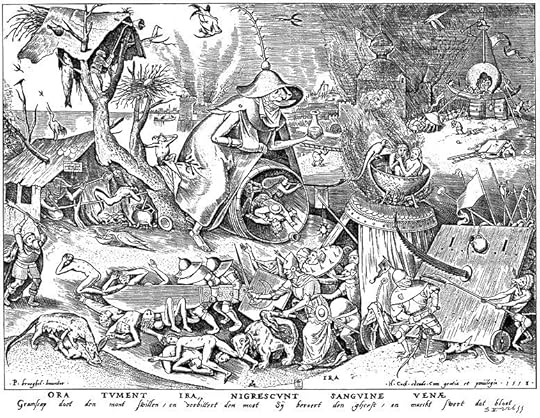 The sin of Wrath, as illustrated by Pieter Brueghel the Elder:
The sin of Wrath, as illustrated by Pieter Brueghel the Elder: soldiers massacring or torturing all they encounter.
Are killers born or made? Is murder deep in our bone and blood, or is it a product of social forces acting upon us? Some of us are born hunters like my father, and I would add that there are born writers, artists, dancers, gamblers, rebels, healers, scholars, and reformers. From an early age I was writing – nonsense of course, but writing – so I’m convinced that I was born a writer, and circumstances then facilitated the urge. So are some of us born killers, or at least born destined to commit an act of violence? We don’t want to think so, but at times we’re inclined to assume it. “Leave it to the experts,” you might say; leave it to the sociologists, psychologists, criminologists. But at times we uninformed citizens are forced to have an opinion. When on jury duty, for instance, and hearing a case involving murder. Or as a voter, when called to vote on issues relating to the death penalty.
Once, when doing background research for a novel, I read some books on violent crimes and those who commit them, and was so shocked by some of the serial murderers described, and their early and total commitment to killing, that I ruefully concluded that some of us probably are born killers, or at least predestined to violence. And when, on another occasion, I saw Matthew Brady’s photographs of John Wilkes Booth’s coconspirators, who were tried and hanged following President Lincoln’s assassination, the photo of one of them, Lewis Powell, who had attacked but failed to kill Secretary of State William Seward, struck me; in his hardened features I discerned a killer. Of all Booth’s fellow conspirators, he was the only one who, following Booth’s instructions, made a serious attempt to kill a member of the government.
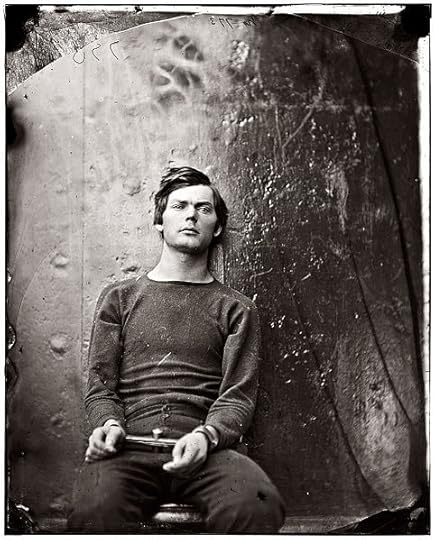 Lewis Powell, after his arrest. Not the Brady photograph, but the same hard look.
Lewis Powell, after his arrest. Not the Brady photograph, but the same hard look.The recurring question of police violence burst into headlines yet again when, on July 14, 2014 – just one year ago -- the police went to arrest Eric Garner, an unarmed African American selling cigarettes illegally on Staten Island. When Garner seemed to resist, officer Daniel Pantaleo wrestled him to the ground and allegedly put him briefly in a chokehold, a tight grip around the neck that is banned by the New York police but that was caught on video by a bystander. Then Garner, lying face down on the ground, said “I can’t breathe” no less than eleven times. Taken to a hospital, Garner was pronounced dead an hour later. The medical examiner ruled his death a homicide, but a grand jury decided not to indict Pantaleo, setting off protests and rallies nationwide, with passionate utterances of “Black lives matter!” and “I can’t breathe!”
Some see police violence – especially against minorities – as the actions of a few bad apples, while others insists that it results from an endemic police culture that countenances such violence and is never held accountable. Once again the question arises: is there an urge to violence, even murder, deep in all of us that circumstances at times activate? And is my satisfaction in killing bugs in my apartment -- trivial as it may seem – a faint echo of that urge? One common denominator emerges: the victims are the Other, some living phenomenon from which the assailant or killer feels completely alienated.
The death penalty is an issue where I flip and I flop. Most of my friends in New York, good liberals, are against it, don’t even think it bears discussion. But me, I waver. Granted, it’s administered unfairly and can be opposed on those grounds alone. And granted, those who are convicted may be innocent, and imprisonment leaves open the possibility of exoneration later. But if, as can happen, there is no doubt about guilt, is the frequent alternative of a lifetime in prison without the possibility of parole – and some or all of it in solitary – really more merciful? I wonder. On the other hand, pictures of an execution can chill me to the quick.
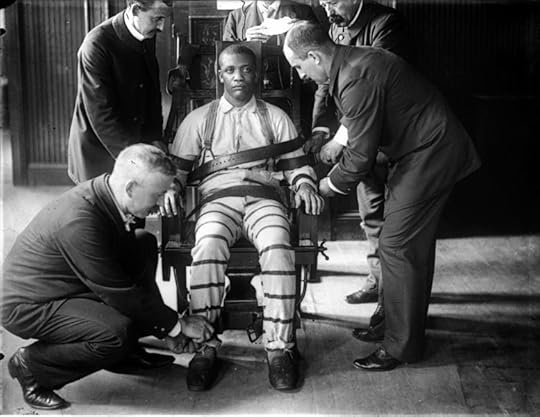 The electric chair at Sing Sing, ca. 1900. As so often, whites executing a black. From time to time I hear of a crime so heinous that I’m inclined to justify a penalty of death. When, last May, four Afghan men were sentenced to death for the mob killing of a woman falsely accused of burning a Koran, the circumstances of the woman’s death were so horrible that I, like many, applauded the sentence. The 27-year-old victim, Farkhunda, was thrown from a roof, beaten to death, and run over by a car, following which the mob set fire to her body and dumped it in a river. And when, two months later, a court overturned the death sentence of the four men, I shared in the worldwide indignation.
The electric chair at Sing Sing, ca. 1900. As so often, whites executing a black. From time to time I hear of a crime so heinous that I’m inclined to justify a penalty of death. When, last May, four Afghan men were sentenced to death for the mob killing of a woman falsely accused of burning a Koran, the circumstances of the woman’s death were so horrible that I, like many, applauded the sentence. The 27-year-old victim, Farkhunda, was thrown from a roof, beaten to death, and run over by a car, following which the mob set fire to her body and dumped it in a river. And when, two months later, a court overturned the death sentence of the four men, I shared in the worldwide indignation.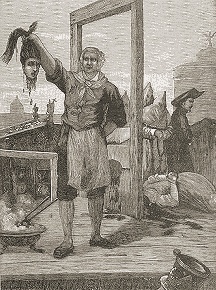 This is how the French Revolution did it. Truman Capote was criticized by some for not doing more to prevent the execution of two young men whom he had interviewed and befriended, and whose story of murdering a family of four in Kansas he had told with great sensitivity in his work of nonfiction In Cold Blood, published in 1966. There was no doubt about the two men’s guilt, and they told Capote how, while hitchhiking after the crime, they were picked up by a lone driver and contemplated killing him and stealing his car. But when the driver also picked up a teen-age hitchhiker, they abandoned their plan, since now they would have to kill two. Reading this, I decided they indeed deserved to die, not just because of the murders they had committed, but because they had been ready to commit another murder as well.
This is how the French Revolution did it. Truman Capote was criticized by some for not doing more to prevent the execution of two young men whom he had interviewed and befriended, and whose story of murdering a family of four in Kansas he had told with great sensitivity in his work of nonfiction In Cold Blood, published in 1966. There was no doubt about the two men’s guilt, and they told Capote how, while hitchhiking after the crime, they were picked up by a lone driver and contemplated killing him and stealing his car. But when the driver also picked up a teen-age hitchhiker, they abandoned their plan, since now they would have to kill two. Reading this, I decided they indeed deserved to die, not just because of the murders they had committed, but because they had been ready to commit another murder as well. One argument against the death penalty that I take seriously is the belief that life is a precious gift that the state has no right to take. But those who present this argument are often advocates of free choice, meaning the right of women to have an abortion, which, no matter how you look at it, is a canceling of human life. And conversely, many who support the death penalty are often right-to-lifers, fanatically opposed to abortion. Granted, the unborn fetus has committed no crime, whereas those condemned to death presumably have. Still, a life is a life. I find these inconsistencies troubling.
Lacking today in our secular society is a sense of the sacred, a reverence for the holiness of life. Or if it still exists, it is often embraced by rigid fundamentalists whose general views many of us find repellent. But perhaps it can be experienced even by secularists in the form of wonder. Which at once brings to mind a famous statement by Einstein, who was not conventionally religious:
The most beautiful thing we can experience is the mysterious. It is the source of all true art and science. He to whom the emotion is a stranger, who can no longer pause to wonder and stand wrapped in awe, is as good as dead – his eyes are closed. The insight into the mystery of life, coupled though it be with fear, has also given rise to religion. To know what is impenetrable to us really exists, manifesting itself as the highest wisdom and the most radiant beauty, which our dull faculties can comprehend only in their most primitive forms – this knowledge, this feeling is at the center of true religiousness. In this sense, and in this sense only, I belong in the ranks of devoutly religious men. (Albert Einstein, Living Philosophies, Simon and Schuster, 1931.)
Only those who have experienced and acknowledged this kind of wonder can reach me with arguments pro or con on matters of human life like abortion and the death penalty. Only to them will I listen; the others are just mouthing their biases.
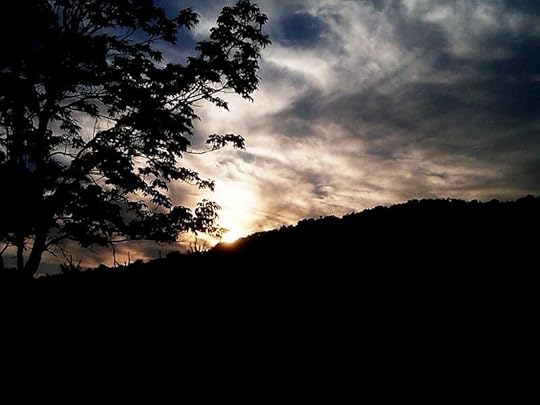 The mysteriousness of nature: a night sky.
The mysteriousness of nature: a night sky.Jffkrider So where do I finally end up? Somewhere betwixt and between, which many will label as wishy-washy. I’m occasionally for the death penalty, which can impart a fearful significance, and almost even a dignity, to death, yet I have grave reservations about it. I’m troubled by abortion, because it involves taking a life, but wouldn’t want it banned, since that would force women into seeking back-alley abortions, with all the risks involved. Issues involving human life are complex and controversial, not easily resolved. Are killers born or made? Perhaps, deep in our psyche, there is a core of mystery that may never be penetrated. Why in our ordinary daily lives most of us, whatever the provocation, do not kill, while a few of us do, seems to defy rational explanation. Theories abound, but aren’t they simply that: theories? I’m leery of those – and they are many – who think these matters simple; I cannot. I join Einstein in marveling at the mysteriousness of life, and in acknowledging that some things are, for us, impenetrable. We must cope as best we can, and humbly, with our dull faculties.
Note on Goldman Sachs: Speaking of killing, Goldman Sachs is a whiz of a bank that in the past has made many a killing in financial markets, as discussed in post #158, “Goldman Sachs: Vampire Squid or Martyred Innocent?” (December 22, 2014). The squid or innocent (as you prefer) has just reported disappointing earnings for the second quarter of 2015, raking in a mere $1 billion, as compared with $2 billion a year ago. The big hit on earnings? $1.45 billion that it set aside for “mortgage-related litigation and regulatory matters.” The bank is in the final stages of reaching a deal with the Justice Department over its sale of mortgage-backed securities before the financial convulsion of a few years ago – a matter too complex for ordinary folk like you (I presume) and me to understand, but one that evidently involved consummate naughtiness. But Goldman will survive and flourish; it always has.
Coming soon: The Village Nursing Home: from shopgirls romping to ragtime, to luxury penthouses with a view of the river. Plus Auntie Mame, and Guinness Stout at age 93. And how did Abingdon Square get its name? And after that, Patent Medicines, among them Coca-Cola and 7 Up. (No, I’m not kidding.)
© 2015 Clifford Browder
Published on July 18, 2015 08:11
July 12, 2015
188. West Village Wonders and Horrors
Recently I visited an old friend who lives in a handsome and well-preserved Greek Revival house, one of several on the north side of Charlton Street between Sixth Avenue and Varick. On the south side of that block, modern brick apartment buildings loom, big and unlovely, contrasting sharply with the charm of the old Greek Revival houses. My friend lives in one with a brownstone stoop, and the interior preserves the features typical of the Greek Revival parlor floor of earlier times: a front and back parlor with a sliding door that can be pulled shut to separate them; two tall windows in back looking out on a garden; two more in front looking out on the street; a handsome fireplace in each parlor; and, in the back parlor, the molded ceiling medallion, ornate yet chaste, from which a gas-lit chandelier probably once hung.
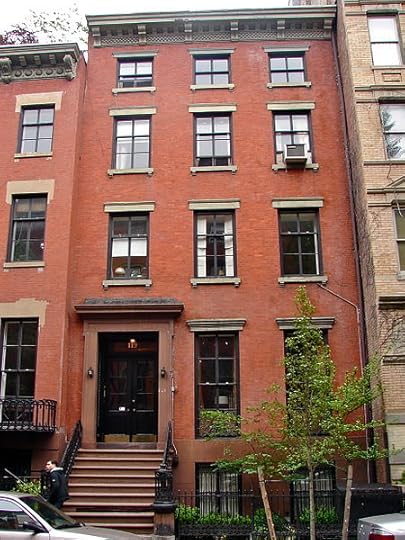 A Greek Revival house dating from 1845.
A Greek Revival house dating from 1845.Greek Revival houses are common in the West Village, and my hostess and I expressed a shared admiration for their clean lines and sober simplicity, all the more evident in her parlors because of their lack of clutter. She had recently visited a friend in an old Federal Style home, with the typical slanting roof with two dormer windows – a style that I find quaint (an awful word) and charming – but by comparison with her own spacious home, she found it cramped to the point of claustrophobic, and dark as well. As we talked in her front parlor, the late-afternoon sunlight was flooding in through the tall front windows, which faced south. A soothing calm prevailed, for those windows admitted no noise from the street. It was a beautiful moment, and I marveled at the clean lines of the uncluttered rooms, the quiet, the tall windows admitting the miracle of light. So who needs luxury housing? This, I thought, is civilized, is how people are supposed to live.
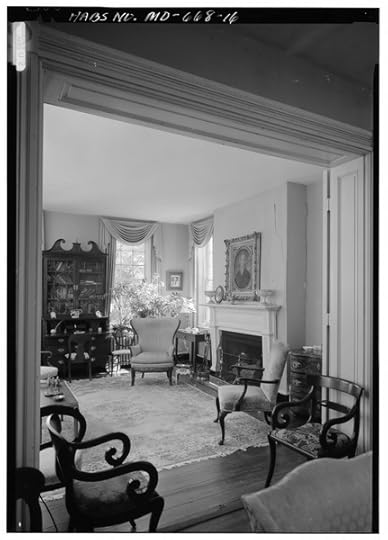 A Greek Reviva parlor.
A Greek Reviva parlor.Greek Revival houses abound in the West Village, often built by middle-class citizens in the 1830s as they fled the yellow-fever epidemics that recurred every summer in the lower wards of the city, and the cholera outbreak of 1832. I like brownstones too, more ornate and imposing, with their high front stoops and ornamental moldings – a different experience from the simplicity of the Greek Revival style. (See post #145, New York Brownstones, Sept. 21, 2014.) All these old houses are, for me, among the top wonders of the West Village, for wonders can come in small sizes. They have charm and character, precisely the qualities that I find lacking in the massive brick apartment buildings that so often hem them in.
Wonders of a different kind are several huge buildings that loom up here and there in the West Village. They aren’t aesthetically pleasing, but they have undergone wondrous changes and for that reason alone are of interest. Here I’ll deal with just one of them, the Archive Building, a ten-story red-brick colossus that occupies a whole block between Christopher and Barrow Streets, and between Greenwich and Washington, a short distance from the Hudson River. I’ve walked past it for years, wondering vaguely what this big, squat mass – the biggest in the Village -- was doing there, but never until now was I curious enough to find out, or even to learn its name and how it got it.
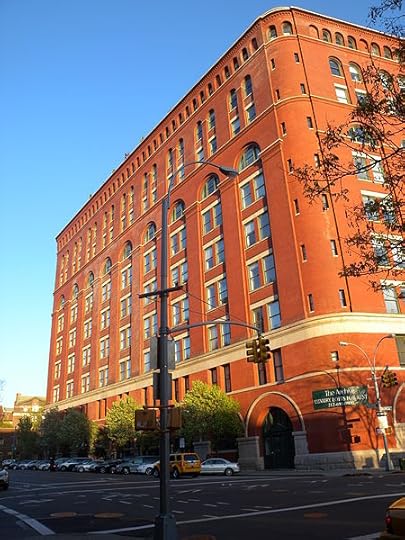 The Archive Building on Christopher Street.
The Archive Building on Christopher Street.Jim.henderson What today is known as the Archive Building was built in two stages between 1892 and 1899 in Romanesque Revival style, with round arches framing the first- and seventh-floor windows, rows of smaller arches at the top, wide brick support piers, and massive brick walls. Christened the U.S. Appraisers’ Warehouse, it provided space where customs agents could examine imported goods and set valuations and duties on them. Downtown real estate interests had wanted to put the warehouse at the foot of Manhattan, next to the Custom House, but merchants had argued for the present location, since many ships unloaded at the foot of Christopher Street and nearby piers.
But in time the income tax, first legislated in 1913, replaced customs duties as the chief source of the federal government’s income, and the building, renamed the U.S. Federal Building, became a general federal warehouse. Then in the 1930s it was remodeled into office space housing the National Archives Record Center, a post office, and other federal agencies. Recognizing the building’s historic significance, the city designated it a landmark in 1966.
By the early 1970s the federal offices were moving out, and the newly created New York Landmarks Conservancy, a nonprofit group promoting landmark preservation, intervened to save the building in a unique real estate deal that would open parts of the building to the public. Tortuous negotiations followed, leading to a complex deal in 1982 that provided money for the Landmarks Conservancy’s Historic Properties Fund, low-cost space for community arts and social service agencies, and funds for local Village groups. The developer received real-estate tax reductions, and in exchange promised to give tenants rent-stabilization benefits as long as the reductions lasted.
Six years of renovation followed, resulting in spacious apartments under high ceilings, some with views of the Hudson or the gardens of the Episcopal church St. Luke in the Fields, and some facing onto a newly created quiet inner courtyard. Students, young Wall Street professionals, artists, models, photographers, and fashion designers moved in, attracted by the loftlike apartments and stabilized rents. (One noteworthy tenant of later years was Monica Lewinsky of Clinton White House notoriety, but the less said about her the better.)
In 2003 the tenants learned that, under the terms of the complex deal of 1982, their rent-stabilization status was due to expire, and they faced staggering rent increases if they chose to remain in their apartments. Anxiety reigned, and complaints surfaced about dry rot in the hallways and beetle infestations. Some paid and stayed, some with great regret moved out, and some went to court, hoping to obtain a final two-year stabilized lease before getting a monthly rent increase of $1,000 or more. The ensuing legal brouhaha was probably as confusing to those involved as it is to me now, since so many parties were involved, each intent on obtaining the best deal possible: the developer, the old tenants, the new tenants, the city, and the landmark preservationists.
And what is the Archive Building today? Courtesy of Rockrose Development Corporation, luxury housing with 479 apartments, a concierge and a doorman, a garage, a roof deck, laundries on every floor, and a fitness center. Sound familiar? You bet! The building itself, I confess, has a certain staid dignity that I am beginning to discern. But studios there go for $4,450 a month, and one-bedroom apartments for $6,300. Obviously, the legal brouhaha did not, in the long run, prevent the developer from hoisting rents up to current market rates. Another luxury housing development: just what the Village needs.
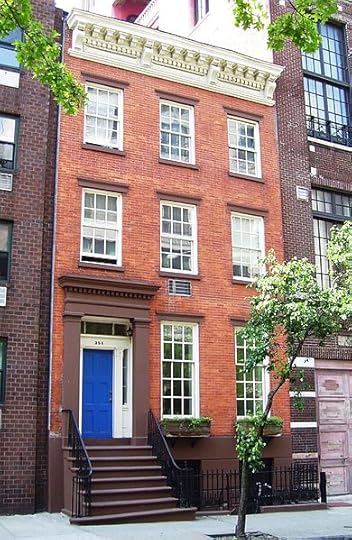 354 West 11th Street.
354 West 11th Street.Beyond My Ken In a previous post (#184) on architectural cast iron and terra cotta, I cheated a little, in that I included a photo of a Greek Revival house that was indeed on 11th Street, but not on the stretch covered in that post, which ran from Seventh Avenue east to Broadway. The house in question is the one at 354 West 11th Street, on West 11th Street between Washington and West Streets, on a stretch of West 11th Street that I have walked many a time, going to and from the Hudson River waterfront. It is a charming little house, sandwiched in between taller and more modern buildings on either side. Information from the Greenwich Village Society for Historic Preservation (GVSHP), which will figure prominently in this story, tells me that the house was built as a residence in 1844 (rather late for a Greek Revival house), that in 1871 it was extended 11 feet in the rear, and that today it stands as an almost entirely intact Greek Revival townhouse. Significantly, it was landmarked in 2007.
Well and good, but what concerns me now is its neighbor immediately to the west at 356-360 West 11thStreet. Some years back I told in this blog of spotting a scurrying mouse on West 11th Street and following it to see where it was going. With me following discreetly, it crossed 11th Street and vanished under the door of a garage whose vast shadowy interior I could glimpse from the sidewalk. When one of the garage employees appeared, I told him of the mouse’s invasion, and he was gently amused. And that is the end of this trivial tale, which I tell here now only to show how, focused on the mouse, I noticed only the ground floor of the building, a shabby enough exterior composed of garage doors flanked by brickwork with the cheery warnings NO PARKING and YOUR CAR WILL BE TOWED. So I was completely unaware of what loomed above, and what loomed above is the subject of this story.
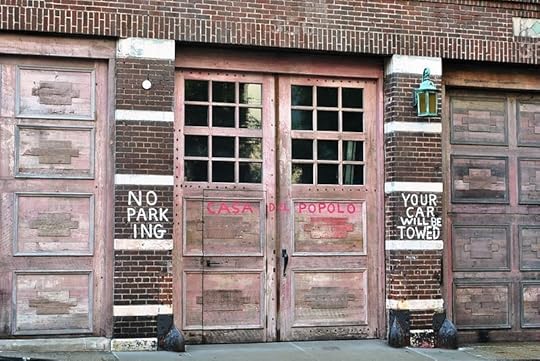 The graffito "Casa del Popolo" (House of the People) is a recent addition, still in evidence today.
The graffito "Casa del Popolo" (House of the People) is a recent addition, still in evidence today.Elisa.rolle First, a bit of background, courtesy again of GVSHP. The structure at 356-360 West 11th Street was originally a three-story brick building built in 1915 by a trucking company for use as a stable. In 1919 it was converted to a garage with storage space, and in 1961 it was altered to a lab and office space, and then – sometime before 2006 – it became an artist’s studio: an evolution that reflects the gentrification of the neighborhood. But that’s only the beginning of the story.
On my frequent walks west along 11thStreet toward the river I would often see people straining their necks looking upward, I wasn’t quite sure at what. Finally, out of curiosity, I did the same and for the first time really focused on the superstructure of 356-360 West 11th Street. This was no longer a plain three-story brick building, for above it was an eleven-story addition, a soaring stuccoed monster of a palace with loggias and balconies and terraces and round-arched windows, its façade receding in stages toward the top, all of it vaguely and brazenly Italianate, saying which I mean no insult to Italy and its architects, who are in no way responsible for this outlandish palazzo, the creation of some crazed American developer who had no regard for the West Village setting it so violates.
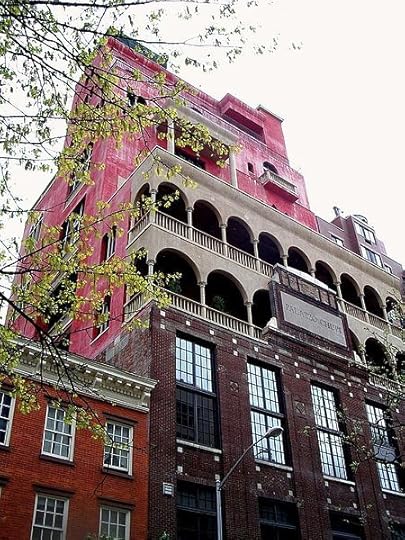 Palazzo Chupi, still Pepto Bismol pink.
Palazzo Chupi, still Pepto Bismol pink.Punxatawneyphil
 Julian Schnabel in 2010.
Julian Schnabel in 2010.Julian Schnabel The name of this atrocity? Palazzo Chupi. And the perpetrator? Julian Schnabel, whom I had never heard of. Quick recourse to Wikipedia, that conglomeration of real and false facts, informed me that Mr. Schnabel is a renowned American artist and filmmaker, born in Flatbush, the recipient of numerous awards, whose obvious financial success permits him this colossal indulgence. Photographs reveal a stocky man now in his fifties with a fierce black mustache and a graying beard: a Renaissance man of many talents who dreams big and wants to live and build big.
In 1997 Schnabel purchased this building for $2.1 million and moved his family in. Then, in September 2005 -- a date that will live in infamy – he began construction of his dreamed-of palazzo, work that went on for a good (or bad) two years. The original three floors now serve as his studio, with grandiose space for grandiose visions, and in the basement a grandiose swimming pool. On the upper floors, whose trendy Italianate superstructure overtops every other building in the area, are five lavish units, one for his family (a second wife and twin teen-age sons) with bold black-and-white tile floors and super modern furnishings with vibrant colors, and four other units that he meant to rent out. He bought the building, he says, “because I wanted more space, and because I thought I could sell two or three apartments to pay for that space, and I built it because I could.”
But what does the name mean: Palazzo Chupi? Palazzo is clear enough, but Chupi? Rampant speculation resulted -- it means “kisses” in Italian, and “underpants” in Swahili – but it seems that “chupi” is a pet name for his wife.
Okay, but how could he get away with this oddity in the Greenwich Village Historic District? “Because I could.” The historic district stops at Washington Street, just short of the palazzo’s site. GVSHP had worked hard to get the historic district extended all the way to West Street and the river, but had to be contented with progress that fell short of that. The city agreed to downzone much of the Far West Village in 2005, limiting the height of all new construction, but according to Schnabel’s neighbors, who protested his plans the moment they learned of them, he had his workers doing illegal construction after hours and on weekends so as to get the project approved before the new rules went into effect. He gambled and won, for the city allowed him to build under the old, looser zoning rules, rather than the new rules just enacted.
Wondering what “Chupi” meant, in 2007 the Villager, a local weekly, asked Andrew Berman, executive director of GVSHP, for his rendering. “I have no idea what ‘chupi’ means,” he replied, “unless it means ‘big, ugly building that never should have been built.’ He’s obviously trying to pretend that this looks somehow Florentine or Venetian, when, really, it looks like a Malibu Barbie house that exploded or something.” Some critics found the palazzo exciting or at least different – no clunky big glass box, like all those Upper East Side monsters -- but GVSHP, dedicated to preserving old buildings of value and preventing new monstrosities, is ruthlessly critical.
One further detail: when the black construction netting was removed in June 2007, the newly renovated building was revealed in all its glory as being, of all colors, pink. I don’t mean soft feminine pink; I mean bright, vibrant, garish bubblegum pink. Or “hot pink,” as some detractors labeled it, or ”neon pink,” or “Pepto Bismol pink.” “Pompeii red,” insisted Schnabel. But for me, pink like I didn’t know pink could be. Only with time – about four years of it -- did its weathered features fade slightly to a more acceptable “dusty Venetian rose.” For this at least, we should be grateful. Or as one commentator put it, “Paler pinks make better neighbors.”
Not that the preservationists and their allies have given up. Never has a development been subject to more tweaks and Twitters. For if Schnabel managed to wiggle past the rules, his ensuing travails have been chronicled on the real-estate blog Curbed with vast irreverence and unbounded glee.
And travails there have been. Mr. Schnabel's main problem was simply bad timing: he bought the building and “chupified” it at the peak of the real estate boom, and the bubble soon burst, convulsing not just the real estate market but the whole financial community and the economy as well. Two of the four units sold fairly quickly, one to William Brady, a managing director of Credit Suisse, for $15 million, and another for $12 million to the actor Richard Gere, who then tried to “flip” it: that is, rather than moving in, he put it back on the market in hopes of making a quick profit by reselling it. But Mr. Gere’s apartment didn’t flip, and when lowering the asking price didn’t help, he took it off the market.
Meanwhile the top two units likewise found no buyers, despite their 18-foot ceilings, baronial bathrooms with wood-burning fireplaces, paintings and sculpture by none other than Mr. Schnabel, and unobstructed views of the Hudson River and distant New Jersey. After being on the market for months, the penthouse triplex (5 floors, 3713 square feet) was bought by William Brady, already the owner of one unit, for $10.5 million, down a wee bit from the original asking price of $32 million, leaving the duplex below it (3963 square feet) on the eighth and nine floors, which finally went for $12 million, likewise a bit of a comedown from $27 million. Was the pink palazzo becoming a white elephant? In 2009 Schnabel had to pluck his late Picasso, “Femme au Chapeau,” off his bedroom wall and sell it at Christie’s for $7.7 million, in an effort to pay down some of the debts created by the construction of his palazzo.
“An unholy shrine to Schnabel’s ego,” one commentator grants, but better, he insists, than the glass boxes sprouting up all over the city like a bad virus. Certainly it is the big dream of a big man, no pale imitation of someone else’s fantasy. Maybe Schnabel really is a Renaissance man of our own age, bigger than life, whom we’ll all come to appreciate. Maybe he would endorse the words now posted on the front window of one of the designer clothing stores just down Bleecker Street from my building: “Les folies sont les seules choses qu’on ne regrette jamais” (Follies are the only things one never regrets – Oscar Wilde). But from the corner of Bleecker and West 11th, just across from my building, I can see his pink tower high above the other rooftops, and it pains my psyche. For me today, his pink palazzo is a horror.
A further thought: I wonder how the residents of 356-360 West 11th Street fared during Hurricane Sandy. Westbeth was flooded and lost power for days. Penthouse living might not be so attractive under those dire circumstances.
Given my predilection for Greek Revival houses, and my perennial dismay at the loss of the old Penn Central, I could well be accused of clinging to an outdated classicism, of being out of tune with the times, a charge that I deny. Not everything startlingly new offends me (as long as it isn’t pink). If in the West Village I’m a fervent preservationist, in Midtown and the Upper West Side I’m on the side of innovation and the fire of genius, of which we seem to be in short supply. I could do without the clunky glass-box high-rises that clutter up those parts of the city today, but I have room for the boldly new, if it dazzles and astonishes. If any of these new high-rises towering up all over Manhattan show a different play of light and shadow, or a different color, depending on the angle they are viewed from, and on the time of day, that would be fascinating. And if any of them, spiking a tapering glass summit upward, should end in a shimmering pinnacle of light, that would be sublime.
 53 West 53rd Street, a promotional photo.
53 West 53rd Street, a promotional photo.World-renowned French architect Jean Nouvel’s slender needle of a high-rise, the Tower Verre, now under construction at 45 West 53rd Street, adjacent to the Museum of Modern Art, just might do the trick, even though the New York City Planning Commission lopped 200 feet off the tower as initially proposed. Whether it bears the magical name Tower Verre (Glass Tower) or the utterly prosaic “53 West 53” that has now superseded it, is of secondary importance. M. Nouvel has already startled us with his 23-story residential tower at 100 Eleventh Avenue, on the corner of West 19th Street in Chelsea, a “Vision Machine” facing the Hudson River. Its south and west façade is described as a “pixilated curtain wall” inspired by an insect’s compound eye and capturing light and reflecting it back to the city – a novel feature such as I have never seen before. Admittedly, the structure’s massive curved façade with 1,647 windowpanes of different sizes may take some getting used to, and I regret to report that a penthouse there has sold for $19.4 million, but regardless of that, the building is different, unique. And if some residents complain of shoddy construction, lobby leaks, and cracking concrete due to cost-cutting, those are the developer’s doing, not Nouvel’s; he in fact sides publicly with the complainers.
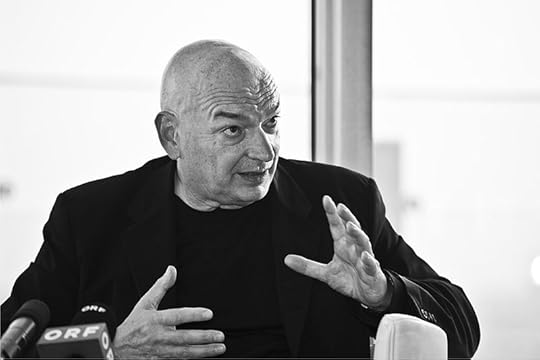 Jean Nouvel in 2009. A wonder worker.
Jean Nouvel in 2009. A wonder worker.Jean Nouvel (“Pixilated,” derived from “pixie,” a mischievous sprite of legend, is defined by Merriam-Webster as meaning “somewhat mentally unbalanced,” “bemused,” “whimsical.” But “pixelated,” sometimes spelled “pixilated,” is a technical term having nothing to do with pixies and meaning “to break up into pixels,” a pixel being the smallest component of a digital image, often rendered as a tiny square. If at this point you’re confused, so am I, for I’m more at ease with mischievous sprites than digital images. But if you look at a photo of the building’s façade, you’ll begin to get the point.)
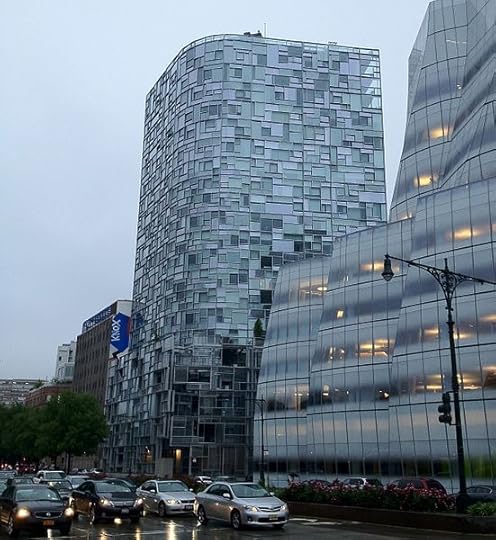 100 Eleventh Avenue, the south and west façade.
100 Eleventh Avenue, the south and west façade.DFranck
Clearly, M. Nouvel is a genius. The Planning Commission’s meddling with his concept reminds me of Ayn Rand’s short novel The Fountainhead (short for her, in my paperback edition a mere 694 pages), in which a brilliant young architect’s career is stymied at every turn by the massed mediocrity of his architectural peers, whose concepts are rooted in the past, until he finally triumphs. So what if M. Nouvel’s dazzling tower, as originally conceived, would have matched the Empire State Building in height and cast a shadow, a very slender shadow, on Central Park? Those timorous bureaucrats should have let him do what he proposed. Still, we’re lucky to have his project on any terms in the desolate architectural wasteland of Midtown. And so, using the words of impresario Sergei Diaghilev to the young Jean Cocteau, I say to M. Nouvel, or to whoever now is in charge of the nascent Tower Verre, émerveille-moi! Do me wonders!
Our strange sexual mores: I’ve just learned that a young man in Indiana, age 19, has had to serve 90 days in jail and probation for having had consensual sex in Michigan with a girl he thought was 17, a year over the Michigan age of consent, but who was in fact 14. Furthermore, he will probably be listed on a sex offender registry and have the label “pedophile” pinned to him for life, with all the onerous restrictions that involves. This is insane and obscene, for the boy is obviously no pedophile. Much of what I say in my much-visited post #43, “Man/Boy Love: the Great Taboo” (January 20, 2013), applies to heterosexual relations as well. Consensual sex at any age should not be a concern of the criminal justice system, which is clumsy, heavy-handed, obtuse. Our seemingly permissive society is obsessed with sex, glorifies it, then punishes those who engage in it. When, oh when, will we grow up? When will we show at least a modicum of understanding and common sense, when it comes to sex? I can only hope that this case, well publicized, will lead to at least an intelligent discussion and maybe, just maybe, a little bit of reform.
As for post #43 on man/boy love, it still attracts more viewers than any other post to date. But it has cost me something, for the self-publishing press now working on my collection of posts from the blog has asked me to either delete it as a chapter of the book, or retain it but publish the book under my own imprint, rather than theirs. The problem? Fears of possible legal problems. Not wanting to create an almost fictional press of my own, I’ve opted, with great regret, to delete the chapter. And some time ago, when I offered to promote on the blog a book published by a friend, she declined, explaining ever so tactfully that she didn’t want her book linked in any way to a blog containing a post sympathetic to consensual man/boy love. So if sex is alive and well in our fair land, so is suspicion of it, and a preference to avoid certain aspects of it that might – shhhh! – get one in trouble.
Coming soon: The Need to Kill: bugs, shotguns, rage, Einstein on wonder, and how I flip and flop.
© 2015 Clifford Browder
Published on July 12, 2015 04:49



